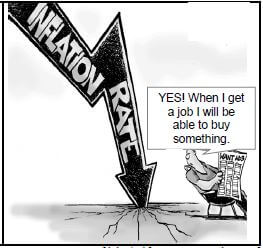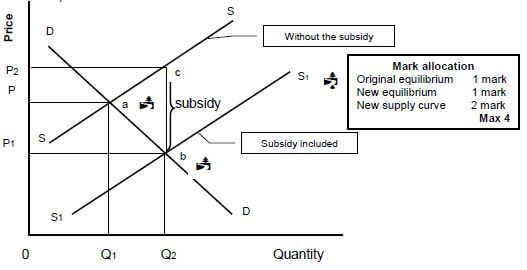Adele
ENGLISH HOME LANGUAGE PAPER 1 GRADE 12 MEMORANDUM - NSC EXAMS PAST PAPERS AND MEMOS NOVEMBER 2018
ENGLISH HOME LANGUAGE
PAPER 1
GRADE 12
NSC EXAMS
PAST PAPERS AND MEMOS NOVEMBER 2018
NOTE:
|
INSTRUCTIONS TO MARKERS
Marking the comprehension:
- Because the focus is on understanding, incorrect spelling and language errors in longer responses should not be penalised unless such errors change the meaning/understanding. (Errors must still be indicated.)
- If a candidate uses words from a language other than the one being examined, disregard those words, and if the answer still makes sense, do not penalise. However, if a word from another language is used in a text and required in an answer, this will be acceptable.
- For open-ended questions, no marks should be awarded for YES/NO or I AGREE/I DISAGREE. The reason/substantiation/motivation is what should be considered.
- No marks should be awarded for TRUE/FALSE or FACT/OPINION. The reason/substantiation/motivation is what should be considered.
- When one-word answers are required and the candidate gives a whole sentence, mark correct provided that the correct word is underlined/highlighted.
- When two/three facts/points are required and a range is given, mark only the first two/three.
- Accept dialectal variations.
- For multiple-choice questions, accept BOTH the letter corresponding to the correct answer AND/OR the answer written out in full.
MEMORANDUM
SECTION A: COMPREHENSION
QUESTION 1: READING FOR MEANING AND UNDERSTANDING
1.1 He is disgusted by/pities the flashy/obscene displays of wealth by spoilt teenagers.
[Award only 1 mark for ‘lifting’.] (2)
1.2 The possessions seem to own the person, who has been 'dwarfed'; the youth have become less human, 'dehumanised' by their possessions, as ownership has been reversed.
[Award 2 marks for any TWO ideas.] (2)
1.3 It is ironic that while these young people intend flaunting their abundant possessions, they actually reveal how empty their lives are. (2)
1.4 The writer wishes to provide convincing evidence to support his view/to validate his argument. (2)
1.5 A negative connotation is attached to the word 'consumers', who are viewed as those who purchase goods without discernment. They are self-absorbed individuals ('more competitive and more selfish') who do not engage with others and lack 'social responsibility'. 'Citizens' carries a positive connotation; they would be discerning and add value to society.
[Award 3 marks only if both concepts have been addressed.] (3)
1.6 The research findings are contrary to what people generally believe: materialism is associated with happiness. In fact, materialism is shown to be the enemy of fulfilment./It is paradoxical that people turn to consumerism to fill their loneliness yet this consumerism makes them more lonely and isolated./Paradoxically, a consumer journal publishes negative viewpoints on consumerism.
[Award 3 marks only if the paradox is well-discussed.]
[Award only 1 mark for ‘lifting’.] (3)
1.7 The writer uses various stylistic techniques to strengthen his argument that materialism gives rise to a cycle of destruction.
- The writer uses metaphorical expressions/hyperbole such as 'self mutilation' and 'smashed' to highlight the destructive nature of an obsession with possessions.
- The satirical remark, 'a Rolex short of contentment', graphically illustrates the insatiable nature of materialism.
- The writer inserts a short exclamation 'There is no end to it!' to emphasise his exasperation with endless consumerism.
- Strong emotive words, e.g. 'distressed', 'forces' and 'smashes' effectively convey a sense of destruction.
- Conversational style/use of personal pronouns creates a bond of confidence between the writer and the reader.
[Award 3 marks for any TWO techniques well-discussed.]
[Award a maximum of 1 mark for an identification of TWO techniques.] [Credit valid alternative responses.] (3)
1.8 YES
The writer summarises the adverse impact of materialism, by referring to his initial image of 'deluded' youth, and expanding his focus to broader society. The reader is drawn into the argument through the use of first person pronouns. The writer contends that every member of society falls prey to the destructive cycle of materialism.
OR
NO
[A 'NO' response is unlikely. However, credit responses on merit.]
[Credit valid alternative responses.] (3)
1.9 The viewer on the left is disgusted by what he is viewing: he views the characters in the film as shameful criminals. He embodies the morally correct reaction to what he is viewing. The viewer on the right is enthusiastic and engaged, showing how susceptible he is to a lavish lifestyle.
[Award 3 marks only if attitudes of both characters are discussed.]
[Credit valid alternative responses.] (3)
1.10 The cartoonist is critical of the public's gullibility and lack of discernment. Some of the people are satirically portrayed as being devoid of the ability to think critically. The film industry has undue influence on social conscience.
[Award 3 marks only if a critical discussion is included.]
[Credit valid alternative responses.] (3)
1.11 Text B portrays the manner in which our morals are compromised by the created images of materialism. The opulent lifestyle of villains is seen as desirable. The headline of Text A refers to the effect of a materialistic society: moral decay erodes our humanity via the imagination ('eats us from the inside out'). The possessions idolised by the Rich Kids of Instagram are similar to the desired lifestyle depicted in Text B. In both texts, materialism is acceptable when it is glamorised. Both the writer and the cartoonist disapprove of our mindless acceptance of materialism.
[Award 4 marks only if both paragraph 1 of Text A and Text B are discussed.] [Credit valid alternative responses.] (4)
TOTAL SECTION A: 30
SECTION B: SUMMARY
QUESTION 2: SUMMARISING IN YOUR OWN WORDS
Use the following main points that the candidate should include in the summary as a guideline.
Any 7 valid points are to be credited in paragraph-form.
(Sentences and/or sentence fragments must be coherent.)
NO. | QUOTATIONS | NO. | POINTS |
1 | 'When we read comics featuring superheroes, particularly as children, we develop our ... reading ability' | 1 | While reading about superheroes, children develop reading skills. |
2 | 'These comics likely influence our behaviour, ... and attitudes.' | 2 | Their behaviour and outlook on life are influenced. |
3 | 'Pretend play based on the concept of superheroes helps children learn language’ | 3 | Children acquire language competence through participating in imaginary games. |
4 | ‘we develop our emotions’/’allows the expression of emotions, both negative and positive.' | 4 | Youngsters pretending to be superheroes learn to verbalise all emotions. |
5 | 'Children can use superheroes and supervillains to form various perspectives on a situation and test the consequences of actions.' | 5 | Children learn from superheroes how to weigh up situations and think before they act. |
6 | ‘we develop our ... morals’/'provide the exaggerated opportunity to play out moralistic and ethical dilemmas for both children and adults.'/'use their moral compass, so to speak, before making big decisions.' | 6 | Children can role-play in larger-than-life scenarios to discern right from wrong. |
7 | 'superheroes likely feed straight into boys' tendency to control or "master" the world.' | 7 | Boys gain confidence in taking control of circumstances. |
8 | 'children are given the opportunity to observe how their favourite role model problem-solves through ethically sticky situations.' | 8 | They can witness how superheroes extricate themselves from daunting circumstances./Children learn to make difficult decisions. |
9 | ‘These comics likely influence our ... leadership ability’/'Teenagers use villains as avoidance role models, while imitating superheroes who display pro-social behaviour, leadership and a variety of positive attitudes.' | 9 | Superheroes who display socially acceptable behaviour and integrity are good role-models for children |
10 | ‘unwillingness to be a bystander’/'it could be argued that learning to help others occurs through the models of superheroes.' | 10 | Altruism is reinforced by the example set by superheroes. |
PARAGRAPH-FORM
NOTE: What follows is merely an example. It is not prescriptive and must be used very carefully.
Children develop reading skills, emotional intelligence and principles when they read about superheroes: their behaviour, leadership skills and outlook are influenced. Furthermore, youngsters imitating superheroes learn to verbalise a range of feelings. Children learn from superheroes and supervillains how to weigh up situations before acting. Moreover, children can role-play in larger-than-life scenarios to discern right from wrong and gain confidence in taking control of circumstances. They can witness the manner in which superheroes extricate themselves from daunting circumstances. In conclusion, superheroes with integrity are good role-models and reinforce altruism. (89 words) |
Marking the summary:
Marking is on the basis of the inclusion of valid material and the exclusion of invalid material.
The summary should be marked as follows:
- Mark allocation:
- 7 marks for 7 points (1 mark per main point)
- 3 marks for language
- Total marks: 10
- Distribution of language marks when candidate has not quoted verbatim:
- 1–3 points correct: award 1 mark
- 4–5 points correct: award 2 marks
- 6–7 points correct: award 3 marks
- Distribution of language marks when candidate has quoted verbatim:
- 6–7 quotations: award no language mark
- 1–5 quotations: award 1 language mark
NOTE:
- Word Count:
- Markers are required to verify the number of words used.
- Do not deduct any marks if the candidate fails to indicate the number of words used or if the number of words used is indicated incorrectly. If the word limit is exceeded, read up to the last sentence above the stipulated upper limit and ignore the rest of the summary.
TOTAL SECTION B: 10
SECTION C: LANGUAGE STRUCTURES AND CONVENTIONS
Marking Section C:
- Spelling:
- One-word answers must be marked correct even if the spelling is incorrect, unless the error changes the meaning of the word.
- In full-sentence answers, incorrect spelling should be penalised if the error is in the language structure being tested.
- Where an abbreviation is tested, the answer must be punctuated correctly.
- Sentence structures must be grammatically correct and given in full sentences/as per instruction.
- For multiple-choice questions, accept BOTH the letter corresponding to the correct answer AND/OR the answer written out in full as correct.
QUESTION 3: ANALYSING ADVERTISING
3.1 The advertiser is addressing the need for this generation to conserve energy so that the next generation can continue to experience the benefits of electricity./The advertiser is warning of impending doom if the current wasteful practices continue. (2)
3.2 The repetition of the pronouns drives the point home that the company and the readers are jointly responsible for the solution. The personal pronouns convey a direct, personal appeal to the reader. (1) (2)
3.3 The image portrays a young child, snugly reading a book in bed. This is in sharp contrast to the text, which comments on Shell's activities in the Arctic as a 'nightmare'. In the context of the advertisement, the image conveys a false sense of security regarding children's future in the light of Shell's activities in search of oil. The décor in the room depicts nature and threatened species, while the light connotes elucidation of a serious issue.
[Award 3 marks for a well-developed response.]
[Credit valid alternative responses.] (3)
3.4 Text D is more informative/inspirational: it provides details that illustrate the company's social conscience. The advertisement elaborates on the company's attempts to preserve energy for future use and points out that global co-operation has been achieved. The domestic setting shows a personal concern. The blurred image reinforces the fear that the future will be bleak if we fail to harness all possible sources of renewable energy.
Text E is more cautionary and emotive, e.g. 'STUFF OF NIGHTMARES'. Greenpeace satirises Shell's approach and critically comments on Shell's practices in the Arctic, endangering nature. Greenpeace has mimicked and presented a parody of the Shell visual.
[Award 3 marks only if both texts are discussed.] (3) [10]
QUESTION 4: UNDERSTANDING OTHER ASPECTS OF THE MEDIA
4.1 The boy is concentrating on his drawing./The reader is invited into his thought processes./It forces the reader to focus on the boy.
[Award 2 marks for any single idea.]
[Credit valid alternative responses.] (2)
4.2 In FRAME 4, the boy outlines the reason for his drawing willingly/in a matter of-fact manner. In FRAME 7, his response is hesitant and evasive/reluctant.
[Credit answers that view responses as similar, since the boy is evasive in both frames, e.g. his reference to 'SOMEONE IN OUR FAMILY' in FRAME 4.]
[Award 2 marks only if candidates refer to both frames.] (2)
4.3
- In FRAMES 7, 8 and 9, the girl's stern, domineering attitude is depicted through her scowl, pursed lips and clenched jaw. Her facial expression remains angry throughout.
- In FRAME 8, the positioning of the two characters portray the girl’s overbearing nature. She is menacingly close to her brother, intimidating him.
- In FRAMES 8 and 9, the absence of speech bubbles emphasises her pent-up rage.
- In FRAME 9, the large bold font/onomatopoeia/exclamation mark/body language/movement lines highlight the girl's aggression. She has literally overthrown her brother.
[Award 3 marks for TWO techniques, well-developed.]
[Award no more than 1 mark for an identification of TWO techniques.] (3)
4.4 The cartoonist has given prominence to/creates an interest in the ultimate message of the cartoon by placing it first/inverting the order of the frames, effectively highlighting the price to be paid for truth. FRAME 1 is the consequence of the events in the cartoon. It precedes the flashback that commences in FRAME 2. The boy is depicted as a victim of violence, illustrated by the ice-pack on his head/sling on his arm/plasters on his face.
[Credit candidates who refer to the boy's artwork being reduced to snippets/recreated.]
[Award 3 marks only if a critical comment is made.] (3) [10]
QUESTION 5: USING LANGUAGE CORRECTLY
5.1
- ; (semi-colon)
OR
: (colon) (1)
5.2
- I was overwhelmed.
[Accept valid alternatives.]
[Formal standard English must be used. Past tense must be used.] (1)
5.3
- He was taken hostage for almost five years, most of which he spent in isolation, chained, with no stimulation – not even natural light.
OR
He spent almost five years in isolation, chained, with no stimulation – not even natural light – after/when he had been taken hostage.
OR
After/When he had been taken hostage, he spent almost five years in isolation, chained, with no stimulation – not even natural light.
[Credit valid alternative responses.] (1)
5.4
- He laughed because he had no shoes on when he was released./ Conjunction 'as' indicates reason.
OR
He laughed while he was being released./Conjunction 'as' indicates time.
[Credit responses that make reference to the ambiguity created by the pronoun, ‘he’.] (2)
5.5
- Waite said (that) he had no regrets, self-pity or sentimentality./Waite said (that) he did not have any regrets, self-pity or sentimentality./Waite said (that) there should be no regrets, no self-pity, no sentimentality.
[No part-marks to be awarded; the full response must be correct.] (1)
5.6 C – Abstract noun (1)
5.7 causes – cause (1)
5.8 infers – confers
[Credit valid synonyms for ‘confers’.] (1)
5.9 Either 'indifferently' or 'apathetic' must be omitted. (1) [10]
TOTAL SECTION C: 30
GRAND TOTAL: 70
DRAMATIC ARTS GRADE 12 QUESTIONS - NSC EXAMS PAST PAPERS AND MEMOS NOVEMBER 2018
DRAMATIC ARTS
GRADE 12
NSC EXAMS
PAST PAPERS AND MEMOS NOVEMBER 2018
INSTRUCTIONS AND INFORMATION
- This question paper consists of FOUR sections:
SECTION A: 20th Century Theatre Movements (30)
SECTION B: South African Theatre: 1960–1994 (40)
SECTION C: South African Theatre: Post-1994–Contemporary (40)
SECTION D: The History of Theatre, Practical Concepts, Content and Skills (40) - SECTION A
QUESTION 1 is COMPULSORY.
Refer to the play text you have studied and the relevant 20th Century Theatre Movement.
EPIC THEATRE- Caucasian Chalk Circle Bertolt Brecht
- Kaukasiese Krytsirkel Translation of Bertolt Brecht play text
- Mother Courage Bertolt Brecht
- Moeder Courage Translation of Bertolt Brecht play text
- The Good Person of Szechwan Bertolt Brecht
- Kanna Hy Kô Hystoe Adam Small
OR
THEATRE OF THE ABSURD - Waiting for Godot Samuel Beckett
- Afspraak met Godot Translation of Samuel Beckett play text
- Bagasie André P Brink
- The Bald Primadonna Eugene Ionesco
- Die Kaalkop Primadonna Translation of Eugene Ionesco play text
OR
POSTMODERN THEATRE - Skrapnel Willem Anker
- Top Girls Carol Churchill
- Popcorn Ben Elton
- Buried Child Sam Shepard
- SECTION B
This section consists of THREE questions. Answer only ONE question in this section.
QUESTION 2: Woza Albert! Percy Mtwa, Mbongeni Ngema and Barney Simon
OR
QUESTION 3: Sophiatown Junction Avenue Theatre Company OR QUESTION 4: Siener in die Suburbs PG du Plessis - SECTION C
This section consists of THREE questions. Answer only ONE question in this section.
QUESTION 5: Nothing but the Truth John Kani OR
QUESTION 6: Groundswell Ian Bruce OR
QUESTION 7: Missing Reza de Wet - SECTION D
This section consists of ONE question (QUESTION 8) which is COMPULSORY.
QUESTIONS
SECTION A: 20th CENTURY THEATRE MOVEMENTS
This section is COMPULSORY.
QUESTION 1
Study SOURCE A below and answer the question that follows.
SOURCE A 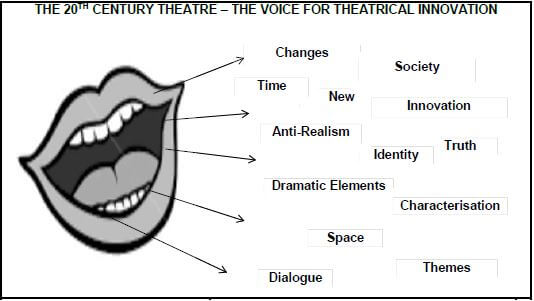
Evaluate, in an essay, how the play and the 20th Century Theatre Movement that you studied this year voices (expresses) innovation (originality) when reflecting on life and society of the time.
The content of your essay should refer to the question and include the following:
- Any dramatic elements contained in SOURCE A
- The play text you studied
- The 20th Century Theatre Movement you studied:
- Theatre of the Absurd OR Epic Theatre OR Postmodern Theatre
- Specific examples from the play text you studied
TOTAL SECTION A: 30
SECTION B: SOUTH AFRICAN THEATRE: 1960–1994
Answer only ONE question in this section.
QUESTION 2: WOZA ALBERT! BY PERCY MTWA, MBONGENI NGEMA AND BARNEY SIMON
Study SOURCE B below and answer the questions that follow.
SOURCE B 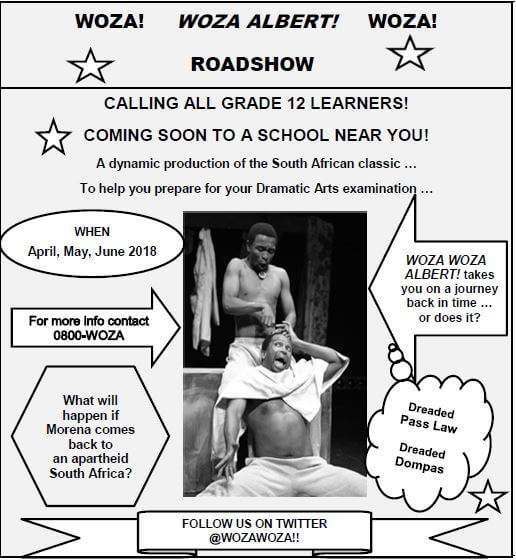
*Roadshow: a group of theatre performers who tour with their play and perform at various venues, often for the purpose of sharing information or educating a community
You and your class have decided to present selected scenes from the play Woza Albert! at local schools as part of a road show for Grade 12 learners. You have applied Grotowski's principles of Poor Theatre to your new production titled Woza Woza Albert!
2.1 State why the new title, Woza Woza Albert!, may be a good title for your road show production. (2)
2.2 Justify why you think your road show will be helpful to Grade 12 learners. (6)
2.3 Explain whether or not the poster in SOURCE B will promote the road show successfully. (4)
2.4 Analyse how the issues of the 'Dreaded Pass Law' and the 'Dreaded Dompas' are highlighted in the play. (6)
2.5 Discuss TWO possible difficulties you and your class may face when preparing to take your road show to other schools. (4)
2.6 Explain how the following principles of Grotowski's Poor Theatre may be applied to your road show:
- Set and props
- Actor-audience relationship (8)
2.7 Discuss how the idea of Morena coming back to an apartheid South Africa is central (important) to the creation and messages of Woza Albert!. (10) [40]
QUESTION 3: SOPHIATOWN BY THE JUNCTION AVENUE THEATRE COMPANY
Study SOURCE C below and answer the questions that follow.
SOURCE C 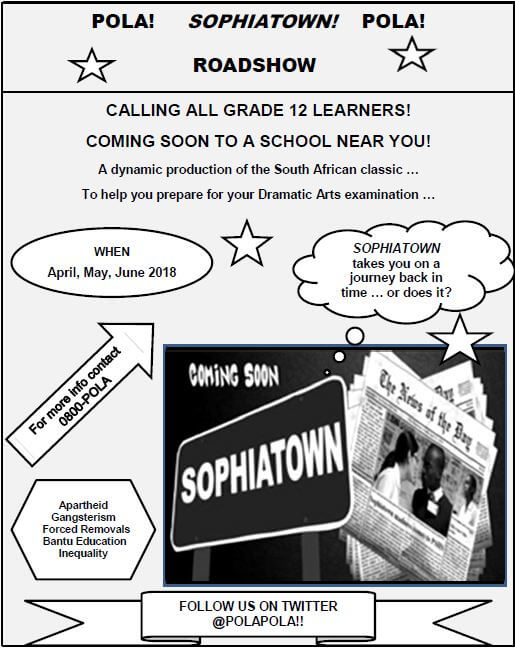
*Roadshow: a group of theatre performers who tour with their play and perform at various venues, often for the purpose of sharing information or educating a community
You and your class have decided to present selected scenes from the play Sophiatown at local schools as part of a road show for Grade 12 learners.
3.1 Suggest a suitable title for your production. Motivate your answer. (2)
3.2 Choose a scene from Sophiatown that the group may present.
3.2.1 Briefly explain what happens in the scene you have chosen. (4)
3.2.2 Describe a suitable costume for TWO of the characters in the scene you have chosen in QUESTION 3.2.1. (4)
3.2.3 Advise ONE character in the scene you have chosen on how to prepare for the vocal and physical demands of the role. (6)
3.3 SOURCE C contains ideas that you may use to advertise your road show.
3.3.1 Evaluate the statement, 'Sophiatown takes you on a journey back in time … or does it?', to show the play's relevance then and now. (6)
3.3.2 Motivate ONE other way you might choose to advertise the road show. (2)
3.4 Justify TWO other theatrical items that you might include in your production to reflect the Sophiatown of the 1950s. (6)
3.5 Refer to the information given in SOURCE C and evaluate how it reflects life in Sophiatown, the place, and Sophiatown, the play.
Include the following:
- Sociopolitical issues
- Themes (10) [40]
QUESTION 4: SIENER IN DIE SUBURBS BY PG DU PLESSIS
Study the SOURCE D below and answer the questions that follow.
SOURCE D 
*Roadshow: a group of theatre performers who tour with their play and perform at various venues, often for the purpose of sharing information or educating a community
You and your class have decided to present selected scenes from the play Siener in die Suburbs at local schools as part of a road show for Grade 12 learners.
4.1 Suggest a suitable title for your production. Motivate why you think it is suitable. (2)
4.2 Choose a scene from Siener in die Suburbs that the group might present.
4.2.1 Briefly explain what happens in the scene. (4)
4.2.2 Describe suitable costumes for TWO of the characters in the scene. (4)
4.2.3 Advise ONE character in the scene on how to prepare vocally and physically for this role. (6)
4.3 SOURCE D contains ideas that you might use for your advertising campaign.
4.3.1 Evaluate the statement, 'Siener in die Suburbs takes you on a journey back in time … or does it?', to show the play's relevance then and now. (6)
4.3.2 Suggest ONE other way you might choose to advertise your road show and motivate why you choose it. (2)
4.4 Explain the possible theatrical impact and audience reaction to the inclusion of a motorbike in your production. (6)
4.5 Evaluate, through an analysis of the characters and events in the text, how PG du Plessis represents 'ideas of love' in Siener in die Suburbs. (10) [40]
TOTAL SECTION B: 40
SECTION C: SOUTH AFRICAN THEATRE: POST-1994–CONTEMPORARY
Answer only ONE question in this section.
QUESTION 5: NOTHING BUT THE TRUTH BY JOHN KANI
Study SOURCE E below and answer the questions that follow.
SOURCE E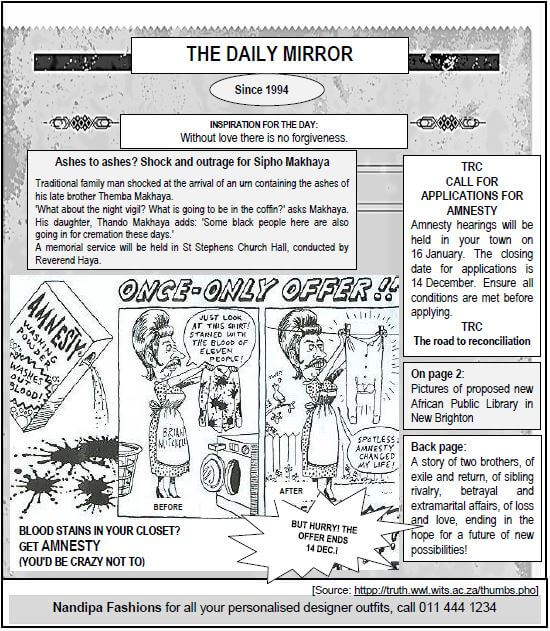
Read the front page of the local newspaper, The Daily Mirror, which relates to Nothing But The Truth and answer the questions that follow.
5.1
5.1.1 What does the abbreviation TRC stand for? (1)
5 1.2 Identify the character in Nothing But The Truth who works at the TRC. (1)
5.1.3 Explain the meaning of the term amnesty. (2)
5.1.4 Suggest why the name of the newspaper is suitable for this play. (3)
5.2 Give an example in the play text of a TRC case. (2)
5.3 Based on your understanding of the characters and situations in the play, would you consider making Nothing But The Truth a short TV series? Give reasons for your answer. (4)
5.4 Explain why Sipho Makhaya is shocked and angry that his late brother, Themba, has been cremated. (3)
5.5 Describe the system/method an actor playing Sipho might use to prepare for the emotional demands of his role. (6)
5.6 Evaluate how Nothing But The Truth reflects both Western and African cultures. (6)
5.7 Discuss how SOURCE E reflects the sociopolitical context, subject matter and themes of the play. (12) [40]
QUESTION 6: GROUNDSWELL BY IAN BRUCE
Study SOURCE F below and answer the questions that follow.
SOURCE F
Read the front page of the local newspaper, The West Coast Observer, which relates to Groundswell and then answer the questions that follow.
6.1
6.1.1 Suggest why the name of the newspaper is suitable by referring to the play text. (2)
6.1.2 Explain why Garnet Lodge is an effective setting for the play. (4)
6.1.3 Assess how the quote of the day in SOURCE F reflects the serious mood of the play. (4)
6.1.4 Motivate why Groundswell may be called a psychological drama by analysing the characters in the play and their relationships. (6)
6.1.5 Analyse how SOURCE F reflects the context and subject matter (content) of the play. (6)
6.2 Advise the actor who wants to play the role of Johan on how to portray the character realistically on stage. (6)
6.3 Evaluate the possibility that Johan, Thami and Smith may not be able to move forward with their lives and fulfil their dreams after the play has ended. Refer to specific examples in the play text to substantiate your answer. (12) [40]
QUESTION 7: MISSING BY REZA DE WET
Study SOURCE G below and answer the questions that follow.
SOURCE G 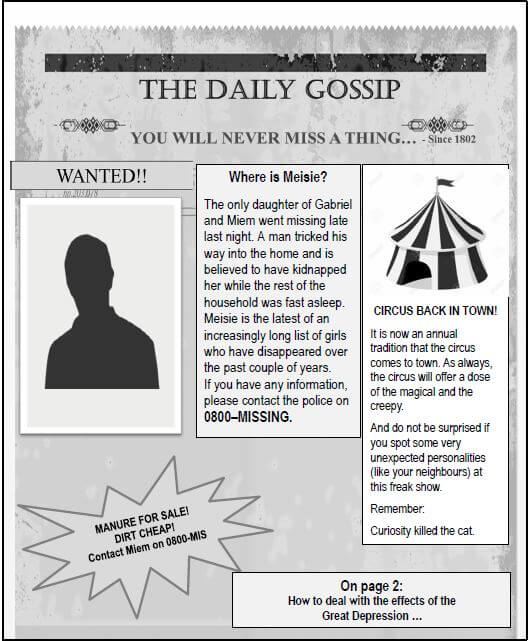
7.1 Read the front page of the local newspaper, The Daily Gossip, which relates to Missing and then answer the questions that follow.
7.1.1 Suggest why the name of the newspaper is a good choice by referring to the play text. (2)
7.1.2 Suggest a date you would add to the front page of the newspaper. (2)
7.1.3 Explain the different possible meanings of the title of the play. (4)
7.2 Write a character sketch of Constable, who may be 'wanted' for the kidnapping of Meisie, to assist The Daily Gossip with the correct information. (4)
7.3 Suggest why the women in the play allow a man, who is a total stranger, to enter the house. (4)
7.4 Advise an actor, who wants to play the role of Constable in the play, on how to portray the character on stage in a convincing manner. (6)
7.5 Explain how the effects of the Great Depression are highlighted in the play text as a whole. (4)
7.6 Name and motivate ONE other product that you could advertise in the newspaper. Do NOT use a product that is already mentioned in SOURCE G. (2)
7.7 Discuss the importance of the circus as the main symbol in the play. Refer to the following in your answer:
- Genre
- Mood and atmosphere
- Characters (12) [40]
TOTAL SECTION C: 40
SECTION D: THE HISTORY OF THEATRE, PRACTICAL CONCEPTS, CONTENT AND SKILLS
QUESTION 8 (COMPULSORY)
8.1 Study SOURCE H below and answer the questions that follow.
SOURCE H 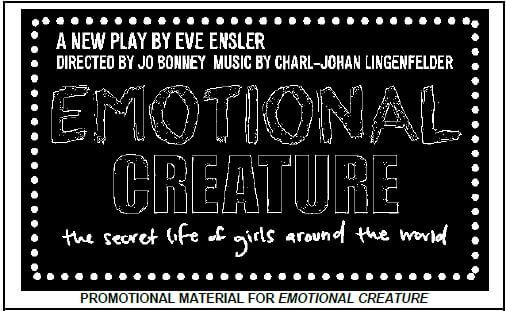
Emotional Creature is a production created by Eve Ensler. It shows challenging issues faced by girls around the world. It is made up of monologues, poems and prose pieces, all performed by girls. The poster above was used to promote the production.
8.1.1 Explain the differences between monologues, poems and prose pieces. (6)
8.1.2 Assess whether the poster in SOURCE H would be successful to advertise the production. (4)
8.1.3 Give the production another suitable title and a #hashtag. Motivate your new title. (4)
8.2 Study SOURCE I below and answer the questions that follow.
SOURCE I
I AM AN EMOTIONAL CREATURE by Eve Ensler I love being a girl. I am an emotional creature. |
You and your class have decided to perform the extract in SOURCE I, from the play Emotional Creature, at the local Youth Day celebration.
Describe your ideas on how to stage the extract and its relevance at a Youth Day celebration.
Refer to the following in your answer:
- Vocal and physical performance
- Technical and theatrical elements (10)
8.3 Name ONE other performance item that would reflect the messages and culture of Youth Day celebrations in South Africa. Motivate your answer. (4)
8.4
Theatre is able to move people emotionally, to talk about issues, to inspire social revolution. – Eve Ensler |
Discuss Eve Ensler's observation about the theatre.
Refer to any play, theatre movement or theatre practitioner you have studied. Give information on a different genre/dramatic movement than the one you discussed in QUESTION 1. (12) [40]
TOTAL SECTION D: 40
GRAND TOTAL: 150
DRAMATIC ARTS GRADE 12 MEMORANDUM - NSC EXAMS PAST PAPERS AND MEMOS NOVEMBER 2018
DRAMATIC ARTS
GRADE 12
NSC EXAMS
PAST PAPERS AND MEMOS NOVEMBER 2018
MEMORANDUM
GENERAL NOTES FOR THE CHIEF MARKER AND MARKERS
1. The purpose of assessment/examination processes is not only to determine the 'remembering' of knowledge taught and learnt at each of the 6 cognitive levels of knowledge, but also to determine the complexity of the thinking process the candidate applies to the knowledge retrieved from memory. The tool to assess these two components is Anderson and Krathwohl's revised Blooms' Taxonomy. | |
6 cognitive levels of difficulty | |
4 thinking processes of complexity | |
2. The marking guideline discussion forum, before marking commences, cannot sufficiently predict all responses. Provincial markers need to take this into account, be open to candidates' responses and make sure that different teaching styles do not disadvantage the learner/candidate. | |
3. Spend the first day unpacking the quality and quantity of the evidence in the marking guidelines, standardise required responses and find common definitions and concepts. Assimilate the | |
Expected responses for each question | |
The cognitive level of difficulty required from the candidate | |
The type of thinking process and complexity of thinking required from the candidate | |
Action verbs used at each of the cognitive levels and the type of evidence required (facts, concepts, processes and thinking). | |
Refer to the annexures at the end of the marking guidelines | |
4. If the marking guidelines do not give clear guidance, a marker must indicate, with a short comment, why marks were awarded or not. | |
5. Tick clearly next to the required cognitive level/thinking process of complexity/ concept/content/skills/knowledge aspects required when a mark is awarded. Markers should engage actively with the answer. | |
Refer to rubrics in the annexure at the end of the marking guidelines | |
6. During the marking process, have regular rounds of consultation to ensure marking is standardised. | |
7. Where a candidate writes more than the suggested number of words, do not penalise (e.g. essay question). | |
8. Mark globally where possible. Markers accept any correct, relevant and well motivated answers. | |
9. Markers must check that candidates' responses align with the Curriculum Assessment Policy Statement's Broad Topics and Topics, Content (concepts, skills and knowledge). | |
STANDARDISATION OF MARKING ACROSS THE PROVINCES
Rating of Essay and Response Questions
- The chief marker in each province must clarify the paradigm from which the questions and the accompanying marking guidelines were designed and set:
- Content difficulty:
How complex is the design of the question? Is the content being assessed at the correct level? - Task difficulty:
What is the cognitive level and thinking process required from the candidate? - Stimulus difficulty:
How difficult or easy is it to understand and apply the source? - Expected response difficulty:
What is the quantity (how much) and quality (how well) of the expected response, required from the candidate, as provided in the marking guidelines?
Does it align with the item, task and stimulus?
Are the marks appropriately weighted and allocated?
-Leong: 2002
In the training of markers at the beginning of the marking process, the chief marker in each province should adhere to the following procedure. This will assist with the standardisation of the scoring of candidate's essays and responses for each part of the examination. It will also standardise national marking procedures, processes and results.
Introduction to the Task
- Markers read the task required from the Item and summarise it.
- Markers read the Item and plan a response to the task.
- Markers share response plans and summarise expectations for student responses/share not just the quantity of evidence (how much) but the quality of evidence (How well).
Introduction to the Rubric and Anchor Papers
- Trainer reviews rubric with reference to the task.
- Trainer reviews procedures for assigning holistic scores (i.e., by matching evidence from the response to the language of the rubric and by weighing all qualities equally).
- Trainer leads review of each anchor paper and commentary. (NOTE: Anchor papers are ordered from high to low within each score level.)
Practise Scoring Individually
- Markers score a set of practice papers individually. Markers should score the papers independently.
- Trainer records scores and leads discussion. (Practice papers should contain scores and commentaries.)
INSTRUCTIONS AND INFORMATION
- This question paper consists of FOUR sections:
SECTION A: 20th Century Theatre Movements (30)
SECTION B: South African Theatre: 1960-1994 (40)
SECTION C: South African Theatre: Post-1994-Contemporary (40)
SECTION D: The History of Theatre, Practical Concepts, Content and Skills (40) - SECTION A
QUESTION 1 is COMPULSORY.
Refer to the play text you have studied and the relevant 20th Century Theatre Movement.
EPIC THEATRE- Caucasian Chalk Circle Bertolt Brecht
- Kaukasiese Krytsirkel Translation of Bertolt Brecht play text
- Mother Courage Bertolt Brecht
- Moeder Courage Translation of Bertolt Brecht play text
- The Good Person of Szechwan Bertolt Brecht
- Kanna Hy Kô Hystoe Adam Small
OR
THEATRE OF THE ABSURD - Waiting for Godot Samuel Beckett
- Afspraak met Godot Translation of Samuel Beckett play text
- Bagasie André P Brink
- The Bald Primadonna Eugene Ionesco
- Die Kaalkop Primadonna Translation of Eugene Ionesco play text
OR
POSTMODERN THEATRE - Skrapnel Willem Anker
- Top Girls Carol Churchill
- Popcorn Ben Elton
- Buried Child Sam Shepard
- SECTION B
This section consists of THREE questions. Answer only ONE question in this section.
QUESTION 2: Woza Albert! Percy Mtwa, Mbongeni Ngema and Barney Simon OR
QUESTION 3: Sophiatown Junction Avenue Theatre Company OR
QUESTION 4: Siener in die Suburbs PG du Plessis - SECTION C
This section consists of THREE questions. Answer only ONE question in this section.
QUESTION 5: Nothing but the Truth John Kani OR
QUESTION 6: Groundswell Ian Bruce OR
QUESTION 7: Missing Reza de Wet - SECTION D
This section consists of ONE question (QUESTION 8) which is COMPULSORY.
SECTION A: 20th CENTURY THEATRE MOVEMENTS
QUESTION 1
The following is a guide:
The candidate must:
- Answer this question in the form of an essay
- Use the play text he/she has studied as an example
- Refer to either one of the three movements: Theatre of the Absurd OR Epic Theatre OR Postmodern Theatre in their answer
- Refer to the Source in their answer e.g.: How innovation is expressed in the play to reflect the philosophy and the Dramatic Movement
- Demonstrate that the question and source have been analysed, understood and integrated in their essay
The content of the essay must cover the following:
- ONE selected Theatre Movement:
- Theatre of the Absurd OR
- Epic Theatre OR
- Postmodern Theatre
- Play text studied
- Question
- Source
Markers note:
- Candidate must demonstrate that the above has been understood and critically analysed and applied in the essay
- Rote learnt knowledge must be contextualised in an original argument that displays factual, contextual, procedural and meta-cognitive thinking
- The rubric on the next page is a guide to the marker to assess the following:
- Levels of cognitive process dimension (remembering, understanding, applying, analysing, evaluating and creating)
- Complexities of thinking displayed by the candidate (factual, conceptual, procedural, metacognitive)
The following is general information on the movements. This information is not the answer to the question. Candidates must demonstrate they have integrated the source, play text, Dramatic Movement in their answer.
GENERAL TO ALL THREE THE DRAMATIC MOVEMENTS
WWI: Russian revolution, the great depression, the rise of dictatorship, capitalism
WWII: Europe and the Pacific countries, Holocaust, new age, a post - war world view and cold war
EPIC THEATRE
Intention is to:
- Distance the audience (emotionally)
- Encourage the audience to see the world in which they lived more critically and clearly rather than take their beliefs for granted
- Make a clear distinction between a Theatre of Illusion, ('Dramatic' Theatre) and Epic Theatre
- Be opposed to the idea of pretence (a typical feature of Realism), but rather portrays the harshness of real life.
- Keep spectators alert throughout the play • Remove the 'illusion' of Realism
- Employ various techniques to alienate the audience - difference between what they saw on the stage and what was real
Techniques
- 'Verfremdungseffekt' or alienation distances the audience from the action on the stage
- Music should provide a noteworthy commentary on the action e.g. in Mother Courage where the ironically bitter words of a song which speaks of the character's steady moral decline are deliberately arranged to a sweet, carefree tune. The incongruity between the tune and the words compels the audience to think about the true meaning of the song
- Songs among the scenes tell the audience what was to happen before it occurred
- Stage space is non-specific
- Sets are simple and symbolic
- Theatre should 'make strange' the actions that are presented
- Historification - the playwright should highlight the 'pastness' of the events by separating them from the present
Audience should:
- Think that, if he or she had experienced the same conditions as those demonstrated in the play, he/she would have acted in a different way, because of the lessons learnt
- Consider what he or she would have done to make a positive difference
- Be inspired to make similar valuable social improvements with regard to the current state of affairs
- Be encouraged to bring about social reforms in his community or environment
THEATRE OF THE ABSURD
The Absurdist world:
- Appears to have no true order or meaning
- Offers the audience an existentialist point of view of the outside world
- Forces the audience to consider their meaning in the world
- Has no definite, specific or recognisable existence
- Proposes that human beings are what they make of themselves
- Proposes that human beings are determined by their actions and choices
- Has a pessimistic outlook of the human struggle
- Mainly concerned itself with mankind's search for meaning
Characters:
- Are not fixed
- Represent humanity who themselves are nothing
- Exist in a bleak world devoid of meaning
- Are lost, confused
- Their actions are worthless and absurd
- Are clown-like
- Stay together as they are afraid to be alone in such an incomprehensible world
- Lack identity - dull, uninteresting and lack dimension
- Flawed
- Are not well-rounded - no past. We are given little indication what the future might be
- Remain static and show no development
- Come across as being repulsive, pathetic, miserable and incapable
- Are emotionally empty
- Their qualities are exaggerated
- Are used to express Absurdists' views on the human condition
- Are mutually dependent
- Are 'Social puppets'
- Perform double acts
Language and dialogue:
- Shows that humans are not adept at communication
- Acts as a barrier to communication
- Isolates the individual even more
- Shows that speech is almost futile
- Questions the value of language
- Lost its ability to communicate
- Attempts at communication often 'disintegrate' from clichés to meaningless syllables
- Inability of language to bridge the gap between the characters
- Dehumanises and makes existence automatic and meaningless
- Presents the unexpected, the bizarre and the absurd
- Uses silence rather than the spoken word
- Contains meaningless conversations
- Are habitual and superficial
- Are seen as an escape from the tedium of life
- Create new words
- Contain banal daily conversations mixed with literary language, puns, clichés, slang and repetitions are interspersed with poetic language
- Displays a repetitious style of dialogue to emphasise the cyclic nature of life
Themes explore and demonstrate the:
- Temporality and evanescence (time)
- Tragic difficulty of becoming aware of one's own self in the merciless process of renovation and destruction that occurs in life
- Change of time
- Difficulty of communication
- Unending quest for reality
- Tragic nature of relationships
- Terror of man in the face of total meaninglessness
- Anguish (Existential angst)
- Isolation and loneliness of man lost in a world in which God has deserted him
- Illusion that science and reason provide answers or meaning
POSTMODERNISM
The Postmodern world:
- Rejects the certainties of the Modern Era
- Contains no Grand Narrative or singular truth
- Rejects the idea that there is a dominant set of beliefs or a neat solution
- 'Destroys' the 'truth'
- Embraces multiple viewpoints, perspectives, realities
- Includes Art, Theatre, Architecture, Music, Film, Literature, Fashion, TV and other forms of expression
- Borrows from a multiple array of styles
- Rejects the notion of 'high art' and 'low art'
- Embraces Avant Garde (forward thinking), experimental theatre
- Does not prescribe to a 'purity' in art
- 'Trashes' high art
- Contains no fixed way of creating art
- Moves towards a more subjective opinion
- Holds that culture belongs to every person
- Deconstructs (a way of taking set notions apart and putting them together again in a new, disrupted and disjointed manner) ideas, images and constructs
- Contradicts ideas, images and constructs
- Does not prescribe a meaning, point of view or perspective
- Reflects and celebrates the madness and chaotic way of life in a Popular culture
- Enjoys nonsense art, ideas, constructs and theories
- Sees irony and humour
- Emphasises HOW things are seen as opposed to WHAT is seen
Pastiche:
- Is a Visual Arts technique of different images, media forms etc. pasted together to create one piece
- Uses references and layers, different texts and images
- Uses Meta Theatre/Text
- Reminds the viewer that they are in the theatre
- Contains characters that can step out of character and communicate with the audience
- Is the art work reflecting on itself
- Is non-linear in construction
- Is reflexive
- Is peripheral even not essential
- Contains theories or ideas
- Is broken up
- May overlap with many points of view and conflicting voices
Performances are:
- The main focus
- The main process
- Not captured in a script because they consist of images, sounds and multimedia
Rehearsal processes are:
- Improvised
- Changed
- Revised
- Updated
- Transformed through performance continually
Audience is:
- An important active element
- Often included in the dialogue
Play Texts:
- Have no clear beginning, middle or end
- Make the script just the starting point
- Have unanswered questions
Texts (visual, aural, the human body etc.):
- Look at themes or theatrical devices
- Leave the play open-ended
- Embrace the idea that the audience makes their own meaning
- Ask more questions than are answered
- Contain visual images and non-spoken actions
- Deconstruct a truth and do not accept only one reality
- Use time, space and structure to echo the deconstructed or defragmented story or plot
- Do not necessarily have real people
- Contain characters and people who are merely a representation of fragmented ideas
- Often start at a realistic point but unravel and the action becomes unreal as the play goes along
TOTAL SECTION A: 30
SECTION B: SOUTH AFRICAN THEATRE: 1960-1994
The candidate must answer only ONE question in this section.
QUESTION 2: WOZA ALBERT! BY PERCY MTWA, MBONGENI NGEMA AND BARNEY SIMON
2.1
Award full marks for:
- One well-motivated statement OR
- Two separate thoughts/ideas
The following is a guide:
- Albert Luthuli was one of the struggle heroes during the apartheid era and it is befitting to acknowledge him
- The name Albert has many connotations such as Albert Street in Johannesburg where work permits were issued
- The repetition of ‘Woza’ emphasises the new production and urges the audience to watch
- It is a call on the previous production since ‘Woza” also means ‘rise up’ / ‘come here’
Markers accept other relevant and well-motivated answers. (2)
2.2
Award full marks for:
- Three well-motivated statements OR
- Six separate thoughts/ideas
The following is a guide:
The road show will:
- Provide fun way of teaching and learning outside the classroom
- Allow learners to engage on a more personal level because the issues are made relevant for them in their own performance
- Encourage peer to peer teaching and learning to take place
- Open up discussion amongst learners because they might be made aware of different interpretations and perspectives
- Encourage learner participation
- Help learners to remember the content and reflect on it
- Encourage watching live performances because it is immediate and visual and will remain in the memories of the audiences who watch the page to stage transformation.
- Help learners to understand how a roadshow works
- Help learners understand the function and practices of poor theatre
- Improve acting skills
- Aid with a be a better understanding of the history of the apartheid era
- Candidates may respond from the point of view of the performers or as the audience
Markers accept other relevant and well-motivated answers. (6)
2.3 Markers accept other relevant and well-motivated answers.
Award full marks for:
- Two well-motivated statements OR
- Four separate thoughts/ideas
- Candidate may give reasons for or against the effectiveness of the poster
The following is a guide:
For:
The poster:
- Contains visual and verbal design aspects that provide relevant information for the production
- Is relevant because it contains some of the themes found in the play
- Is eye catching because it makes use of interesting colours, shapes and words/ideas which relate to the play
- Gives the relevant information about the play and what is to be expected
- Speaks directly to the relevant target audience e.g. Grade 12 students who are studying the play
Against:
The poster:
- Contain design elements that did not serve the advertisement of the roadshow
- Is not colourful, therefore does not attract the eye/attention
- Consists of unnecessary information
- It does not include all the relevant information (4)
2.4 Markers accept other relevant and well-motivated answers.
Award full marks for:
- Three well-motivated statements OR
- Six separate thoughts/ideas
- Up to four marks if there are no references or examples given from the play text
The following is a guide:
'Dreaded Pass Law' and 'Dreaded Dompas':
- Are both themes in the play which reveal the unfairness of the Apartheid system
- Black people were not allowed to travel freely and had to carry a Pass Book at all times as seen in the first scene
- The play highlights the theme of discrimination and injustice as the carrying of a dompas was an infringement on the freedoms and rights of Black people
- Explanation of the apartheid policies and laws e.g. the dompass (6)
2.5 Markers accept other relevant and well-motivated answers.
Award full marks for:
- Two well-motivated statements OR
- Four separate thoughts/ideas
The following is a guide:
Possible challenges might include:
- Time constraints for rehearsals because learners would have other subject demands on their time, sport, transport issues, etc.
- Economic constraints e.g. transport of set and props, sustenance and transport for cast and crew
- Lack of commitment from cast members because not all learners might be dedicated to Drama or performance
- Time away from school would be difficult as other subjects might suffer, examinations might be missed, etc.
- Due to time schedules may not allow external groups to perform at the school
- Some schools may react negatively to the content of the play (4)
2.6 Markers accept other relevant and well-motivated answers. Mark holistically.
Award full marks for:
- Four well-motivated statements OR
- Eight separate thoughts/ideas
Candidates should apply the following principles to their own production
Set and Props:
- Stripping away of all unnecessary theatrical elements e.g. costumes, lighting, sound effects, make-up, props, set
- Set should be functional (to set the mood), rather than decorative
- No scenery, in the traditional sense, only a few functional props
- Eradication and stripping of the stage and its technical/theatrical elements
Actor-audience relationship:
- Eradication of all psychological blocks which prevent actors from offering themselves to their craft and the audience - Holy Actor
- Spatial interplay of actors and audience
- Any space can be adapted
- Audience is involved and affected by the production (8)
2.7 Refer to the notes below and ANNEXURE A to inform your marking
Markers accept other relevant and well-motivated answers. The following is a guide:
The idea of Morena coming back to South Africa was central to the play because:
- It was the original thought generated after singing religious songs in a bus on returning from a tour of Gibson Kente's King Kong, which sparked the idea of the question: 'What would happen if the Saviour, Jesus Christ, came back to an apartheid South Africa?'
- The play's structure is shaped around the questions around Morena coming to South Africa, His arrival and subsequent death and resurrection
- Characters relate to an invisible Morena throughout the play through their acknowledgement of His presence in their conversations
- Morena symbolises the desired freedom from an apartheid South Africa as Morena represents the Saviour, Jesus Christ, freedom from oppression and all that Christ stands for
- Morena unifies and mobilises the oppressed to action because the people feel that He has come to save them from oppression
- Morena is an integral part of the play as a whole, its mood, messages and meaning because the whole play revolves around the question, 'What would you do if Morena came back to South Africa?'
- A reference may be made to irony and hypocrisy (10) [40]
QUESTION 3: SOPHIATOWN BY THE JUNCTION AVENUE THEATRE COMPANY
3.1 Markers accept any relevant title with a suitable motivation.
Award:
- One mark for the title
- One mark for the motivation (2)
3.2.1 Markers accept relevant answers that demonstrate an understanding of a scene taken from Sophiatown.
Award full marks for:
- Four separate thoughts/ideas The following is a guide:
The arrival of Ruth in Sophiatown: - Surprises the inhabitants of Mamariti's house as the family was unaware of Jakes' plan
- At first causes Lulu and Princess to be unwelcoming towards Ruth, because Ruth is a stranger to them in their home
- Creates interest and attraction for Mingus and Jakes as she is of the opposite sex and she is a white girl from Yeoville
- Introduces someone from 'the outside' to Sophiatown, from the northern suburbs of Johannesburg (4)
3.2.2 Markers accept other relevant and well-motivated answers. Mark holistically
Award full marks for:
- Two well-motivated statements OR
- Four separate thoughts/ideas
- The following is a guide:
Ruth:
- Could wear a floral dress, flat shoes, a necklace and a summer hat
- Is from Yeoville and possibly exposed to the latest Johannesburg fashions
Lulu:
- Could wear her school uniform consisting of a tunic, white shirt, grey socks and black school shoes (4)
3.2.3 The candidate must show an understanding of how an actor should approach the truthful and realistic interpretation of the role. Mention could be made of Stanislavski's System/ Method. Other authentic, original acting methods and
approaches to vocal, acting and characterisation techniques should be acknowledged.
Award full marks for:
- Three well-motivated statements OR
- Six separate thoughts/ideas
Markers accept other relevant and well-motivated answers.
The candidate must mention the elements of the acting method / system they decided to discuss The following is a guide to the depth and breadth of the type of answer a candidates should give. The Stanislavski system /method is only an example. - Shifts in thought and feeling are reflected authentically through the actors' actions and reactions towards each other through the use of facial expression and gestures
- The director should facilitate the actors' understanding of the thoughts and feelings which reflect the characters' relationship at this point in the play and elicit authentic responses from the actors, e.g. Mingus' reaction when Princess decides to pose for a Dutch photographer
- The actors should live 'in the moment' and vocal and physical responses could therefore vary from performance to performance but will always be and true
- Stanislavski's or any other theatre practitioner's method can be provided
Before rehearsals:
- The actor could read the script to understand how the character behaves, responds and fits into the action of the play
Observation and research:
- The actor could do a thorough analysis of the character in the play text
- Understand the character's goals and motivations
- Do thorough research and observation of the character type
Physical score of actions:
- Actions and reactions should be realistic to the character in the situation
- Uses physical action (facial expression, gestures and movement) in a natural and believable manner in the creation of the play's life on stage
Vocal expression:
- As the play is realistic, the actor should create the illusion of a real conversation
- Guide the actor to understand the thoughts and feelings which are reflected in the actor's vocal responses through tone, pace, rate, volume etc.
Beat work:
- Shifts in thought and feeling should be reflected effectively, realistically and believably.
- Units and objectives should be reflected in the actor's physical and vocal expression
Magic if:
- The actor should play as if he/she is the character and vocal and physical responses could, therefore, vary from performance to performance. 'Acting is believing'
Circles of attention:
- Actor's focus should be on the world of the play and not on the audience
Emotional memory:
- Actor can use personal experiences and real emotions
Warm-up exercises:
- The actor should warm up his or her instrument to be able to deliver on the physical and vocal demands of the role
- Vocal warm-ups, e.g. diaphragmatic intercostal breathing, resonance exercises ( humming)
- Physical warm-up exercises could include spinal rolls for flexibility and posture (6)
3.3.1 Markers accept other relevant and well-motivated answers.
Award full marks for:
- Three well-motivated statements
- Six separate thoughts/ideas
The following is a guide:
Universal relevance:
- Sophiatown is as relevant today as it was then. The themes, issues and characters all represent humanity in its essential timelessness, e.g. prejudice and love relationships
- Themes of discrimination, gangsterism, etc. are still prevalent today
- The dynamic nature of the production still entertains and educates because it contains singing, dancing, narration, varied colourful characters
- A living newspaper and historical documentary recording events for all time (6)
3.3.2 Markers accept other relevant and well-motivated answers.
Award:
- One mark for the means of advertising
- One mark for the motivation
The following is a guide:
The road show could be advertised in the following ways through:
- Social media, e.g. Facebook, Twitter, WhatsApp
- Print media, e.g. newspapers, posters
- Word of mouth
- Local radio stations, interviews, talk shows, advertisements
Motivation:
- Using various media forms has the potential to reach more people
- It is cost effective and thereby saves money (2)
3.4 Markers accept other relevant and well-motivated answers.
Award:
- Two marks for the selected items AND
- Four marks for justification of items
The following is a guide:
The following theatrical items might be selected to reflect Sophiatown of the 1950s because they were popular at the time:
- Contemporary music because it could be exciting and fun
- Various indigenous dance styles which could educate and entertain
- Chorus work which could add a dynamic and powerful vocal impact
- A capella singing which could bring a truthful and sincere tone to the production
- Jazz music which influenced the lifestyle of the place
- American dance styles of the time e.g.: swing, jive which were enjoyed in dance halls at the time
- The penny-whistle which was a popular and inexpensive musical instrument used at the time
- Popular songs of the day, e.g. Pata Pata and songs by Miriam Makeba
- Might include an item as a physical object e.g.: props or decor (6)
3.5 Refer to the notes below and ANNEXURE A to inform your marking.
Candidates' answers must be well-motivated and show an understanding of the socio-political issues and the themes, and offer critical insight reflecting a personal evaluation.
The following is a guide:
Socio-political issues in an apartheid South Africa:
- Inequality is depicted through the restriction of movement of black people
- Residents of Sophiatown were not allowed to buy alcohol in Johannesburg because of strict Apartheid laws
- Interracial relationships were not allowed e.g. Ruth and Jakes could not be in a relationship because of their different skin colours (Immorality Act)
- People were allocated living spaces according to their race (Group Areas Act) because of Apartheid laws which segregated people along racial lines
- High rate of unemployment led to the formation of gangs and an increase in crime in order to survive and provide for their families
Themes:
- Bantu education, as shown through the character of Lulu. It was an inferior system of education aimed at keeping the majority of the population oppressed and repressed
- Forced removals: many residents of Sophiatown did not want to move to Meadowlands because they had every right to stay in their own homes . They used placards and written slogans such as 'We Won't Move' to protest
- Gangsterism: rival gangs would fight over the control of territories and girls in order to make money to survive and also to protect each other
- Overcrowding was seen as normal in Sophiatown because many people were attracted to the place due to its vibrant lifestyle in which different cultures mixed freely, interchanging their creativity, musicality, ideas and cultures.
- House owners rented out back rooms to as many people as their yards could accommodate to make money
- Domestic violence as seen through the characters of Mingus and Princess. Mingus physically and verbally abused Princess because he felt entitled to do so since he was providing for her, which shows sexism and patriarchy
Markers accept other relevant and well-motivated answers. (10) [40]
QUESTION 4: SIENER IN DIE SUBURBS BY PG DU PLESSIS
4.1 Markers accept any relevant title with a suitable motivation.
Award:
- One mark for the title
- One mark for the motivation (2)
4.2.1 Markers accept relevant answers that demonstrate an understanding of a scene taken from Siener in die Suburbs.
Award full marks for:
- Four separate thoughts/ideas
The following is a guide:
Jakes' assault of Tiemie:
- Tiemie runs into the house followed by Jakes because he is angry with her for possibly being pregnant with another man's child
- Ma becomes hysterical and pleads with Jakes to leave Tiemie alone
- Giel decides to leave because he has won some money on the horses
- Tjokkie commits suicide (4)
4.2.2 Markers accept other relevant and well-motivated answers. Mark holistically
Award full marks for:
- Two: for a well-described costume OR
- Four: for separate thoughts/ideas
The following is a guide:
Jakes:
- Could wear a sleeveless white vest, printed shirt, jeans and a leather jacket
- Is rebellious in his nature and behaviour and this is portrayed in his costume
Tiemie:
- Could wear a short floral summer dress and flat shoes
- Is quite fashionable and her costume will reflect that. (4)
4.2.3 The candidate must show an understanding of how an actor should approach the truthful and realistic interpretation of the role. Mention could be made of Stanislavski's System/ Method. Other authentic, original acting methods and
approaches to vocal, acting and characterisation techniques should be acknowledged.
Award full marks for:
- Three well-motivated statements OR
- Six separate thoughts/ideas
Markers accept other relevant and well-motivated answers.
The candidate must mention the elements of the system / method or other acting methods
The following is a guide to the depth and breadth of the type of answer a candidates should give. The Stanislavski system /method is only an example.
- Shifts in thought and feeling are reflected authentically through the actors' actions and reactions towards each other through the use of facial expression and gestures
- The director should facilitate the actors' understanding of the thoughts and feelings which reflect the characters' relationship at this point in the play and elicit authentic responses from the actors, e.g. Mingus' reaction when Princess decides to pose for a Dutch photographer
- The actors should live 'in the moment' and vocal and physical responses could therefore vary from performance to performance but will always be and true
- Stanislavski's or any other theatre practitioner's method can be provided
Before rehearsals:
- The actor could read the script to understand how the character behaves, responds and fits into the action of the play
Observation and research:
- The actor could do a thorough analysis of the character in the play text
- Understand the character's goals and motivations
- Do thorough research and observation of the character type
Physical score of actions:
- Actions and reactions should be realistic to the character in the situation
- Uses physical action (facial expression, gestures and movement) in a natural and believable manner in the creation of the play's life on stage
Vocal expression:
- As the play is realistic, the actor should create the illusion of a real conversation
- Guide the actor to understand the thoughts and feelings which are reflected in the actor's vocal responses through tone, pace, rate, volume etc.
Beat work:
- Shifts in thought and feeling should be reflected effectively, realistically and believably.
- Units and objectives should be reflected in the actor's physical and vocal expression
Magic if:
- The actor should play as if he/she is the character and vocal and physical responses could, therefore, vary from performance to performance. 'Acting is believing'
Circles of attention:
- Actor's focus should be on the world of the play and not on the audience
Emotional memory:
- Actor can use personal experiences and real emotions
Warm-up exercises:
- The actor should warm up his or her instrument to be able to deliver on the physical and vocal demands of the role
- Vocal warm-ups, e.g. diaphragmatic intercostal breathing, resonance exercises ( humming)
- Physical warm-up exercises could include spinal rolls for flexibility and posture (6)
4.3.1 Candidates may say it is not relevant now (‘or does it’ implies it may not be).
Accept other relevant and well-motivated answers for example the setting, language and context of the characters may not be not familiar to everyone.
Award full marks for:
- Three well-motivated statements
- Six separate thoughts/ideas
The following is a guide:
Universal relevance:
- Siener in die Suburbs is as relevant today as it was then
- Themes of poverty, freedom, abuse, etc. are still prevalent today
- The realistic nature of the play (language, setting, characters, etc.) is relatable and relevant to all audiences (6)
4.3.2 Markers accept other relevant and well-motivated answers.
Award:
- One mark for the means of advertising
- One mark for the motivation
The following is a guide:
The road show could be advertised in the following ways:
- Social media, e.g. Facebook, Twitter, WhatsApp
- Print media, e.g. newspapers, posters
- Word of mouth
- Local radio stations
Motivation:
- Potential to reach a vast number of people
- Cost effectiveness (2)
4.4 Candidates must display an understanding of the possible theatrical impact of the motorbike in a production of the play.
Award full marks for:
- Three well-motivated statements OR
- Six separate thoughts/ideas
The following is a guide:
The motorbike could create:
- A dangerous atmosphere because the sound of the motorbike is loud and aggressive when Jakes rides it
- An intimidating mood because it is displayed on the stage and represents Jakes' presence in the play. Jakes is seen as a bully
- The model of the chosen motorbike could add to the characterisation of Jakes as he is a bully and intimidates people to get his way. He bullies Tjokkie to 'see'. He is defensive and will not hesitate to use violence to get
his own way
Markers accept other relevant and well-motivated answers. (6)
4.5 Refer to the notes below and ANNEXURE A to inform your marking.
Candidates should display an understanding of how love resonates as a theme throughout the play.
The following is a guide:
- It is clear from Jakes' actions that he does not understand love when he assaults Tiemie and throws the bloodied altar-cloth to Ma and says, 'Daar is jou blêrrie love'
- The message on the altar-cloth, 'God is Liefde', indicates that Ma tries to live by this example, unlike the other characters, even though they accuse her of being a bad role-model and a woman of low moral standards
- Ma experiences personal tragedy because she is tries to find God's love in her search for a patriarch for her family
- The relationship between Giel and Ma reflects a love of convenience and superficiality because Giel leaves as soon as he wins on the horses
- Tiemie and Jakes merely have a sexual relationship and do not love one another. However, Jakes says that he is a 'bok vir love' and claims that he cares for Tiemie
- Fé loves Tjokkie, however Tjokkie says that his ability to 'see' is more important than a relationship with Fé
- Ma loves her children. She will never let Tjokkie 'see' for her own benefit as she knows that the act of 'seeing' hurts him
Markers accept other relevant and well-motivated answers. (10) [40]
TOTAL SECTION B: 40
SECTION C: SOUTH AFRICAN THEATRE: POST-1994-CONTEMPORARY
QUESTION 5: NOTHING BUT THE TRUTH BY JOHN KANI
5.1.1 Truth and Reconciliation Commission (1)
5.1.2 Thando or Thando Makhaya (1)
5.1.3 Markers accept other relevant and well-motivated answers.
The following is a guide:
Amnesty:
- Is the pardoning of offences
- Is granted to perpetrators who disclose all their deeds
- Allows the perpetrator to go free once granted amnesty (2)
5.1.4
The following is a guide:
The Daily Mirror is a suitable title because:
- It reflects daily life and the lives of the Makhaya family
- 'Daily' would reflect day to day events
- Realism in the theatre holds up a 'mirror' to life
- It helps us look at real issues
Markers accept other relevant and well-motivated answers. (3)
5.2 Markers accept other corrects answers.
The following is a guide:
TRC cases mentioned in the play, e.g.:
- Craig Williamson case
- Chris Hani case
- Ruth First case
- The Cradock Four case
- Pebco three (2)
5.3 Markers accept other relevant and well-motivated answers.
The following is a guide:
The play would make a good TV series because it contains elements of:
- Romance
- Love
- Illicit affairs amongst family members
- Death
- Intrigue
- Sensationalism
- Suspense
- Secrets and lies finally revealed
Characters:
- Hide secrets (Sipho)
- Are flamboyant (Mandisa)
- Have affairs (Themba)
- Get drunk (Sipho)
- Are morally upright (Thando)
- Are dramatic in their outbursts (Sipho saying he will blow up the library)
Situations:
- Are sensational (illicit affair of Themba)
- Are tense (awaiting the arrival of Themba's body)
- Are scandalous (Thando might be Themba's child)
- Reflect conflict in the family (brother against brother, etc.)
The play would not make a good TV series because it deals with:
- Sensitive issues concerning real people
- The atrocities of apartheid and the effects of these on ordinary people and the daily struggles that people face in order to survive
Characters:
- Live ordinary everyday lives
- Represent the common man
- Deal with sensitive issues which are painful and real
Situations reflect:
- Ordinary, everyday situations that everyone faces
- Normal sibling rivalry/conflict in the family (brother against brother)
Mark holistically (4)
5.4 Markers accept other relevant and well-motivated answers.
The following is a guide:
Sipho is shocked and angry because:
- The custom of cremation is against his traditional beliefs about burial as the African system of burial involves a coffin and a body
- He expected to fetch a body in a coffin at the airport and was surprised to find out that there would be no body to bury
- He is angry with his family in London for not informing him and feels that his wishes have not been heard or considered
- He has spent much time and effort to prepare and arrange the funeral
Mark Holistically (3)
5.5 The candidate must show an understanding of how an actor should approach the truthful and realistic interpretation of the role. Mention could be made of Stanislavski's System/ Method. Other authentic, original acting methods and
approaches to vocal, acting and characterisation techniques should be acknowledged.
Award full marks for:
- Three well motivated statements OR
- Six listed and briefly described separate thoughts/ideas
Markers accept other relevant and well-motivated answers.
The candidate must mention the elements of the system / method or other acting methods
The following is a guide to the depth and breadth of the type of answer a candidates should give. The Stanislavski system /method is only an example.
- Shifts in thought and feeling are reflected authentically through the actors' actions and reactions towards each other through the use of facial expression and gestures
- The director should facilitate the actors' understanding of the thoughts and feelings which reflect the characters' relationship at this point in the play and elicit authentic responses from the actors, e.g. Mingus' reaction when Princess decides to pose for a Dutch photographer
- The actors should live 'in the moment' and vocal and physical responses could therefore vary from performance to performance but will always be and true
- Stanislavski's or any other theatre practitioner's method can be provided
Before rehearsals:
- The actor could read the script to understand how the character behaves, responds and fits into the action of the play
Observation and research:
- The actor could do a thorough analysis of the character in the play text
- Understand the character's goals and motivations
- Do thorough research and observation of the character type
Physical score of actions:
- Actions and reactions should be realistic to the character in the situation
- Uses physical action (facial expression, gestures and movement) in a natural and believable manner in the creation of the play's life on stage
Vocal expression:
- As the play is realistic, the actor should create the illusion of a real conversation
- Guide the actor to understand the thoughts and feelings which are reflected in the actor's vocal responses through tone, pace, rate, volume etc.
Beat work:
- Shifts in thought and feeling should be reflected effectively, realistically and believably.
- Units and objectives should be reflected in the actor's physical and vocal expression
Magic if:
- The actor should play as if he/she is the character and vocal and physical responses could, therefore, vary from performance to performance. 'Acting is believing'
Circles of attention:
- Actor's focus should be on the world of the play and not on the audience
Emotional memory:
- Actor can use personal experiences and real emotions
Warm-up exercises:
- The actor should warm up his or her instrument to be able to deliver on the physical and vocal demands of the role
- Vocal warm-ups, e.g. diaphragmatic intercostal breathing, resonance exercises ( humming)
- Physical warm-up exercises could include spinal rolls for flexibility and posture (6)
5.6 Markers accept other relevant and well-motivated answers.
Award full marks for:
- Three well-motivated statements OR
- Six separate thoughts/ideas
The following is a guide:
African and Western cultural traditions and practices are shown through:
- Belief systems regarding funerals, e.g. African funerals involve the paying of respect to the deceased's body in an open coffin and respecting this body even when buried as the ancestors (the dead) are evoked in ceremonies and rituals after they are dead and buried
- Marriage customs of ilobolo / magadi and Western marriage rituals are mentioned in Thando and Mandisa's conversations about boyfriends.:
Whereas Mandisa has many boyfriends of different cultural backgrounds (e.g. Derek Loxworth), Thando's relationship with Mpho is longstanding and she is engaged to him and will marry him according to traditional custom
- lobolo: (IsiZulu), lilobola: (Siswati), lovolo (xiTsonga), lowolo (Angoni, Sena, Tumbula, Ngonde of Malawi)
- mahadi (SeSotho), magadi (SeStwana, SePedi, SePulana), mamolo (TshiVenda, ChiWongo, ChiChewa of Malawi)
- Reference to the Nuremberg Trial and the TRC in comparison to the Lekgotla. Different geographical regions may use a different word for Lekgotla.
- legotla (SePedi, SeTswana, SeSothu, Sepulana) • imbizo (IsiZulu, IsiXhosa, IsiNdebele)
- mbidzo (TshiVenda)
- sibaya or enkundleni (SiSwati
- xivijo or ehumbyeni (XiTsonga)
- The relationships differ between parents and children, seen in Mandisa's disrespect towards her elders, shown in the way in which she speaks to Sipho and Thando's respectful responses to Sipho
- The African traditional dress is seen in Nandipa's designs. Thando has a dress designed by Nandipha Kalana and this is different from Western design, which interests Mandisa as a fashion design student from London 6
5.7 Refer to the notes below and ANNEXURE B to inform your marking.
Markers accept other relevant and well-motivated answers.
The following is a guide:
Candidates may focus on different aspects of the newspaper stimulus in Source G to answer the questions around sociopolitical context, subject matter and themes of the play. Award marks for a well-integrated, creative response to the question, which refers to Nothing But The Truth.
Socio-political context:
- The TRC was a significant influence on the socio-political environment of South Africa as it re-looked at the atrocities of the past and processed these in a way in which social transformation and healing was possible through the revelation of truth, personal stories and forgiveness/amnesty
- This play is Theatre for Reconciliation and its plot and themes reflect the essence of the TRC
- New South African democracy and freedoms created a new social, political, personal and psychological space in which to live
Subject matter:
- The plot of the play deals with loss, love, exile and sibling rivalry between Sipho and Themba Makhaya as Themba 'stole' much from Sipho: his wire bus, blazer, wife, education etc.
- Western vs. African traditions are reflected in the statement and article about 'Ashes to Ashes' as African funerals did not include cremation
Themes:
- Sibling rivalry is seen through Themba and Sipho and their conflict revealed though Sipho's disclosure of secrets and truths of the past
- Love is reflected in the name of Sipho's daughter Thando, Sipho's love of Themba, Sindiswa and Thando and the love of family and also of one another, which is the antidote to racism, prejudice, hatred and bitterness
- Loss is reflected in loss of a brother through exile and death, loss of human rights and dignity in an apartheid South Africa and the regaining of and restoration of dignity and humanity, family and country through the process of reconciliation
- All aspects of the Daily Mirror are acceptable in this answer. (12) [40]
QUESTION 6: GROUNDSWELL BY IAN BRUCE
6.1.1 Markers accept other relevant and well-motivated answers.
The following is a guide:
The name of the newspaper is appropriate because:
- The play is set on the West Coast
- The play observes the lives of the characters in the play in a realistic manner (2)
6.1.2 Markers accept other relevant and well-motivated answers.
The following is a guide:
Garnet Lodge is a suitable setting because of the:
Remoteness of the lodge:
- Could underscore the idea that the characters of the play are isolated and trapped
The position of the lodge:
- On the sea cliff could highlight the idea that there is a sense of danger, e.g. Johan threatening Smith
The lodge is a meeting point:
- The lodge dislodges the characters from their own homes (4)
6.1.3 Markers accept other relevant and well-motivated answers.
The following is a guide:
The quote:
- Reflects the oppression of the characters
- The silent fog hangs in the air almost suffocating the inhabitants
- The sea bell tolls in the play and rings out impending doom
- The bell knolls time's passing
- The unhurried groundswell is the undercurrent which drives the play
- The tension and mood of the play are influenced by the groundswell (4)
6.1.4 Markers accept other correct, relevant and well-motivated answers.
Award full marks for:
- Three well-motivated statements OR
- Six separate thoughts/ideas
The following is a guide:
The play is a psychological drama because:
- Characters are three-dimensional
- They have believable pasts, complex presents and hopeless futures
- The illusion of reality is created by the attention to detail in the realistic authentic and truthful portrayal of each character
- The complexities of their relationships are shown in the manipulation of each other in order to get what they want
- Objectives and desires drive each character
- Tensions between the characters drive the plot of the play
- Characters were modelled on real life characters (6)
6.1.5 Markers accept other relevant and well-motivated answers.
Award full marks for:
- Three well-motivated statements OR
- Six separate thoughts/ideas
The following is a guide:
Sociopolitical context:
- Post-apartheid South Africa
- Time for forging new relationships
- An opportunity for doing just that is presented in this holding-place, Garnet Lodge, but the real opportunity for changed dynamics between people is not taken
- Each character brings 'baggage' from his past into the new situation and is unable to let it go
Subject Matter:
- Psychological traumas of the past are suggested by the counselling service offered in the newspaper
- There is a need for psychological intervention in the lives of individuals affected by apartheid
- The set and setting of the play is mentioned in the advertisement for accommodation at Garnet Lodge
- The Lodge's isolation is also mentioned
- Deep sea diving is the subject matter of the diamond diving in the play
- Johan has been physically affected by too much diving and states his body is like a fizzy drink
- The attack on Smith by Johan is also mentioned as an article on page 2 and alludes to this incident which is the subject of tension and climax and affects the action and outcome of the play (6)
5.5 The candidate must show an understanding of how an actor should approach the truthful and realistic interpretation of the role. Mention could be made of Stanislavski's System/ Method. Other authentic, original acting methods and
approaches to vocal, acting and characterisation techniques should be acknowledged.
Award full marks for:
- Three well motivated statements OR
- Six listed and briefly described separate thoughts/ideas
Markers accept other relevant and well-motivated answers.
The following is a guide to the depth and breadth of the type of answer a candidates should give. The Stanislavski system /method is only an example.
- Shifts in thought and feeling are reflected authentically through the actors' actions and reactions towards each other through the use of facial expression and gestures
- The director should facilitate the actors' understanding of the thoughts and feelings which reflect the characters' relationship at this point in the play and elicit authentic responses from the actors, e.g. Mingus' reaction when Princess decides to pose for a Dutch photographer
- The actors should live 'in the moment' and vocal and physical responses could therefore vary from performance to performance but will always be and true
- Stanislavski's or any other theatre practitioner's method can be provided
Before rehearsals:
- The actor could read the script to understand how the character behaves, responds and fits into the action of the play
Observation and research:
- The actor could do a thorough analysis of the character in the play text
- Understand the character's goals and motivations
- Do thorough research and observation of the character type
Physical score of actions:
- Actions and reactions should be realistic to the character in the situation
- Uses physical action (facial expression, gestures and movement) in a natural and believable manner in the creation of the play's life on stage
Vocal expression:
- As the play is realistic, the actor should create the illusion of a real conversation
- Guide the actor to understand the thoughts and feelings which are reflected in the actor's vocal responses through tone, pace, rate, volume etc.
Beat work:
- Shifts in thought and feeling should be reflected effectively, realistically and believably.
- Units and objectives should be reflected in the actor's physical and vocal expression
Magic if:
- The actor should play as if he/she is the character and vocal and physical responses could, therefore, vary from performance to performance. 'Acting is believing'
Circles of attention:
- Actor's focus should be on the world of the play and not on the audience
Emotional memory:
- Actor can use personal experiences and real emotions
Warm-up exercises:
- The actor should warm up his or her instrument to be able to deliver on the physical and vocal demands of the role
- Vocal warm-ups, e.g. diaphragmatic intercostal breathing, resonance exercises ( humming)
- Physical warm-up exercises could include spinal rolls for flexibility and posture (6)
6.3 Refer to the notes below and ANNEXURE B to inform your marking.
Markers accept other relevant and well-motivated answers.
The following is a guide:
The characters might/might not be able to move forward because:
- They are trapped in a situation which is hopeless
- The only hope Johan and Thami had to fulfil their dreams was Smith
Johan:
- Is deeply affected by his past
- Is unable to change
- Needs Thami's understanding and acceptance in order to be free of his guilt
- Although he is desperate to end his isolation and long years of banishment, he doesn't succeed
- Even when he leaves the lodge he chases his dog away, thus is totally alone and bereft
Thami:
- Is affected by apartheid
- Is unable to change as he doesn't have the means to do it
- Has left his family to seek his fortune but has failed
- Doesn't need Johan's friendship but sees Johan's plans and schemes as an opportunity to get out of his present situation
- Unlike Johan, Thami has other options in the new South Africa, but will he succeed in taking them?
- Thami might be able to forge a future by going back to his family, although he might be too ashamed to do so
Smith:
- Has wealth, is in a healthy financial situation, but does he have time?
- He has lost the meaning and purpose in his life
- After the play ends, Smith will probably continue his selfish, meaningless life and eat another breakfast at the Lodge
- It is unlikely that he will ever change
- His family has dispersed and he is alone
- His life is empty and lonely
- His attitudes towards others are so set that it is unlikely that he will find new insights into relationships (12) [40]
QUESTION 7: MISSING BY REZA DE WET
7.1.1 Candidates must display an understanding of the play's content.
Award full marks for:
- ONE well-motivated statement OR
- TWO separate thoughts/ideas
The following is a guide:
The name of the newspaper is appropriate because:
- In the play it is clear that Miem and Gertie enjoy gossip when they discuss the people of the town and the 'evils' of the circus
- It is sensational because they lie about the ‘long’ list of girls. Only a two girls went missing.
Markers accept other relevant and well-motivated answers. (2)
7.1.2 Candidates must display an understanding of the play's context.
The following is a guide:
Candidates may answer as follows:
- 1 September, as Meisie goes missing late on the evening of 31 August
Markers accept other relevant and well-motivated answers. (2)
7.1.3 Markers accept other relevant and well-motivated answers.
Award full marks for:
- TWO well-motivated statements OR
- FOUR separate thoughts/ideas
The following is a guide:
Afrikaans = 'Mis':
- Bemesting (die 'mis' wat Miem en Meisie in sakke pak om te verkoop)
- 'Mis' as menslike ontlasting (die aksies en gesprekke rondom die slopemmer)
- Indirekte verwysings na Rooms Katolieke 'Mis' (al die vroue in die drama bieg teenoor Konstabel soos teenoor 'n priester)
- Die vroue kyk die waarheid 'mis'
- Meisies word uit die dorp ver'mis'
- Die feit dat die vroue hul 'mis'gis
- Al die karakters 'mis' iets
- 'Mis'tig buitekant
- 'Mis' voor die vroue se oë
English = 'Missing':
- The girls who have gone 'missing'
- The characters are all 'missing' something: Miem 'misses' Gabriel, Gertie 'misses' her youth and sexual liberation and Meisie 'misses' her freedom
- The truth is 'missing' from the house
- We are aware of the absence of Gabriel - he is 'missing'
- Joy, love and warmth are 'missing' in the house
7.2 Markers accept other relevant and well-motivated answers. Candidates must display an understanding of Constable's character. Award full marks for:
- TWO well-motivated statements OR
- FOUR separate thoughts/ideas
The following is a guide:
Constable:
- Is charming and a bit mysterious and socially well versed
- Uses his blindness and his willingness to look after the women to secure their trust
- Manipulates by exploiting the vulnerability of the other characters
- He is blind. He has an excellent sense of smell
- He has an impressive presence and good posture
- He speaks Afrikaans
- He has heightened senses
- Represents the mysterious external environment, e.g. the circus which is feared by some and a curiosity for others
- The constable`s physical appearance may be included in the description (4)
7.3 Markers accept other relevant and well-motivated answers. Candidates must display an understanding of the characters in the play.
Award full marks for:
- TWO well-motivated statements OR
- FOUR separate thoughts/ideas
The following is a guide:
The women allow Constable in the house because:
- They have an implicit trust in patriarchy, (because of the Calvinistic belief)
- A policeman must be trusted
- His 'blindness' cause them to believe that he is harmless and more trustworthy (4)
7.4 The candidate must show an understanding of how an actor should approach the truthful and realistic interpretation of the role. Mention could be made of Stanislavski's System/ Method. Other authentic, original acting methods and
approaches to vocal, acting and characterisation techniques should be acknowledged.
Award full marks for:
- Three well motivated statements OR
- Six listed and briefly described separate thoughts/ideas
Markers accept other relevant and well-motivated answers.
The following is a guide to the depth and breadth of the type of answer a candidates should give. The Stanislavski system /method is only an example.
- Shifts in thought and feeling are reflected authentically through the actors' actions and reactions towards each other through the use of facial expression and gestures
- The director should facilitate the actors' understanding of the thoughts and feelings which reflect the characters' relationship at this point in the play and elicit authentic responses from the actors, e.g. Mingus' reaction when Princess decides to pose for a Dutch photographer
- The actors should live 'in the moment' and vocal and physical responses could therefore vary from performance to performance but will always be and true
- Stanislavski's or any other theatre practitioner's method can be provided
Before rehearsals:
- The actor could read the script to understand how the character behaves, responds and fits into the action of the play
Observation and research:
- The actor could do a thorough analysis of the character in the play text
- Understand the character's goals and motivations
- Do thorough research and observation of the character type
Physical score of actions:
- Actions and reactions should be realistic to the character in the situation
- Uses physical action (facial expression, gestures and movement) in a natural and believable manner in the creation of the play's life on stage
Vocal expression:
- As the play is realistic, the actor should create the illusion of a real conversation
- Guide the actor to understand the thoughts and feelings which are reflected in the actor's vocal responses through tone, pace, rate, volume etc.
Beat work:
- Shifts in thought and feeling should be reflected effectively, realistically and believably.
- Units and objectives should be reflected in the actor's physical and vocal expression
Magic if:
- The actor should play as if he/she is the character and vocal and physical responses could, therefore, vary from performance to performance. 'Acting is believing'
Circles of attention:
- Actor's focus should be on the world of the play and not on the audience
Emotional memory:
- Actor can use personal experiences and real emotions
Warm-up exercises:
- The actor should warm up his or her instrument to be able to deliver on the physical and vocal demands of the role
- Vocal warm-ups, e.g. diaphragmatic intercostal breathing, resonance exercises ( humming)
- Physical warm-up exercises could include spinal rolls for flexibility and posture (6)
7.5 Markers accept other relevant and well-motivated answers. Candidates must display an understanding of how the socio-economic context of the play.
Award full marks for:
- TWO well-motivated statements OR
- FOUR separate thoughts/ideas
The following is a guide:
The Great Depression:
- The play takes place in the context of economic hardship
- Miem and Meisie labour to sew bags and sell manure to make a living because work is scarce due to the Great Depression
- The father escaped to the attic due to the effects of the depression as he cannot deal with the harsh realities of life. He himself is in his own personal 'great depression' and this is expressed by his unconventional way of dealing with life by living in the attic alone
- Miem is forced to be mother and father in a very patriarchal environment as the father figure has become absent
- These characters are forced into survival mode, which is why the circus itself provides great relief and escape from the Great Depression (4)
7.6 Markers accept other relevant and well-motivated answers.
Award one mark for choice and one mark for motivation.
The following is a guide:
The following products/services could be advertised in the newspaper:
- Deodoriser - stench of manure
- Private detective agency - Meisie goes missing
- Roses - to get rid of the smell of manure
- Sacks - used for manure
- Clothes - sewn by Meisie
- Oil for the lamp
- Aerobics classes offered by Gertie
- Doom (fly poison for Meisie)
- Apples - constable eats apples
- Windows for window pane installation
7.7 Refer to the notes below and the rubric in ANNEXURE B to inform your marking. (2)
Markers accept other relevant and well-motivated answers. Candidates should display an understanding of how the circus is a central idea in the play.
The following is a guide:
Genre:
The circus is:
- In direct conflict with the ideals of Afrikaner Calvinism as it represents immorality, promiscuity, the downfall of the church, the occult, etc.
- Seen as an aspect of society where the impossible is made possible thus it supports the Magical Realism of the play and provides new insights and unanswered questions
- Associated with the supernatural because people fear what they do not understand and, as a result, create supernatural myths to frighten people from visiting the circus
Mood and atmosphere:
The circus:
- Creates tension when the representative of the external environment (Constable/Pierrot) invades the internal environment (Miem's house)
- Music and lights enhance the sense of the mystery and nervous excitement
Characters:
- Miem only speaks about the circus, she does not go there. She forbids her daughter from having anything to do with it. However, she does display moments of curiosity whenever Meisie is not around
- Gertie is curious and has visited the smaller circus tent next to the main arena and witnessed the circus procession through the streets
- Meisie is forbidden to go to the circus. However, Meisie is curious and sneaks out the house to go and experience the mysteries of the circus
- Constable is from the circus which becomes evident when he transforms into a Pierrot (clown) (12) [40]
TOTAL SECTION C: 40
SECTION D: THE HISTORY OF THEATRE, PRACTICAL CONCEPTS, CONTENT AND SKILLS
QUESTION 8 (COMPULSORY)
8.1.1 Award two marks for each definition.
The following is a guide:
Monologue:
- Speech spoken by one person. It is usually from a play
Poem:
- Stylised language used to express emotions and ideas
Prose:
- Language in sentence format/consists of dialogue as well as narration. It is a form of storytelling. It could be written in the first person. It is usually from a short story or any other text. It is not from a play text.
Markers accept other relevant answers. (6)
8.1.2 Award marks for responses showing understanding and knowledge of successful marketing.
The following is a guide:
The poster is successful because it:
- Includes the name of the playwright, a well-known theatre practitioner
- Makes use of interesting fonts
- Mentions that the production contains music
The poster is not successful because it:
- Portrays women as emotional and unstable
- Is printed in black and white
- Does not consist of performance details such as date, time, fee
Markers accept other relevant and well-motivated answers. (4)
8.1.3 Award marks for:
- One mark for the title
- One mark for the #hashtag
- Two marks for the motivation
Markers accept any suitable, well-motivated title and #hashtag which may display a creative connection to the play. (4)
8.2 Award marks for responses that show an interpretation of performance style and technical elements.
The following is a guide:
Vocal and Physical Performance:
- Group might choose to perform the extract as a choral piece
- Individual voices might be used
- Vocal elements, e.g. song, pitch, pace, volume could be discussed
- Physicality of performers, e.g. movement, gesture, dance, physical theatre might be discussed
Technical and Theatrical elements:
- Lighting and sound might be used to enhance the performance
- Performers might choose to use multimedia and perform the whole piece on screen, as if they are all over the world
- Visual imagery and sound effects might enhance theatrical impact
- Group might play musical instruments live or used recorded music
- Microphones might be needed, depending on the size of the venue
- Theatre space might be used creatively
- Set choice can be discussed
Relevance at a Youth Day
- The candidates must provide answers that align their choices of staging to the subject matter and aims of Youth Day
Markers accept other relevant and well-motivated answers. Markers mark holistic
Refer to annexure A (10)
8.3 Markers accept other relevant and well-motivated answers.
Award marks for responses that show an ability to evaluate the type of performance that would be suitable for a Youth Day celebration in a South African theatrical and socio-political/historical context.
The performance item should be identified.
The following is a guide:
Performance items may include:
- Dancing, e.g. gumboot dancing, is`chathamiya, toyi toyi, hip hop which is uplifting and unifying because it is energised, rhythmical and artistic
- Drumming because it would create a powerful atmosphere of unity amongst the crowd
- Singing, e.g. choral songs, praise singing which is uplifting
- Poetry, e.g. slam poetry, choral verse. Praise poetry which would carry powerful and moving messages across
- Live band or live music of any kind because music moves the masses
- Short extracts from other relevant plays
- Candidates may interpret ‘item’ as a physical object (4)
8.4 Refer to the notes below and ANNEXURE B to inform your marking.
Markers note:
Well-planned, motivated and substantiated answers with relevant examples are required.
N.B. The candidates may not use the play and the Dramatic Movement they referred to in Question 1, as an answer.
Candidates may discuss any plays, theatre movements or theatre practitioners they have studied. Candidates should focus on Eve Ensler's statement, i.e. theatre's capacity to:
Move people emotionally:
- Theatre's power lies in the ability to connect in its immediacy with the audience and thereby to manipulate the audience member's emotional state through the subtle semiotics of theatre: visual and aural imagery, through the use of signs and symbols and the actor's voice and body
- The audience engages on a deep psychological level with the play and is moved to a different state of being by the time they exit the theatre
Talk about issues:
- Taboo topics otherwise unspoken in society, are aired and given a voice on the stage and this stimulates 'talk' and conversation between audience members after the show. Families might discuss issues not spoken of
- The play itself, address talks about issues that might go unspoken in everyday life, thus opening up worlds to the listener and watcher, of which he or she might otherwise remain unaware
Inspire social revolution:
- The power of theatre to speak to issues which affect personal, social and political arenas of society can shift mind-sets and thereby change hearts and thoughts and mobilise an effect outside the theatre in society, thereby
creating a social revolution, e.g. Woza Albert! - Most plays, playwrights and productions are created for a purpose and aim to affect and effect change in society, e.g. Brecht (12)
TOTAL SECTION D: 40
GRAND TOTAL: 150
ECONOMICS PAPER 1 GRADE 12 QUESTIONS - NSC EXAMS PAST PAPERS AND MEMOS NOVEMBER 2018
ECONOMICS
PAPER 1
GRADE 12
NSC EXAMS
PAST PAPERS AND MEMOS NOVEMBER 2018
INSTRUCTIONS AND INFORMATION
- Answer FOUR questions as follows in the ANSWER BOOK:
SECTION A: COMPULSORY
SECTION B: Answer TWO of the three questions.
SECTION C: Answer ONE of the two questions. - Answer only the required number of questions. Answers in excess of the required number will NOT be marked.
- Number the answers correctly according to the numbering system used in this question paper.
- Write the question number above each answer.
- Read the questions carefully.
- Start EACH question on a NEW page.
- Leave 2–3 lines between subsections of questions.
- Answer the questions in full sentences and ensure that the format, content and context of your responses comply with the cognitive requirements of the questions.
- Use only black or blue ink.
- You may use a non-programmable pocket calculator.
- Write neatly and legibly.
QUESTIONS
SECTION A (COMPULSORY)
QUESTION 1 30 MARKS – 20 MINUTES
1.1 Various options are provided as possible answers to the following questions. Choose the answer and write only the letter (A–D) next to the question numbers (1.1.1 to 1.1.8) in the ANSWER BOOK, e.g. 1.1.9 D.
1.1.1 An open economy is best described as a … sector economy.
- one
- two
- three
- four
1.1.2 Investment is an example of a/an ... in the circular flow model.
- leakage
- injection
- withdrawal
- loss
1.1.3 Fiscal policy is an action taken by government in respect of taxation and ... to influence economic activity.
- exchange control
- money supply
- expenditure
- credit control
1.1.4 Economies of scale are associated with …
- mass production.
- limited output.
- long-term average cost increases.
- ncreased wastage.
1.1.5 Production by the citizens of a country, locally and abroad, is called the … product.
- gross national
- gross domestic
- net national
- net domestic
1.1.6 A physically enclosed area next to a harbour or airport where production for exports is encouraged through incentives, is known as the …
- spatial development initiatives.
- industrial development zone.
- special economic zone.
- foreign investment grant.
1.1.7 The comparison of a country's export prices with import prices by means of indexes is referred to as the …
- exchange rate.
- conditions of trade.
- terms of trade.
- inflation rate.
1.1.8 Economic development is measured in terms of the …
- per capita gross domestic product.
- increase in the productive capacity.
- nominal gross domestic product.
- money supply. (8 x 2) (16)
1.2 Choose a description from COLUMN B that matches the item in COLUMN A. Write only the letter (A–I) next to the question numbers (1.2.1 to 1.2.8) in the ANSWER BOOK.
COLUMN A | COLUMN B |
1.2.1 Nationalisation |
(8 x 1) (8) |
1.3 Give ONE term for EACH of the following descriptions. Write only the term next to the question numbers (1.3.1 to 1.3.6) in the ANSWER BOOK. Abbreviations, acronyms and examples will NOT be accepted.
1.3.1 A systematic record of all trade and financial transactions between one country and other countries for a particular period of time
1.3.2 Money paid by the government to a person/institution without any counterperformance
1.3.3 When a product is sold on a foreign market at a price that is lower than the cost of production in the country of origin
1.3.4 Increase in the productive capacity of a country
1.3.5 The rate at which commercial banks borrow money from the South African Reserve Bank
1.3.6 The policy that aims to stabilise prices by combating inflation (6 x 1) (6)
TOTAL SECTION A: 30
SECTION B
Answer any TWO of the three questions in this section in the ANSWER BOOK.
QUESTION 2: MACROECONOMICS
40 MARKS – 30 MINUTES 2.1
Answer the following questions.
2.1.1 Name the TWO financial markets in the circular-flow model. (2 x 1) (2)
2.1.2 What effect will a decrease in income levels have on international trade? (1 x 2) (2)
2.2 Study the graph below and answer the questions that follow.
EXCHANGE RATES – THE RAND IS AT THE MERCY OF THE MARKET 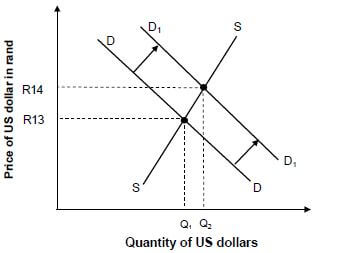
2.2.1 Identify the exchange rate system in the graph above. (1)
2.2.2 What was the original rand/dollar exchange rate before the demand for US dollars increased? (1)
2.2.3 Briefly describe the term exchange rate. (2)
2.2.4 How has the increased demand for US dollars affected the value of the rand? (2)
2.2.5 What could the South African Reserve bank do to strengthen the value of the rand against the dollar? (2 x 2) (4)
2.3 Study the table below and answer the questions that follow.
NATIONAL ACCOUNT AGGREGATES – SOUTH AFRICA | |
SUMMARY OF GROSS DOMESTIC PRODUCT (AT CURRENT PRICES) | R million 2016 |
Compensation of employees | 2 051 326 |
Gross value added at factor cost | 3 795 141 |
Other taxes on production | 86 008 |
Gross value added at basic prices | 3 871 214 |
Taxes on products | 484 059 |
Gross domestic product at market prices | (A)? |
[Source: Quarterly Bulletin SARB, June 2017]
2.3.1 Identify the factor of production in the table above that receives the biggest portion of the national income. (1)
2.3.2 Which method was used to calculate the figures above? (1)
2.3.3 Briefly describe the term basic prices. (2)
2.3.4 Briefly explain how subsidies can influence production. (2)
2.3.5 Calculate the gross domestic product at market prices (A). Show ALL calculations. (4)
2.4 Briefly discuss pricing policy and parastatals as problems of public sector provisioning. (2 x 4) (8)
2.5 Calculate the change in aggregate income if there is an injection of R20 billion into the economy with a marginal propensity to save of 0,3. Show how the multiplier effect could influence the government to create more jobs.
Show ALL calculations. (8) [40]
QUESTION 3: ECONOMIC PURSUITS 40 MARKS – 30 MINUTES
3.1 Answer the following questions.
3.1.1 Name any TWO redress policies that South Africa has used since 1994. (2 x 1) (2)
3.1.2 What effect will increased urbanisation have on the economy? (1 x 2) (2)
3.2 Study the cartoon below and answer the questions that follow. 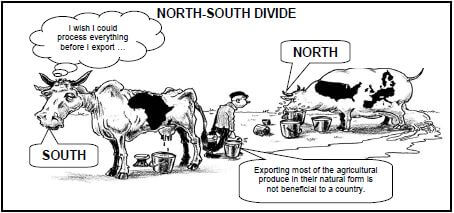
[Adapted from www.wikipedia, 2016]
3.2.1 Name any ONE agricultural product exported to countries in the north. (1)
3.2.2 Give any reason for the poor economic conditions of the countries in the south. (1)
3.2.3 Briefly describe the term North-South divide. (2)
3.2.4 Explain standards of living of countries in the Northern Hemisphere. (2)
3.2.5 What positive impact will globalisation have on the North-South divide? (2 x 2) (4)
3.3 Study the extract below and answer the questions that follow.
SMALL BUSINESS DEVELOPMENT IN SOUTH AFRICA Small, medium and microenterprises are the engines of growth in South Africa, and contribute between 52% and 57% of the GDP. It provides 60% of all jobs, compared to the corporate and public sectors combined. The government provides training, employment subsidies and financing to SMMEs. [Adapted from Stats SA Quarterly Labour Force Survey, 2016] |
3.3.1 What positive effect could small business development have on markets? (1)
3.3.2 Why is it important that the government provides financial aid to SMMEs? (1)
3.3.3 Briefly describe the term economically active population. (2)
3.3.4 Briefly explain how the Department of Trade and Industry (DTI) supports small business development in South Africa. (2)
3.3.5 How can the establishment of more SMMEs be promoted in South Africa? (2 x 2) (4)
3.4 How can the Critical Infrastructure Programme (CIP) and the Foreign Investment Grant (FIG) improve industrial development in South Africa? (2 x 4) (8)
3.5 Evaluate the potential success of special economic zones in South Africa. (8) [40]
QUESTION 4: MACROECONOMICS AND ECONOMIC PURSUITS
40 MARKS – 30 MINUTES
4.1 Answer the following questions.
4.1.1 Give any TWO examples of production indicators. (2 x 1) (2)
4.1.2 Why do developed countries favour the idea of free trade? (1 x 2) (2)
4.2 Study the graph below and answer the questions that follow. 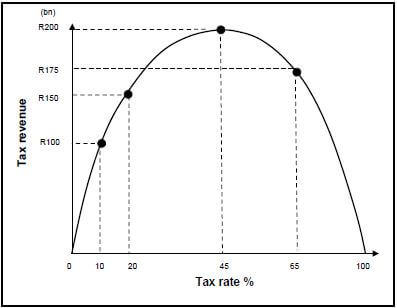
4.2.1 Identify the curve in the graph above. (1)
4.2.2 At what tax rate will government revenue be maximised? (1)
4.2.3 How much revenue will the government receive if the tax rate is 100%? (2)
4.2.4 What effect will a decrease in the tax rate from 65% to 45% have on tax revenue? (2)
4.2.5 What consequences could a 1% VAT increase have on the different role players in the South African economy? (2 x 2) (4)
4.3 Study the bar graph below and answer the questions that follow.
GROSS DOMESTIC PRODUCT – AN ECONOMIC INDICATOR 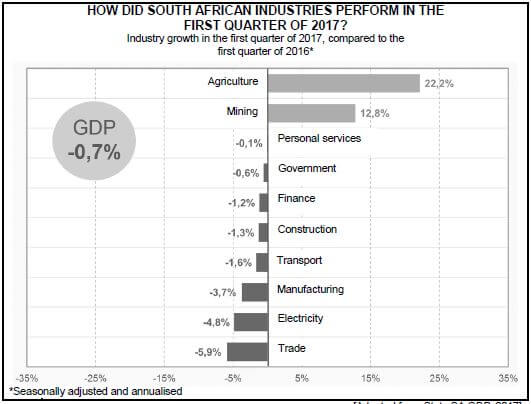
[Adapted from Stats SA GDP, 2017]
4.3.1 Which figure indicates that the GDP growth rate was not satisfactory? (1)
4.3.2 Identify the sector that contributed least to the GDP above. (1)
4.3.3 Give a reason why trade performed so poorly in respect of the total GDP. (2)
4.3.4 Why are only real GDP figures used to compare economic production that occurred in different years? (2)
4.3.5 What can the South African government do to ensure a better economic growth performance? (2 x 2) (4)
4.4 Briefly discuss health as a social indicator. (4 x 2) (8)
4.5 How can developing countries ensure the survival of labour-intensive industries in a global economy? (8) [40]
TOTAL SECTION B: 80
SECTION C
Answer any ONE of the two questions in this section in the ANSWER BOOK.
Ensure that your answer follows the structure indicated below in order to obtain maximum marks:
STRUCTURE OF ESSAY | MARK ALLOCATION |
Introduction
| Max. 2 |
Body | Max. 26 Max. 10 |
Conclusion
| Max. 2 |
TOTAL | 40 |
QUESTION 5: MACROECONOMICS 40 MARKS – 40 MINUTES
- Discuss ALL the features underpinning the forecasting of business cycles, excluding the economic indicators. (26 marks)
- Why is price stability important to prevent extreme fluctuations in business cycles? (10 marks) [40]
QUESTION 6: ECONOMIC PURSUITS 40 MARKS – 40 MINUTES
- Discuss the demand-side approach in promoting economic growth. (26 marks)
- Evaluate the success of the expanded public works programme to reduce poverty and unemployment. (10 marks) [40]
TOTAL SECTION C: 40
GRAND TOTAL: 150
ECONOMICS PAPER 2 GRADE 12 QUESTIONS - NSC EXAMS PAST PAPERS AND MEMOS NOVEMBER 2018
ECONOMICS
PAPER 2
GRADE 12
NSC EXAMS
PAST PAPERS AND MEMOS NOVEMBER 2018
INSTRUCTIONS AND INFORMATION
- Answer FOUR questions as follows in the ANSWER BOOK:
SECTION A: COMPULSORY
SECTION B: Answer TWO of the three questions.
SECTION C: Answer ONE of the two questions. - Answer only the required number of questions. Answers in excess of the required number will NOT be marked.
- Number the answers correctly according to the numbering system used in this question paper.
- Write the question number above each answer.
- Read the questions carefully.
- Start EACH question on a NEW page.
- Leave 2–3 lines between subsections of questions.
- Answer the questions in full sentences and ensure that the format, content and context of your responses comply with the cognitive requirements of the questions.
- Use only black or blue ink.
- You may use a non-programmable pocket calculator.
- Write neatly and legibly.
QUESTIONS
SECTION A (COMPULSORY)
QUESTION 1 30 MARKS – 20 MINUTES
1.1 Various options are provided as possible answers to the following questions. Choose the answer and write only the letter (A–D) next to the question numbers (1.1.1 to 1.1.8) in the ANSWER BOOK, e.g. 1.1.9 D.
1.1.1 Unit cost is also known as … cost.
- marginal
- total
- average
- variable
1.1.2 The nature of the product traded in a pure oligopoly is …
- differentiated.
- homogenous.
- heterogeneous.
- unique.
1.1.3 The term 'long run' refers to a period where … factors of production can change.
- both variable and fixed
- only variable
- only fixed
- floating
1.1.4 A fresh-produce market is a good example of a/an … market structure.
- monopolistic competitive
- monopoly
- perfect competitive
- oligopoly
1.1.5 The Minister of … is responsible for fiscal policy to stabilise the economy.
- Tourism
- Finance
- Trade
- Environmental Affairs
1.1.6 The government can levy a/an … tax on environmental polluters.
- import
- personal income
- consumption
- green
1.1.7 The tourism industry is … intensive.
- capital
- money
- technology
- labour
1.1.8 The granting of a licence to businesses that allow them to pollute up to a certain degree is referred to as …
- marketable permits.
- legislation.
- taxable permits.
- licencing. (8 x 2) (16)
1.2 Choose a description from COLUMN B that matches the item in COLUMN A. Write only the letter (A–I) next to the question numbers (1.2.1 to 1.2.8) in the ANSWER BOOK.
COLUMN A | COLUMN B |
1.2.1 Pareto efficiency |
(8 x 1) (8) |
1.3 Give ONE term for each of the following descriptions. Write only the term next to the question numbers (1.3.1 to 1.3.6) in the ANSWER BOOK. Abbreviations, acronyms and examples will NOT be accepted.
1.3.1 The cost that remains the same even if the output changes
1.3.2 A market structure where the individual firms are price-takers
1.3.3 The additional revenue earned when sales increase by one more unit
1.3.4 Low growth, high unemployment and high inflation rates occur simultaneously
1.3.5 The type of tourism where tourists come to South Africa to visit museums and art galleries
1.3.6 Resources that can be replaced or regenerated (6 x 1) (6)
TOTAL SECTION A: 30
SECTION B
Answer any TWO of the three questions in this section in the ANSWER BOOK.
QUESTION 2: MICROECONOMICS 40 MARKS – 30 MINUTES
2.1 Answer the following questions.
2.1.1 Give any TWO examples of natural monopolies. (2 x 1) (2)
2.1.2 What is the main purpose of markets in the economy? (1 x 2) (2)
2.2 Study the extract below and answer the questions that follow.
NEW AMENDMENTS TO COMPETITION ACT The government introduced the Competition Act, 1998 (Act 89 of 1998) to promote competition and enhance the efficiency of the South African economy. The Competition Commission, Competition Tribunal and Competition Appeal Court play an important role in the administration of the Act. [Adapted from Businesstech.co.za, 2016] |
2.2.1 Which institution imposes fines on companies that are guilty of collusion? (1)
2.2.2 What is the role of the Competition Appeal Court? (1)
2.2.3 State any ONE aim of the competition policy. (2)
2.2.4 How does competition in the market benefit the consumer? (2)
2.2.5 Briefly discuss the success of the competition policy of South Africa. (2 x 2) (4)
2.3 Study the graph below and answer the questions that follow. 
2.3.1 What is the selling price of the business above? (1)
2.3.2 Identify the letter in the graph above that represents the loss minimising point. (1)
2.3.3 Briefly describe the term monopoly. (2)
2.3.4 Why is the equilibrium position above typical of the short run? (2)
2.3.5 Determine the loss for this business. Show ALL calculations. (4)
2.4 With the aid of a well-labelled graph (cost and revenue curves), explain the shut-down point for the individual firm in a perfect market. (8)
2.5 Evaluate the impact of collusion on the economy. (8) [40]
QUESTION 3: CONTEMPORARY ECONOMIC ISSUES 40 MARKS – 30 MINUTES 3.1
Answer the following questions.
3.1.1 Give any TWO examples of consumer inflation. (2 x 1) (2)
3.1.2 What is the main purpose of preservation? (1 x 2) (2)
3.2 Study the information below and answer the questions that follow.
SOUTH AFRICA'S INFLATION REACHES ITS LOWEST LEVEL SINCE 2015 South African food prices grew at a slower rate in July 2017 than in June 2017. In June the general price level increased by 5,1%, while in July it increased by 4,6%. This led to the Reserve Bank reducing its repo (repurchase) rate by 50 base points. This was a major change from 2012 when the inflation rate was 6,5%. |
|
[Adapted from www.google.co.za]
3.2.1 Identify, in the information above, the inflation rate that falls outside the inflation target range. (1)
3.2.2 Give ONE reason for the decrease in the inflation rate. (1)
3.2.3 Briefly describe the term repo (repurchase) rate. (2)
3.2.4 How will a decrease in the inflation rate benefit low-income earners? (2)
3.2.5 How can price stability affect the economy positively? (2 x 2) (4)
3.3 Study the cartoon below and answer the questions that follow. 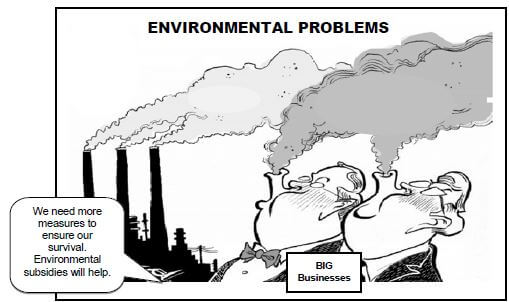
[Source: www.wikipedia, 2017]
3.3.1 Identify the type of pollution in the cartoon above. (1)
3.3.2 What major environmental problem can result from the business activities above? (1)
3.3.3 Briefly describe the term environmental sustainability. (2)
3.3.4 What impact will environmental problems have on food security (continuous food production)? (2)
3.3.5 How can environmental subsidies be used to ensure sustainable development in South Africa? (2 x 2) (4)
3.4 Briefly discuss demand-pull inflation and cost-push inflation. (2 x 4) (Maximum 4 marks each) (8)
3.5 Why have the international measures (agreements) been ineffective in reducing the effects of climate change? (8) [40]
QUESTION 4: MICROECONOMICS AND CONTEMPORARY ECONOMIC ISSUES 40 MARKS – 30 MINUTES
4.1 Answer the following questions.
4.1.1 Give any TWO examples of hazardous waste that affects the environment. (2 x 1) (2)
4.1.2 Why are merit goods normally undersupplied by the market? (1 x 2) (2)
4.2 Study the extract below and answer the questions that follow.
FAST-FOOD RESTAURANTS IN THE MONOPOLISTIC South Africa's fast-food market is extremely competitive, as many sellers fight it out for their share of the consumer market. The fast-food industry accounts for about 40% of the total consumer food-service sales in South Africa, e.g. Fishaways selling fish and Steers selling hamburgers. It is regarded as a hybrid market structure. [Adapted from City Press, February 2017] |
4.2.1 Give ONE example of a monopolistic competitor that specialises only in chicken. (1)
4.2.2 Identify the concept that describes a combination of perfect competition and monopoly. (1)
4.2.3 Why does branding play a major role in monopolistic competition? (2)
4.2.4 Give a reason why businesses in the monopolistic competitive market prefer to compete on a non-price basis. (2)
4.2.5 Why will the economic profit made by a monopolistic competitor disappear in the long run? (2 x 2) (4)
4.3 Study the information below and answer the questions that follow. 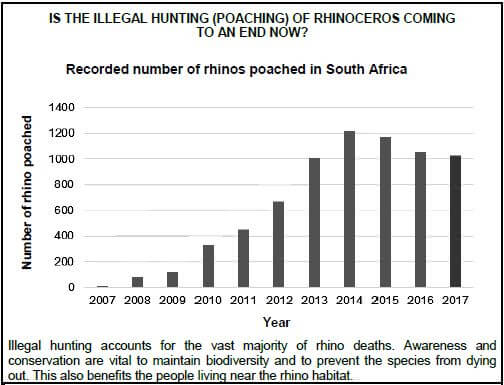
[Adapted from www.PoachStatsSA, 2017]
4.3.1 What is the main reason for the poaching of rhinos? (1)
4.3.2 In which year was rhino poaching at its worst in South Africa? (1)
4.3.3 Briefly describe the term biodiversity. (2)
4.3.4 Give ONE example of how awareness of the natural fauna and flora can be created. (2)
4.3.5 How will conservation benefit the people living near the rhino habitat? (2 x 2) (4)
4.4 With the aid of graphs, briefly explain how price is determined for an individual producer in a perfect market. (8)
4.5 How can South African households contribute to a lower inflation rate? (8) [40]
TOTAL SECTION B: 80
SECTION C
Answer any ONE of the two questions in this section in the ANSWER BOOK.
Ensure that your answer follows the structure indicated below in order to obtain maximum marks:
STRUCTURE OF ESSAY | MARK ALLOCATION |
Introduction
| Max. 2 |
Body | Max. 26 Max. 10 |
Conclusion
| Max. 2 |
TOTAL | 40 |
QUESTION 5: MICROECONOMICS 40 MARKS – 40 MINUTES
- Discuss, with the aid of graphs, the consequences of market failure under the following headings:
- Producer subsidies (8 marks)
- Maximum prices (8 marks)
- Minimum wages (10 marks) (26 marks)
- With reference to the graph below, analyse how a negative externality can result in the misallocation of resources.
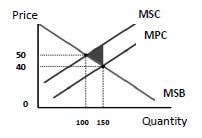
QUESTION 6: CONTEMPORARY ECONOMIC ISSUES 40 MARKS – 40 MINUTES
- Discuss the effects of tourism. (26 marks)
- Evaluate the success of indigenous knowledge systems (IKS) in promoting tourism in South Africa. (10 marks) [40]
TOTAL SECTION C: 40
GRAND TOTAL: 150
ECONOMICS PAPER 2 GRADE 12 MEMORANDUM - NSC EXAMS PAST PAPERS AND MEMOS NOVEMBER 2018
ECONOMICS
PAPER 2
GRADE 12
NSC EXAMS
PAST PAPERS AND MEMOS NOVEMBER 2018
MEMORANDUM
SECTION A (COMPULSORY)
QUESTION 1
1.1 MULTIPLE-CHOICE QUESTIONS
1.1.1 C - average ✓✓
1.1.2 B - homogenous ✓✓
1.1.3 A - both variable and fixed ✓✓
1.1.4 C - perfect competitive ✓✓
1.1.5 B - finance ✓✓
1.1.6 D - green ✓✓
1.1.7 D - labour✓✓
1.1.8 A - marketable permits ✓✓ (8 x (16)
2)
1.2 MATCHING ITEMS
1.2.1 E - When it is impossible to increase the welfare of one without decreasing the welfare of another ✓
1.2.2 F - Actual expenditure of a business, e.g. wages and interest ✓
1.2.3 A - Occurs where average revenue is equal to average cost ✓
1.2.4 I - Products that differ, i.e. not similar ✓
1.2.5 B - A sustained decline in the general price level over a period of time ✓
1.2.6 C - Measures that ensure the maximum level of resources used, e.g. tons of fish caught ✓
1.2.7 D - Uncontrolled removal of vegetation in an unsustainable way ✓
1.2.8 G - It is calculated on a basket of goods only ✓ (8 x (8)
1)
1.3 GIVE THE TERM
1.3.1 Fixed ✓
1.3.2 Perfect ✓
1.3.3 Marginal ✓
1.3.4 Stagflation ✓
1.3.5 Cultural/Paleo ✓
1.3.6 Renewable ✓ (6 x 1) (6)
TOTAL SECTION A: 30
SECTION B
Answer TWO of the three questions in this section in the ANSWER BOOK.
QUESTION 2: MICROECONOMICS
2.1 Answer the following questions.
2.1.1 Give any TWO examples of natural monopolies
- Eskom ✓
- De Beers Diamonds ✓
- Water provisioning (to a specific province like Sebideng water / Bloem-water / Umgeni water) ✓
(Accept any other correct relevant response) (2 x 1) (2)
2.1.2 What is the main purpose of markets in the economy?
- Markets bring buyers and sellers together / to determine a price/ regulate the production of goods and services / allocate resources / mechanism to exchange goods and services ✓✓
(Accept any other correct relevant response) (1 x 2) (2)
2.2 DATA RESPONSE
2.2.1 Which institution imposes fines on companies that are guilty of collusion?
- Competition tribunal ✓ (1)
2.2.2 What is the role of the competition appeal court?
- Amend or confirm decisions of the competition tribunal ✓
(Accept any other correct relevant response) (1)
2.2.3 State any ONE aim of the competition policy.
- To prevent monopolies from abusing their power ✓✓
- To regulate the formation of mergers ✓✓
- To stop firms from fixing prices or dividing markets ✓✓
- Promotes fair competition, to enhance economic development to open up opportunities for transformation of the economy ✓✓
- Provide consumers with competitive prices and variety of products ✓✓(2)
2.2.4 How does competition in the market benefit the consumer?
The consumer benefits from:
- larger variety to choose from ✓✓
- lower prices paid for products ✓✓
- better quality of goods and services ✓✓
- equal opportunities to participate in the economy ✓✓
(Accept any other correct relevant response) (1 x 2) (2)
2.2.5 Briefly discuss the success of the competition policy of South Africa.
The competition policy has been successful because:
- many businesses were recently charged and found guilty on the abuse of economic power ✓✓
- in most cases where fines were imposed they were upheld ✓✓
- collusion occurred when Absa and other banks were fixing the exchange rate / through the monopolistic behaviour by Mittal Steel✓✓
- increase in employment through SMME due to their opportunity to enter the market ✓✓
- provision is made for new criminal sanctions to be imposed on individuals ✓✓
- cartel behaviour is prohibited by section 4 (1) (b) of the act. The penalty for participation is a fine up to 10% of the firm’s annual turnover ✓✓
- they prohibited and regulated mergers for example Mass Mart and Wall Mart ✓✓
(Accept any other correct relevant response) (2 x 2) (4)
2.3 DATA RESPONSE
2.3.1 What is the selling price for the business above?
- R150 ✓ (1)
2.3.2 Identify the letter on the graph that represents the loss minimising point.
- c ✓(1)
2.3.3 Briefly describe the term monopoly.
- A market structure where only one seller / producer / manufacturer / supplier operates ✓✓
(Accept any other correct relevant response) (2)
2.3.4 Why is the above equilibrium position typical of the short-run?
- An economic loss is only possible for the monopolist in the short run / monopoly always makes an economic profit in the long-run / labelling of graphs does not indicate long-run ✓✓
(Accept any other correct relevant response) (2)
2.3.5 Determine the loss for this business. Show ALL calculations.
- Loss = Total Revenue - Total Cost
= (150 x 100) - (200 x 100) ✓
= 15 000 ✓ - 20 000 ✓
= - 5 000 ✓
OR
Loss = unit loss (200 - 150) ✓ x quantity (100) ✓
= 50 x 100 ✓
= - 5 000 ✓(2 x 2) (4)
2.4 With the aid of a well-labelled graph (cost and revenue curves) explain shutdown-point for the individual firm in a perfect market.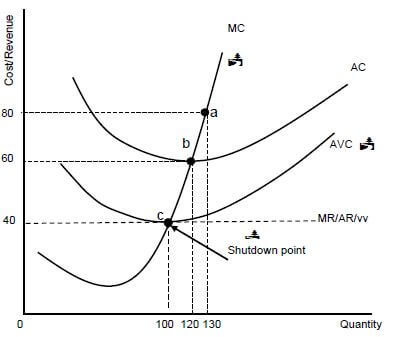
Mark allocation
- Correct positioning of the AVC curve 1 mark
- Correct positioning of MC curve 1 mark
- Correct indication of shutdown point 2 marks
Max 4- it is important that a firm's revenue covers it average variable costs orvariable costs to stay in business ✓✓
- The lowest level of production is 100 where AR = AVC / MC = AVC(shutdown point) ✓✓
- The firm will not produce at prices lower than R40 as AR will be less thanAVC ✓✓
(Accept any other correct relevant response) (Max 6) (8)
2.5 Evaluate the impact of collusion in the economy.
Collusion will impact the economy negatively by:
- reducing competitiveness in the long run by decreasing GDP and employment ✓✓
- allowing price fixing, market sharing and output control by cartels and price leadership ✓✓
- creating scarcity in order to increase prices while also protecting inefficient suppliers ✓✓
- forcing community, consumers, businesses and even governments to pay higher prices for goods and services ✓✓
- distorting economic markets and slowing down innovation because there is little incentive to spend money on research and development ✓✓
Collusion will impact the economy positively by:
- benefiting the supplier by logically fixing prices ✓✓
- benefiting third parties ✓✓ e.g. OPEC (oil cartel) and Greenpeace actually have similar interests - OPEC artificially increase the price of oil through collusion. This reduces quantity consumed. This decreases the 'amount' of negative externalities of pollution ✓
- benefiting the government through increased revenue via indirect taxes on inflationary prices✓✓
(Accept any other correct relevant response) (8)
(Allocate a maximum of 2 marks for the mere listing of facts/examples) [40]
QUESTION 3: CONTEMPORARY ECONOMIC ISSUES
3.1 Answer the following questions.
3.1.1 Give any TWO examples of consumer inflation.
- CPI - headline✓
- Core ✓
- Administered ✓ (2 x 1)
(Accept any other correct relevant response) (2)
3.1.2 What is the main purpose of preservation?
- To prevent the extinction of plant and animal species / to ensure that non-renewable resources are not lost forever ✓✓
(Accept any other correct relevant response) (1 x 2) (2)
3.2 DATA RESPONSE
3.2.1 Identify from the information above the inflation rate that falls outside the inflation target range.
- 6.5% ✓(1)
3.2.2 Give ONE reason for the decrease in the inflation rate.
- Food prices grew at a slower rate ✓
- Lower consumer demand ✓
- Increased agricultural production ✓
- A low brent crude oil price ✓
- Effectiveness of the monetary and fiscal policies / less spending ✓✓
(Accept any other correct relevant response) (1)
3.2.3 Briefly describe the term repo (repurchase) rate.
- It is the rate that commercial banks pay the SARB when borrowing money / Rate at which the Reserve bank lends money to commercial banks ✓✓
(Accept any other correct relevant response). (2)
3.2.4 How will a decrease in the inflation rate benefit the low income earners?
- It will enable low income earners to satisfy more needs ✓✓
(Accept any other correct relevant response) (2)
3.2.5 How can price stability affect the economy positively?
Price stability will influence the economy positively by:
- reducing inflation expectations among consumers, businesses and workers ✓✓
- allowing businesses to make investments in long term projects knowing that prices will be stable ✓✓
- increasing foreign direct investment to benefit economic growth through mass production ✓✓
- allowing consumers to make better decisions that can result in an increase in aggregate demand and economic growth ✓✓
(Accept any other correct relevant response) (2 x 2) (4)
3.3 DATA RESPONSE
3.3.1 Identify the type of pollution in the cartoon above.
- Air pollution / atmospheric pollution ✓ (1)
3.3.2 What major environmental problem can result from the business activities above?
- Climate change / global warming ✓ (1)
(Accept any other correct relevant response)
3.3.3 Briefly describe the term environmental sustainability.
- Environmental sustainability is the ability of the environment to survive its use for economic activity / it refers to meeting the needs of the present generation without compromising the needs of future generations ✓✓
(Accept any other correct relevant response) (2)
3.3.4 What impact will environmental problems have on food security (continuous food production)?
- limiting production due to extreme droughts and floods that might cause heat waves or veld fires ✓✓
- hazardous waste and chemical waste will reduce quality, limit quantities and contaminate food ✓✓
- forcing producers to change their production processes due to a changing climate and cultivate different products which may not be in demand ✓✓
(Accept any other correct relevant response) (2)
3.3.5 How can environmental subsidies be used to ensure sustainable development in South Africa?
- Subsidies can be granted to businesses to reduce environmental damage by recycling of bottles, cans and cardboards ✓✓
- The government can subsidize new technology that saves energy ✓✓ such as energy saving light bulbs or solar geysers,air power to reduce air pollution ✓
- promoting environmentally friendly substitutes like unleaded petrol ✓✓
(Accept any other correct relevant responses) (Max 4) (4)
3.4 Briefly discuss demand-pull inflation and cost-push inflation.
Demand Pull Inflation:
- Demand-pull inflation occurs when aggregate demand in an economy exceeds aggregate supply ✓✓
- Groups responsible for demand inflation are consumers (no savings), businesses (create more credit) and government (less tax is levied) ✓✓
- Foreigners contribute to inflation by increasing the demand for our goods and services through increased exports ✓✓
- A relative increase in aggregate demand components of C, I, G and M ✓✓
- Too much money is chasing too few goods ✓✓
- Increase in wages without an increase in productivity ✓✓ (Max 4)
(Accept any other correct relevant response)
(Allocate a maximum of 2 marks for mere listing of facts/max 1 for example)
Cost Push Inflation
- An increase in labour costs due to aggressive trade union negotiations ✓✓
- Producers increase profits - prices rise more than the rise in production cost ✓✓
- State imposes a higher VAT rate ✓✓
- Expensive imported products (intermediate goods) cause an increase in the prices of locally finished goods ✓✓
- Lower productivity but the same remuneration ✓✓
- Natural disasters i.e. floods or droughts increase the cost of production ✓✓
- Increased total costs on the supply side ✓✓ (Max 4)
(Accept any other correct relevant response)
(Allocate a maximum of 2 marks for mere listing of facts/max 1 for example) (8)
3.5 Why have the international measures (agreements) been ineffective in reducing the effects of climate change?
International measures have been ineffective because:
- there’s a lack of commitment from governments to meet targets set by agreements / monitoring policies ✓✓
- emission targets are not met, and the effects of climate change is more visible than ever before, leading to a loss in GDP and a decrease in employment ✓✓
- it is difficult to identify organizations responsible for holding these countries accountable for their actions ✓✓
- there is a lack of strict law enforcement where penalties were not imposed on those who did not meet targets ✓✓
- conflicting interests existed between the goal of achieving sustainable development and that of increased economic development ✓✓
- big polluters (like the US) failed to meet the targets set by Kyoto protocol and still contribute to global warming and are less interested in solving the crisis due to expensive technology to reduce pollution ✓✓
(Accept any other correct relevant answers) (8)
(Allocate a maximum of 2 marks for mere listing of facts/examples) [40]
QUESTION 4: MICROECONOMICS AND CONTEMPORARY ECONOMIC ISSUES
4.1 Answer the following questions.
4.1.1 Give any TWO examples of hazardous waste affecting the environment.
- Pesticides ✓
- Toxic metal waste (lead, mercury, oil spills) ✓
- Radio-active waste (using nuclear fuel rods) ✓
(Accept any other correct relevant response) (2 x 1) (2)
4.1.2 Why are merit goods normally undersupplied by the market?
- The market only produces goods that are profitable / Some goods are highly desirable for the general welfare of the people but not highly rated by the market / private cost exceeds private benefit / if they had to be paid for, relatively little would be consumed ✓✓
(Accept any other correct relevant response) (1 x 2) (2)
4.2 DATA RESPONSE
4.2.1 Give ONE example of a monopolistic competitor that only specialises in chicken.
- KFC ✓
- Chicken Licken✓
- Nando's ✓
- Hungry lion ✓
(Accept any other correct relevant response) (1)
4.2.2 Identify the concept that describes a combination of perfect competition and a monopoly.
- '… hybrid …' / monopolistic competition ✓ (1)
4.2.3 Why does branding play a major role in monopolistic competition?
- Branding differentiate between products from competitors and builds customer loyalty ✓✓
(Accept any other correct relevant response) (2)
4.2.4 Give a reason why businesses in the monopolistic competitive market prefer to compete on a non-price basis.
- Non-price competition allows them to focus on the uniqueness of the product which can increase sales ✓✓
- They do not compete based on price because it causes price wars and can drive prices down due to many sellers ✓✓
(Accept any other correct relevant response) (2)
4.2.5 Why will the economic profit made by a monopolistic competitor disappear in the long-run?
Economic profit will disappear in the long run because:
- profits attract new businesses easily into the market making it more competitive ✓✓
- increased competition will lead to a decrease in prices which will reduce profits ✓✓
- there can be an increase in the number of substitute products produced which will reduce the demand✓✓
- this will eventually lead to normal profit by the monopolistic competitor in the long-run ✓✓
(Accept any other correct relevant response) (2 x 2) (4)
4.3 DATA RESPONSE
4.3.1 What is the main reason behind the poaching of Rhinos?
- Rhino horn/Money ✓
(Accept any other correct relevant response) (1)
4.3.2 During which year did South Africa experience its worst year in Rhino poaching?
- 2014 ✓ (1)
4.3.3 Briefly describe the term biodiversity.
- Biodiversity refers to the variety of plants and animals that inhabit the earth ✓✓
(Accept any other correct relevant response) (2)
4.3.4 Give ONE example how an awareness of the natural fauna and flora can be created.
- Making children and adults more aware of environmental issues through the media and school visits ✓✓
- Setting up community wildlife reserves as national parks ✓✓
- Field trips, guided environmental tours ✓✓
- Use the media like facebook or the radio to create an awareness ✓✓
(Accept any other correct relevant response) (2)
4.3.5 How will conservation benefit the people living near the Rhino habitat?
Local people will benefit from all the spin-offs from the development of wildlife reserves by:
- using a variety of infrastructure like roads, water, transport and shopping facilities ✓✓
- enjoying more job opportunities that will lead to an increase in the standard of living ✓✓
- improving entrepreneurial abilities through manufacturing of handcrafts ✓✓
- enjoying social benefits like clinics and community activities ✓✓
(Accept any other correct relevant response) (2 x 2) (4)
4.4 With the aid of graphs, briefly explain how price is determined for an individual producer in a perfect market.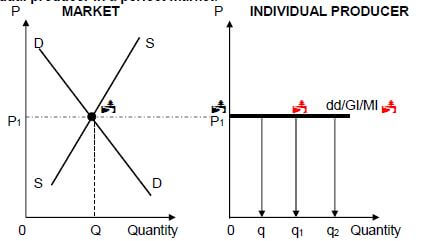
Mark allocation:
Interaction of supply and demand = 1 mark
Link between market price and the price of the individual firm = 1 mark
Correct drawing of demand curve of individual producer = 1 mark
Correct labelling of demand curve of individual producer = 1 mark
Max. 4 marks
- The market forces of demand and supply determines the price (OP1) ✓✓
- The sellers are too insignificant to influence the market price, hence they are price takers ✓✓
- Each individual producer is forced to sell his goods at market price. Thus the demand curve is flat/horizontal/perfectly elastic (curve dd) ✓✓
- The individual producer will not increase his price because he would not be able to sell any products, nor lower his price because he will be able to sell all his products at market price ✓✓
(Accept any other correct relevant response) (Max 6) (8)
4.5 How can South African households contribute to a lower inflation rate?
South African households can contribute to a lower inflation rate by:
- saving a bigger portion of their income makes money available to contribute towards capital formation by businesses ✓✓
- limiting luxurious spending on goods and services to their disposable income ✓✓
- demanding wages which are in line with the current inflation rate ✓✓
- increasing their productivity to ensure that the money they receive for their labour matches the income they receive ✓✓
- reducing the demand for loans and other forms of credit ✓✓
- reduce industrial actions that may reduce production of goods and services ✓✓
(Accept other correct relevant response)
(Allocate a maximum of 2 marks for the mere listing of facts/examples) (8) [40]
TOTAL SECTION B: 80
SECTION C
Answer any ONE of the two questions in this section in the ANSWER BOOK.
QUESTION 5: MICROECONOMICS
- Discuss the consequences of market failure with the aid of graphs under the following headings:
- Producer Subsidies (8)
- Maximum prices (8)
- Minimum wages (10) (26 marks)
- With reference to the graph below, analyse how a negative externality result in the misallocation of resources. [40]
INTRODUCTION
Market failure is when the market fails to produce sufficient (optimum) quantities that people want. ✓✓
(Accept any other relevant introduction) Max (2)
MAIN PART
Producer Subsidies
- A subsidy is a form of financial grant to support the production of a good or service by the government by lowering the cost of production ✓✓
- Subsidies can be direct (e.g. cash grants) or indirection (e.g. depreciation ite-off) ✓✓

- The market price decrease from P to P2, and the quantity consumed will increase from Q to Q1 due to the subsidy paid by government ✓✓
- The producer benefits from a subsidy/producer's profit increases (the difference between P and P2) ✓✓
- The consumer benefits from a subsidy by paying less (price decreased from P to P1) ✓✓
- Producer subsidies are often given to suppliers of agricultural products such as milk, wheat and maize ✓✓ (Max. 6)
Maximum Prices
- Sometimes the government will set the price of a good or service at a maximum price that is below the market price/The government intervenes and passes a law that suppliers may not charge more than the maximum price ✓✓
- Maximum price are usually set on basic goods, such as food and transport so that citizens have access to certain goods and services and achieve a certain minimum standard of living ✓✓

Mark allocation
Original equilibrium 1 mark
Indication of quantity change 1 mark
Indication of maximum price 2 mark
Max 4 marks
- In the figure above, the maximum price is set at P1, while the market price is at P ✓✓
- The immediate effect would be that the quantity supplied will drop from Q to Q1 ✓✓
- The shortage caused by the price ceiling creates a problem of how to allocate the good since the demand will exceed the supply ✓✓
- Black markets often develop where illegal goods are bought or sold ✓✓ (Max 6)
Minimum Wages
- When the government enforces a minimum wage, it means workers have to be paid a certain minimum remuneration that will lead to a higher standard of living / increased satisfaction of wants ✓✓
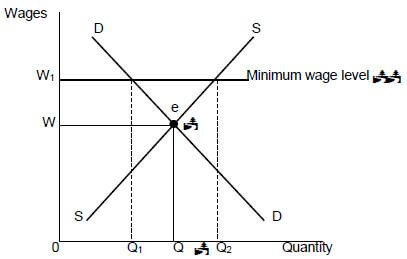
Mark allocation
Original equilibrium point = 1 mark
Indication of quantity change = 1 mark
Indication of min wage = 2 marks
Max 4 marks
- The graph shows that if the wage rate is set at W, the corresponding demand and supply of labour will be Q ✓✓
- If a minimum wage of W1 is set, the demand for labour will decrease from Q to Q1. Some people may become unemployed ✓✓
- However, the supply of labour will increase from Q to Q2. As more people will offer their labour because of a higher income ✓✓
- Minimum wages will lead to more bargaining power of workers ✓✓ (Max 8)
(Accept any other correct relevant response)
(Allocate a maximum of 8 marks for the mere listing of facts/examples) (Max. 26)
ADDITIONAL PART
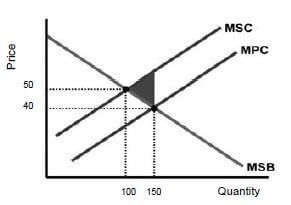
A negative externality results in the misallocation of resources :
- Because external costs are not included in the price when the market produces 150 units ✓✓
- If external costs are included the supply will decrease and market will produce at 100 units at a higher price of R50, that is socially desirable ✓✓
- Since the market does not take external cost into account it over-produces thus more resources than it socially desirable is used ✓✓
- harming other producers or consumers through the behaviour of certain producers that impact negatively on the cost structure of other participants✓✓
- charging a price of R40 for quantity 150 sold, that represents only private cost (MPC)✓✓
- reaching the socially optimal point of production if social cost is taken into account, that will lead to a price increase to 50 and the quantity reducing to 100✓✓
- producing too much of a good which has a negative externality (welfare loss) indicated by the shaded area on the graph ✓✓
- at R40 if the market is left to its own devices, a quantity of 150 will be produced (socially insufficient) ✓✓ (Max 10)
CONCLUSION
Government involves itself directly in the market when the market does not act in the interest of society ✓✓
(Accept any other correct relevant higher order response) Max (2)
QUESTION 6: CONTEMPORARY ECONOMIC ISSUES
- Discuss the effects of tourism. (26 marks)
- Evaluate the success of indigenous knowledge systems (IKS) in promoting tourism in South Africa. (10 marks) [40]
INTRODUCTION
Tourism is the activities of people travelling to and staying in places outside their usual environment for no more than one consecutive year for leisure, business and other purposes. ✓✓
(Accept any other correct relevant introduction) (Max. 2)
BODY: MAIN PART
GDP ✓
- Tourism is the fourth-largest industry in South Africa and supports about 700 hotels, 2 800 guesthouses and bed-and-breakfast establishments and 10 000 restaurants ✓✓
- Tourism has the potential of bringing the economy out of a slump, although it dropped by 5% before 2010, it increased by 5% thereafter ✓✓
- Tourism has direct as well as indirect impacts on the GDP.
Direct impact Indirect impact Tourism contributed 3% of the GDP in 2018 Tourism contributed 9% in 2018 Internal spending on travel and tourism by residents and non-residents for business and leisure Government and private sector spending such as purchase of new aircrafts and construction of new hotels
Employment ✓
Tourism:
- industry employs about 7% of the South African workforce, and is potentially regarded as the largest provider of jobs and earner of foreign exchange ✓✓
- industry has employed more than 1,2 million people ✓✓
- is ideal for providing employment in areas that offer few employment opportunities ✓✓
- is labour intensive although it has the lowest ratio of investment to employment creation ✓✓
- uses different skills, from accountants to hairdressers ✓✓
- has the potential to create jobs and offer opportunities for small entrepreneurs ✓✓
- provides immediate employment like live entertainment at holiday resorts ✓✓
- provides entrepreneurial opportunities in the informal sector such as fruit vendors ✓✓
Poverty ✓
- The income the tourism industry earns contributes to the country's growth and development. Tourism can affect the lives of the poor in many ways ✓✓
- The Department of Tourism is involved in poverty relief projects that promote community owned tourism products and services ✓✓
- Poverty relief programme manages and administer poverty relief proposals and spin-off projects in the tourism and environment sectors ✓✓
- Their focus is on infrastructure investment (e.g. information centres, tourist ablution facilities, walkways) and product development (e.g. heritage sites, rock art and conservation) ✓✓
- Through this programme, the DEAT is seeking to provide long-term sustainable work opportunities for the members of South Africa's poorest communities in rural areas ✓✓
- Tourism is an effective mechanism for distributing resources to rural areas to develop them as tourist sites✓✓
Tourism externalities ✓
- Tourism activities may result in benefits or costs to third parties who are not part of the buyer-seller market ✓✓
- Negative externalities: Aircraft noise disturbing residents near airports ✓✓
- Other examples/costs: Traffic and congestion, extra policing due to crime, increased health service and sanitation, destruction of flora and fauna, spoiling views of the landscape, increased maintenance of infrastructure ✓
- Positive Externalities: the Gautrain provides links to different areas speedily especially to the airport ✓✓
- Other benefits are new recreational amenities, increased direct and indirect tax revenue ✓✓
- Tourism can cause inflation, which makes some goods unaffordable to locals ✓✓
The environment ✓
- The influx of tourism and vehicles into conservation areas damages grass cover affecting plant and animal species. ✓✓
- Tourism involves transport and transport is a major 'source of pollution' ✓✓
- Policy should be in place to ensure tourists are transported in the most environmentally friendly way ✓✓ e.g. Rickshaw at the beachfront, horse-riding, cycling ✓
- The use of the Gautrain is more environmentally friendly as it decreases carbon emissions ✓✓
- The rapid degradation of the environment poses a major threat to the tourism industry ✓✓
- The environment is divided in four main categories: permanent environmental restructuring like airports ✓✓ direct environmental stress caused by tourist activities ✓✓
- effects on population dynamics ✓✓
Investment/ infrastructure ✓
- Tourism leads to increased demand, which makes business more willing to invest in capital goods and labour✓✓
- Government expenditure on infrastructure is encouraged because it can generate income ✓✓
- With regard to travel and tourism, infrastructure includes fixed passenger transportation investment, destination services such as power, water and sewerage, cleaning and health, fixed communications investments ✓✓
- South Africa has a first-world infrastructure; however, there is a lack of infrastructure in the rural areas, which limits the participation of the rural communities in the tourism industry ✓✓
- The absence of adequate transportation services also prevents rural communities from participating in the tourism industry, both as potential suppliers of products, and as tourists themselves ✓✓
- Energy infrastructure like electricity needed by tourists at tourist sites ✓✓
- Tourists need basic services like clean water and refuse removal ✓✓
(Accept any other relevant response)
(Allocate a maximum of 8 marks for the mere listing of facts/examples) (Max 26)
ADDITIONAL PART
Evaluate the success of indigenous knowledge systems (IKS) in promoting tourism in South Africa.
Indigenous Knowledge Systems (IKS) is successful in promoting tourism in South Africa by:
- offering unique attractions it encouraged foreign tourists to learn about South Africa's indigenous culture, history and cultural diversity ✓✓
- giving tourists an opportunity to experience the indigenous culture ✓✓ e.g. cultural villages such as Shangana in Mpumalanga and Basotho in Free State ✓
- offering inexpensive cultural tours based on indigenous knowledge ✓✓
- encouraging government to create policies to protect, develop and promote indigenous knowledge systems ✓✓ e.g. medicine, arts and crafts ✓
- expanding the experiences of tourists in township by visiting places ✓✓such as Soweto where they can eat and drink at a shebeen ✓
- displaying African art and culture ✓✓ e.g. music the National Arts festival held in Grahams town caters for this need ✓
- developing sites of cultural and historical importance ✓✓ such as Robben Island ✓
(Accept other correct relevant response) (Max. 10)
CONCLUSION
Marketing of tourism products to both domestic and international markets is important for achieving the full growth potential of the sector in South Africa ✓✓ [40]
(Accept any other correct relevant higher order response) (Max. 2)
TOTAL SECTION C: 40
GRAND TOTAL: 150
ECONOMICS PAPER 1 GRADE 12 MEMORANDUM - NSC EXAMS PAST PAPERS AND MEMOS NOVEMBER 2018
ECONOMICS
PAPER 1
GRADE 12
NSC EXAMS
PAST PAPERS AND MEMOS NOVEMBER 2018
MEMORANDUM
SECTION A (COMPULSORY)
QUESTION 1
1.1 MULTIPLE-CHOICE QUESTIONS
1.1.1 D - four ✓✓
1.1.2 B - injection ✓✓
1.1.3 C - expenditure ✓✓
1.1.4 A - mass production ✓✓
1.1.5 A - gross national ✓✓
1.1.6 B - industrial development zone ✓✓
1.1.7 C - terms of trade ✓✓
1.1.8 A - per capita gross domestic product ✓✓ (8 x (16)
2)
1.2 MATCHING ITEMS
1.2.1 I - the transfer of functions and ownership of entities from the private to the public sector ✓
1.2.2 F - it shows income and expenditure estimates for a three year period ✓
1.2.3 G - prescribed by the United Nations to compile the gross domestic product figures ✓
1.2.4 E - the movement of income and expenditure between participants in the economy ✓
1.2.5 H - a trade policy that tries to keep the domestic economy safe by restricting the import of goods and services ✓
1.2.6 D - measures income inequality and wealth ✓
1.2.7 A - the number of years a person will live after birth ✓
1.2.8 C - the indicator used to measure the change in prices of goods produced locally when it leave the factory floor ✓ (8 x (8)
1)
1.3 GIVE THE TERM
1.3.1 Balance of payments ✓
1.3.2 Transfer payment ✓
1.3.3 Dumping ✓
1.3.4 Economic growth ✓
1.3.5 Repo rate / repurchase rate ✓
1.3.6 Monetary ✓ (6 x 1) (6)
TOTAL SECTION A: 30
SECTION B
Answer TWO of the three questions in this section in the ANSWER BOOK.
QUESTION 2: MACROECONOMICS
2.1 Answer the following questions.
2.1.1 Name the TWO financial markets in the circular flow model.
- Money ✓
- Capital ✓
- Foreign exchange market / Forex ✓(2 x 1) (2)
2.1.2 What effect will a decrease in income levels have on international trade?
- A decrease in income levels implies less money to spend on goods and services internationally ✓✓
- decrease in demand domestically and internationally which will reduce international trade ✓✓
(Accept any other correct relevant response) (1 x 2) (2)
2.2 DATA RESPONSE
2.2.1 Identify the exchange rate system depicted in the graph above. Free floating ✓ (1)
2.2.2 What was the original rand/dollar exchange rate before the demand for US dollar increased?
- R13,00 = $1 ✓ (1)
2.2.3 Briefly describe the term exchange rate.
- The rate at which one currency is exchanged for another / the value of one country's currency in terms of another country's currency ✓✓ (2)
2.2.4 How has the increased demand for US dollars affected the value of the rand?
- The value of the rand depreciated from R13,00 to R14,00 against the dollar / depreciated by R1 / rand has weakened ✓✓ (2)
2.2.5 What could Reserve Bank do to strengthen the value of the rand against the dollar?
The Reserve Bank could strengthen the value of the rand by:
- selling US dollars in reserve in the foreign exchange market to create an oversupply ✓✓
- selling gold reserves on the international market to create an oversupply ✓✓
- obtaining assistance (financial support) from the International Monetary Fund to increase the inflow of foreign exchange ✓✓
- increasing the repo rate to stimulate investment by foreigners in the South African economy ✓✓
(Accept any other correct relevant response) (2 x 2) (4)
2.3 DATA RESPONSE
2.3.1 Identify the factor of production in the table above, which receives the biggest portion of the national income.
- Labour ✓ (1)
2.3.2 Which method was used to calculate the above figures? Income ✓ (1)
2.3.3 Briefly describe the term basic prices.
- Basic prices is the cost to the producer adding taxes on production and subtracting subsidies on production ✓✓ (2)
(Accept any other correct relevant response)
2.3.4 Briefly explain how subsidies can influence production.
- Subsidies on products are payable by government to suppliers to: reduce their costs of production / encourages them to increase output ✓✓ (2)
2.3.5 Calculate the Gross Domestic Product at market prices (A). (Show all calculations)
- Gross value added at basic prices 3 871 214 ✓
- PLUS: Taxes on products 484 059 ✓
- MIN : Subsidies on products 16 415 ✓
- GDP at Market Prices 4 338 858 ✓
OR - 3 871 214 + 484 059 – 16 415 = 4 338 858 (4)
2.4 Briefly discuss pricing policy and parastatals as problems of public sector provisioning.
Pricing policy:
- State-owned enterprises do not work within the market system of demand and supply ✓✓
- It creates problems in determining the price for public goods and services compared to the private sector where price is determined by demand and supply ✓✓
- The state sets the price of goods in the following ways:
- Free of charge: providing community or collective goods such as policing or health is completely funded by increased taxes, placing a burden on taxpayers ✓✓
- User charges: e-toll fees levied on the users of those roads are mostly not paid ✓✓
- Subsidies: Government may charge the user at a reduced fee ✓✓
- It is difficult for government to establish the correct pricing ✓✓ (Max 4)
(Accept any other correct relevant response)
(A maximum of 2 marks may be allocated for mere listing of facts/examples, 1 max)
Parastatals:
- Service provisioning of parastatals such as Eskom and Transnet lead to monopolies ✓✓
- SOEs are created when government starts a new business or nationalize an existing one ✓✓
- These typical monopolies are known for high prices where the consumer has no say ✓✓
- Inefficiency in service provisioning such as SAA led to irregular service delivery and a waste of state revenue ✓✓
- Infrastructure is mostly provided by government and sometimes lacks maintenance ✓✓ (Max 4)
(Accept any other correct relevant response)
(A maximum of 2 marks may be allocated for mere listing of facts/examples, 1 max)
Candidates should indicate the challenge to government, because they do not have a market system to determine prices (2 marks).
The other two marks can be allocated for any other fact related to the topic. (8)
2.5 Calculate the change in aggregate income, if there is an injection of R20bn in the economy with a marginal propensity to save of 0.3, and show how the multiplier effect could influence the government to create more jobs. Show ALL calculations.
- Calculation:
- Injection = R20bn
- mps = 0.3
- Multiplier = 1
mps
= 1 ✓
0.3
= 3.3 ✓ - Change in National Income = R20bn x 3.3 ✓
= R66bn / R66,6 / R67 ✓ (Max 4)
- Jobs created there will result in more income and spending in the economy which will lead to even more jobs being created – knock-on effect ✓✓
- Government can also decrease taxation, putting more money in the pockets of the consumer. The extra money will be spent by the consumer, leading to increased employment ✓✓
- Government can decrease company taxes that might lead to increased investment by businesses focussing on labour intensive production (8) methods ✓✓ (Max 4) [40]
(Accept any other correct relevant higher order response)
(If candidates used the figures calculated to explain the effect, marks should be allocated)
QUESTION 3: ECONOMIC PURSUITS
3.1 Answer the following questions.
3.1.1 Give any TWO redress policies that South Africa used since 1994.
- RDP
- Black economic empowerment (BEE) ✓
- Broad–based black economic empowerment (BBBEE) ✓
- Affirmative action / Employment equity ✓
- Land redistribution ✓
- Land restitution ✓
- Education ✓ (2 x 1) (2)
3.1.2 What effect will increased urbanisation have on the economy?
An economy with increased urbanisation might experience a/an:
- lack of services ✓✓
- shortage of schools and/or houses ✓✓
- shortage of land ✓✓
- increase in unemployment ✓✓
- increase in population in urban areas ✓✓
- per capita income increases ✓✓
- helps with the overall development of the economy ✓✓
- the demand for goods and services may lead to increased GDP✓✓
(Accept any other correct relevant response) (1 x 2) (2)
3.2 DATA RESPONSE
3.2.1 Name any ONE agricultural product exported to countries in the North.
- Milk / meat / nuts / wheat / oranges ✓
(Accept any other correct relevant response) (1)
3.2.2 Give any reason for the poor economic conditions of the countries in the South.
A lack of:
- skills / capital / investment / good education / good governance✓
(Accept any other correct relevant response) (1)
3.2.3 Briefly describe the term North/South divide.
Refers to developed countries in the Northern hemisphere and the developing countries in the Southern hemisphere, that shows the division between the rich countries of the North and the poorer countries of the South ✓✓
(Accept any other correct relevant response) (2)
3.2.4 Explain standards of living in countries in the Northern
Hemisphere.
- Real GDP per capita is high in the North ✓✓
- Life expectancy is 75 years in the developed countries ✓✓
- Education and literacy level is high in the North ✓✓
(Accept any other correct relevant response) (2)
3.2.5 What positive impact will globalisation have on the North South divide?
- Poverty levels can be reduced in developing countries by increasing the skills and better the education to the workforce ✓✓
- To ensure better participation in the economy in using the latest technology ✓✓
- Economic growth can improve in developing countries by increased production earmarked for the international market ✓✓
- Production and trade focussing on raw materials being processed before exporting it ✓✓ subsidies awarded in the agricultural sector to ensure enough raw materials for processing in the manufacturing sector✓✓
(Accept any other correct relevant response) (2 x 2) (4)
3.3 DATA RESPONSE
3.3.1 What positive effect would small business development have on markets?
- Markets will be more effective and efficient where a variety of businesses are competing / job creation / better prices for consumers ✓ (1)
(Accept any other correct relevant response)
3.3.2 Why is it important that the government provide financial aid to SMMEs?
- SMMEs contributes to extensively to growth ✓
- Job creation compared to other sectors ✓
- Correcting the imbalances of the past / poverty reduction ✓(1)
- Protecting infant industries from closing down ✓
(Accept any other correct relevant response)
3.3.3 Briefly describe the term economically active population.
- Includes people between the ages of 15 and 64 years who want to work and who are actively looking for work it includes the employed and unemployed ✓✓
(Accept any other correct relevant response) (2)
3.3.4 Briefly explain how the department of trade and industry (DTI) supports small business development in South Africa.
- By creating employment for structurally unemployed people ✓✓
- Focussing on incentives for small businesses ✓✓
- Promoting entrepreneurial development amongst women and the youth✓✓ (2)
- By providing easy capital, information and business advice ✓✓
- Providing training in general ✓✓
(Accept any other correct relevant response)
3.3.5 How can the establishment of more SMMEs be promoted in South Africa?
More SMMEs can be promoted by:
- helping them with research and development in their specific areas of performance ✓✓
- providing them with funding ✓✓
- monitoring their business operations and provide support ✓✓
- providing them with tax incentives ✓✓
(Accept any other correct relevant response) Any (2 x 2) (4)
3.4 How can the critical infrastructure programme (CIP) and foreign investment grand (FIG) improve industrial development in South Africa?
Government uses the following incentives to improve industrial development by:
Critical infrastructure programme:
- offering a grant between 10% and 30% of the total development costs of projects designed to improve infrastructure in South Africa (CIP) ✓✓
- ensuring completion of projects by paying out the grants after completion ✓✓ (max 4)
(Accept any other correct relevant response)
(Allocate a maximum of 2 marks for the mere listing of facts/examples, 1 max) Foreign investment grant:
- assisting foreign investors who want to invest in the new manufacturing business in South Africa, by paying a cash incentive (FIG)✓✓
- covering the cost of relocating machinery and equipment from abroad ✓✓
- making it available to any registered company who would like to operate in the manufacturing sector✓✓ (max 4)
(Accept any other correct relevant response)
(Allocate a maximum of 4 marks for the mere listing of facts/examples, 1 max) (2 x 4) (8)
3.5 Evaluate the potential success of special economic zones in South Africa.
- SEZ programme aimed to promote economic growth and industrialisation and achieved limited success with industrialisation ✓✓
- Most outcomes of SEZs expanded the manufacturing sector and created more industries✓✓
- The Manufacturing Circle blueprint to create 1 million manufacturing jobs in the next decade, converting the Vaal Triangle into SEZ✓✓
- Draft legislation set the basis for a broader range of industrial parks and economic infrastructure made provision for effective clustering of employment ✓✓
- China's largest car manufacturer (BAIC) invested in South Africa with a R11 billion plant in Coega (SEZ) ✓✓
- SEZ's broadened the scope set by IDZs and were located in all provinces in areas where SA wanted industrial development through tax incentives ✓✓
- South Africa has companies with knowledge about international markets. Added to the SEZ programme to boost investment, employment, training and exports ✓✓
- The private sector was allowed to propose, set up and manage industrial parks, aligned to objectives of the SEZ. ✓✓
- Private funding was used to finance internal infrastructure that is connected to the national logistics infrastructure ✓✓
- Stumbling blocks still exist such as legislation, consistency and alignment with other policies, approval of six special economic zones in 2018 budget was welcomed ✓✓
(Accept any other correct relevant response) (4 x 2) (8)
(Allocate a maximum of 2 marks for the mere listing of facts/examples) [40]
QUESTION 4: MACROECONOMICS AND ECONOMIC PURSUITS
4.1 Answer the following questions.
4.1.1 Give any TWO examples of production indicators.
- Nominal GDP / GDP at current prices ✓
- Real GDP / GDP at constant prices ✓
- Per capita GDP ✓ (2 x 1) (2)
4.1.2 Why do developed countries favour the idea of free trade?
- Free trade increases competition and this encourages innovation especially in developed countries that have the know-how ✓✓
- Developed countries have free access to resources worldwide, needed for mass production in expanded markets ✓✓
- Developed countries benefit from trade agreements with poor countries ✓✓
- Free trade reduce regulations (regulations on the protection of labour, environment and consumers). Free trade increase power of multinationals ✓✓
(Accept any other correct relevant response) (1 x 2) (2)
4.2 DATA RESPONSE
4.2.1 Identify the curve depicted in the graph.
- Laffer ✓ (1)
4.2.2 At what tax rate will government revenue be maximised?
- 45% ✓(1)
4.2.3 How much revenue will the government receive if the tax rate is 100%?
- No revenue / zero ✓✓ (2)
4.2.4 What effect will a decrease in the tax rate, from 65 – 45%, have on tax revenue?
- A decrease in the tax rate will lead to an increase in tax revenue (from R175 to R200) by encouraging people to work ✓✓
(Accept any other correct relevant response) (2)
4.2.5 What consequences could a 1% increase in VAT have on the different role players in the South African economy?
The increase of VAT by 1% could affect role-players by:
- increasing the revenue to the government if the same/more is spend by businesses and households ✓✓
- resulting in a fall in output (production) because fewer consumers will be able to afford to buy the same goods and services as before ✓✓
- leading to a decline in the satisfaction of wants of consumers, mainly poor consumers in buying luxury goods ✓✓
- causing an increase in tax - especially the high income earners (luxury goods) where they are responsible for 85% of VAT income ✓✓
- 19 basic food items are excluded from VAT ✓✓ that benefit most lower income earners (4)
- leading to a decrease in sales that will reduce profits ✓✓
(Accept any other correct relevant response) (2 x 2)
4.3 DATA RESPONSE
4.3.1 Which figure indicated that the GDP growth rate was not satisfactory?
- -0,7% ✓ (1)
4.3.2 Identify the sector that contributed least to the GDP above.
- Tertiary ✓ (1)
4.3.3 Give a reason why trade performed so poorly to the total GDP above.
- Poor value of the rand ✓✓
- Unrest in certain areas where production is located ✓✓
(Accept any other correct relevant response) (2)
4.3.4 Why are only real GDP-figures used to compare economic production that occurred in different years?
- Real GDP figures are used to make comparisons between different years, because the inflation rate has been removed / figures are not inflated ✓✓ (2)
4.3.5 What can the South African government do to ensure a better economic growth performance?
The government can ensure better economic growth by:
- developing comparative performance standards✓✓
- setting achievable targets ✓✓
- ensuring sufficient and relevant infrastructure development ✓✓
- ensuring effective compliance by all sectors in the economy (4) ✓✓
(Accept any other correct relevant response) (Any 2 x 2)
4.4 Briefly discuss health as a social indicator.
- Infant mortality refers to the number of children that will die before one year of age. This is the only way of measuring the health care of a population ✓✓
- Under-five mortality refers to the number of children that will die before the age of 5 years ✓✓
- Health expenditure is the amount spent on health care as a percentage of GDP ✓✓
- Access to safe drinking water refers to the percentage of a population that has reasonable access to safe drinking water ✓✓
- Access to sanitation facilities is the percentage of a population with at least adequate sanitation facilities that can prevent human, animal and insect contact ✓✓
(Accept any other correct relevant response)
(Allocate a maximum of 4 marks for the mere listing of facts/max 2 for examples) (4 x 2) (8)
4.5 How can developing countries ensure the survival of labour intensive industries in a global economy?
Labour intensive industries could survive in developing countries by:
- protecting jobs and wage levels by limiting unfair competition which may force local industries to reduce production and cut the factors of production ✓✓
- reducing wages or salaries in order to remain competitive in the international market✓✓
- reducing high levels of poverty and unemployment which is of critical importance to protect jobs ✓✓
- protecting labour intensive industries that cannot compete with established foreign competitors ✓✓
- protecting strategic industries e.g. the mining industry needed for long term sustainability ✓✓
(Accept any other correct relevant response)
(Allocate a maximum of 2 marks for the mere listing of facts/examples) (8) [40]
TOTAL SECTION B: 80
SECTION C
Answer any ONE of the two questions in this section in the ANSWER BOOK.
QUESTION 5: MACROECONOMICS 40 MARKS – 40 MINUTES
- Discuss ALL the features underpinning forecasting of business cycles, excluding the economic indicators. (26 marks)
- Why is price stability important to prevent extreme fluctuation in business cycles? (10 marks) [40]
INTRODUCTION
- There are a number of techniques available to help economists to forecast business cycles like economic indicators ✓✓
- A business cycle can be described as successive periods of contraction and expansion of economic activities ✓✓
- The pattern of expansion and contraction of aggregate economic activity, measured as real Gross Domestic Product, displays around its overall trend✓✓
- The process of making predictions about changing conditions of future events that may significantly affect the economy✓✓
(Accept any other correct relevant response) (Max. 2)
BODY: MAIN PART
Extrapolation ✓
- Past data is used, where predictions are made about the future based on assumptions related to trends ✓✓
- Extrapolation means to estimate something unknown from the facts and information that is known ✓✓
- Extending a trend into the future may provide information on what is likely to happen ✓✓
- If a business cycle has passed through a trough and entered into a boom phase, forecasters may predict that the economy will grow in the months to follow ✓✓
- Extrapolation techniques are sometimes used to predict future share prices ✓✓
- The trend of the curve must be followed to complement the completed section.
- Take a calculated decision to continue beyond the level of a resistance point✓✓
Amplitude ✓
- It is the difference between the value of total output between peak and trough measured from the trend line to the peak and trough ✓✓
- Amplitude reflects the intensity of the upswing and downswing in economic activity ✓✓
- The amplitude shows two things:
- The power of the underlying forces, e.g. interest rates, exports or consumer spending ✓✓
- A large amplitude during the upswing signifies strong underlying forces – which result in longer cycles✓✓
- The extent of change: the larger the amplitude, the more extreme the changes that may occur ✓✓
- During an upswing, unemployment may decrease from 20% to 10% (a decrease of 50%) / inflation may increase from 3% to 6% (i.e. 100%) / a surplus on the current account (BOP) can change from a surplus to a deficit ✓✓
Trend ✓
- The trend indicates the general direction in which the indexes that were used in the business cycle, moves ✓✓
- When the economy is growing, there is an upward trend, but when the economy is decreasing, there is a downward trend ✓✓
- The trend will change when the time series data change their behaviour patterns of the past ✓✓
- Resistance points indicates forces in the economy preventing it from repeating the performance – unfavourable forces need to change or be removed for growth to exceed previous tendencies ✓✓
- It normally has a positive slope because the production capacity of the economy increases over time ✓✓
- Channels are formed when output growth reaches successive higher turning points (upward channel) ✓✓
Length ✓
- Length is measured from peak to peak or from trough to trough ✓✓
- Longer cycles show strength and shorter cycles show weakness with regard to economic activities ✓✓
- Cycles may overshoot with the effect that some composite indicators increase to beyond its normal level ✓✓
Moving averages ✓
- This method is repeatedly calculating a series of different average values along a time series to produce a smooth curve ✓✓
- It is used to analyse the changes in a series of data over a certain period of time ✓✓
- To eliminate the effect of sharp fluctuations in the business cycle, economists use moving averages to smooth out the business cycle so that it looks more like a straight of slightly curved line ✓✓
(Accept any other correct relevant response)
(A maximum of 8 marks may be allocated for mere listing of facts/examples)
(Candidates would receive 2 marks if they indicated the amplitude, length and trend line on a graph) (Max 26)
ADDITIONAL PART
Price stability is important in preventing extreme fluctuations in business cycles because it:
- contributes to high levels of economic activity and employment ✓✓
- improves the transparency of the price mechanism so that people can recognise changes in relative prices without being confused by changes in the overall price ✓✓
- allows people to make well-informed consumption decisions ✓✓
- encourages foreign investment to promote growth ✓✓
- helps to allocate resources more efficiently ✓✓
- avoids unproductive activities that are sometimes used to protect one against the impact of high inflation ✓✓
- avoids the risk of deflation which makes it more difficult implement policies guarding against it ✓✓
- implements inflation targeting, by reducing distortion of inflation or deflation which exacerbate the distortionary impact on the economic behaviour of tax and social security ✓✓
- prevents an arbitrary redistribution of wealth and income as a result of unexpected fluctuations ✓✓
- keeps interest rates unchanged to ensure continued growth in the economy without big fluctuations ✓✓
- adapts the cash reserve requirements which will compel banks to limit credit/money in circulation ✓✓
(Accept any other correct relevant higher order response) (Max.10)
Candidates can express the above answer in a negative way, when arguing if price stability is not achieved, e.g. there will be low levels of economic activity and employment
CONCLUSION
Policy makers should closely watch all these indicators because external factors are very significant for South African business cycles✓✓
Different methods can be used in forecasting like the quantitative method that is based on mathematical models or qualitative methods being used in long term forecasting ✓✓
(Accept any other correct relevant higher order response) (Max. 2) [40]
QUESTION 6: ECONOMIC PURSUITS
- Discuss the demand-side approach to promote economic growth. (26 marks)
- Evaluate the success of the Expanded Public Work Programme to reduce poverty and unemployment. (10 marks) [40]
INTRODUCTION
The demand-side approach involves discretionary changes in monetary and fiscal policies with the aim of changing the levels of aggregate demand and supply ✓✓
(Accept any other correct relevant response) (Max 2)
MAIN PART
International best practice argues that developing economies should run their economies in a way that creates economic growth ✓✓
This would help social transformation, human capital formation and redistribution of income ✓✓
A demand-side approach involves discretionary changes in monetary and fiscal policies with the aim of changing the level of aggregate demand ✓✓
- Monetary policy is driven by the South African Reserve Bank (SARB). ✓✓ It is used to influence interest rates and the supply of money in the economy to stabilise prices ✓✓
- Fiscal policy is driven by the Department of Finance. ✓✓ It aims to facilitate government political and economic objectives. ✓✓Governments can use fiscal policy to change taxes and government expenditure which can stimulate or inhibit economic growth and development ✓✓
Monetary policy approach ✓
- The monetary policy approach consists of the decisions by the central bank as part of the monetary authorities to influence the interest rates and money supply in the economy, by implementing inflation targets set by government ✓✓
- The central bank manages the availability of money by means of open market transactions and cash requirements ✓✓
- Manage the cost of money by means of interest rates ✓✓
- Variations in the levels of interest rates increase or decrease the cost of credit and determine the quantity of money through the workings of the money multiplier ✓✓
- Variations of exchange rates for the purpose of the changing terms of trade are used as an auxiliary method to bring about the changes in the stock of money ✓✓
- The South African monetary policy implements the demand–side approach by:
Controlling the repo rate ✓
To affect the interests rates that commercial banks can offer for two purposes: ∙ Influence credit creation by making credit more expensive or cheaper ✓✓ - Stabilise the exchange rates by encouraging capital inflows and outflows in order to take care of a deficit or a surplus on the current account of the balance of payments ✓✓
Conducting open market transactions ✓
- To restrict bank credit, the SARB sells securities and when the banks buy these securities, money flows from the banks to SARB ✓✓
- The banks then have less money to lend and cannot extend as much credit as before ✓✓
- To encourage credit creation, the SARB buys securities in the open market. Money then flows into the banking system✓✓
- Banks use money to create money✓✓
Moral suasion ✓
- The SARB consults with banks and persuades them to act in a manner that is desirable in terms of the economic conditions that prevail at the time ✓✓
- The persuasion is often linked to the transactions by SARB in the money market ✓✓ e.g. the buying and selling of bills and bonds ✓
- If the banks are generous in extending credit, the SARB can call on them to be less lenient. However, simultaneously it can sell paper in the market and drain excess liquidity so that banks have less money to lend ✓✓
South Africa national budget is the main tool to drive fiscal policy and implements the fiscal policy through:
Progressive personal income taxes: ✓
- The higher income earners are taxed at higher rates than lower income earners ✓✓
- These taxes are used to finance social developments / the poor benefit more than those with higher incomes ✓✓
Wealth taxes ✓
- Properties such as houses, offices and factories in the urban areas are taxed annually ✓✓
- Transfer duties are paid when properties are bought or sold ✓✓
- Capital gains tax is levied on gains earned on the sale of capital goods such as property and shares ✓✓
Cash benefits ✓
- old-age pensions, disability grants, child support grants and unemployment insurance are important cash grants ✓✓
- these are also known as social security's payments ✓✓
Benefits in kinds ✓
- These include the provision for healthcare, education and social meals, protection, municipal services and infrastructure ✓✓
- Where user-fee are charged, poor people and low income earners benefit more than others because they pay nothing or less than higher income earners✓✓
- Limited quantities of electricity and water are provided ✓✓
Other redistributions ✓
- Some microeconomic policies have advantage that favour poor and low-income earners ✓✓e.g. EPWP, SIP, SMMEs ✓
Land redistribution and restitution ✓
- The purpose of land restitution is to return land or pay cash to those who lost their land because of discriminatory laws and practice after June 1913 while land redistribution focuses on land for residential purposes and productive use ✓✓
- The aim is to redistribute agricultural land to the previously disadvantaged persons ✓✓
Property subsidies ✓
- Subsidies help beneficiaries to acquire ownership of fixed residential property ✓✓
- Government's housing subsidy schemes provide funding options to all eligible persons earning less than R3 500 per month/ the money for this scheme comes from the main budget ✓✓
A different approach could include:
Consumption spending by consumers ✓
- Increase in production✓
- An increase in the production of goods and services leads to an increase in the disposable income of consumers ✓✓
- Increased production can be the result of increased government spending, higher investment spending by businesses or higher exports ✓✓
- Government fiscal policy ✓
- The government can reduce income tax or indirect tax, such as excise duties on liquor and cigarettes. ✓✓
- Government monetary policy ✓
- By reducing the interest rate, the cost of credit is lowered/households can now afford to borrow more money, increasing their disposable income and consumption spending. ✓✓
- Government programmes to satisfy basic needs ✓
- The government can assist poor households to satisfy their basic needs, such as clean water, healthcare, etc. (economic growth/development) ✓✓
- Investment spending by firms ✓
- Involves investments in factory buildings, machines and tools, called capital formation ✓✓
- These investments increase the production capacity of businesses and the economy ✓✓
- Investments lead to reduced unemployment, which contribute to economic development ✓✓
- The government invests in the infrastructure, such as transport and communication, in support of firms ✓✓
- Government spending in the economy✓
- The government plans its expenditure on public services and economic affairs to ensure economic growth ✓✓
- The government further plans its social expenditure on socio-economic aspects, such as poverty ✓✓
- The public works programme (EPWP) is used to address the problems of unemployment and low income earners ✓✓
- Examples include road construction, road maintenance and low-cost housing ✓
- Exports and imports
- Imports ✓ are important to the South African economy as it provides consumers with a wider choice of goods/services ✓✓
- The wider choice of consumer goods leads to economic development/growth ✓✓
- Imports also provide essential capital goods and intermediate goods, such as machinery, equipment, chemicals, petroleum products and vehicle spares ✓✓
- An increase in economic growth leads to an increase in imports and a deficit on the BOP (current account) ✓✓
- Exports ✓ are part of the domestic demand, as they earn extra income for the exporting firms ✓✓
- Our exports are used to pay for the country’s imports, contributing to increasing economic growth and to control the BOP of the country ✓✓
- Government actions to promote exports include trade agreements, maintaining a realistic exchange rate and providing export incentives ✓✓
- Imports ✓ are important to the South African economy as it provides consumers with a wider choice of goods/services ✓✓
(Accept any other correct relevant response) Max (26) (Allocate a maximum of 8 marks for mere listing of facts/examples)
ADDITIONAL PART
The Expanded Public Work Programme reduced poverty and unemployment by:
- focussing more on previously disadvantaged groups, insuring that measures are implemented to ensure redress and affirmative action in the workplace and business environment ✓✓
- improving the social benefits to the community e.g. health issues can be solved ✓✓
- improving the standard of living, by changing the workers' outlook in life to be able to satisfy more wants ✓✓
- creating employment opportunities for the poor and vulnerable, by using labour intensive methods to be able to accommodate as many people as possible ✓✓
- giving people skills that they can use to find jobs when their work in the EPWP is done ✓✓
- building future entrepreneurial abilities (SMME's) to contribute in solving major unemployment ✓✓
(Max 10) (Accept any other correct relevant response)
CONCLUSION
Sustainable economic growth and development in a country is not a given unless the government applies strict and effective policies to manage the economy ✓✓
(Accept any other correct relevant higher order response) Max (2)
TOTAL SECTION C: 40
GRAND TOTAL: 150
DESIGN PAPER 2 GRADE 12 QUESTIONS - NSC EXAMS PAST PAPERS AND MEMOS NOVEMBER 2018
DESIGN
PAPER 2
GRADE 12
NSC EXAMS
PAST PAPERS AND MEMOS NOVEMBER 2018
INSTRUCTIONS AND INFORMATION
- This question paper consists of TWO sections:
TOPIC 1: The examination sourcebook/workbook (50 marks)
TOPIC 2: The final practical examination product (50 marks)
TOTAL: 100 marks - The question paper has TWO briefs/themes. Choose ONE or COMBINE THE TWO OPTIONS.
QUESTIONS
BRIEF/THEME 1: PLANET EARTH 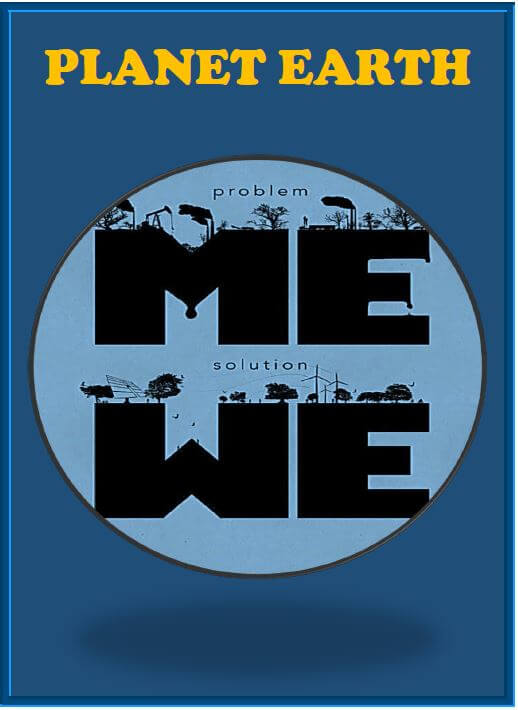
The one thing we all share is PLANET EARTH. – Wendell Berry
We are greeted by Mother Earth's unique and magnificent beauty every day. 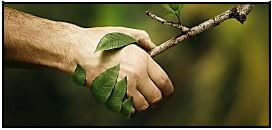
The planet Earth no longer appears as a mysterious and unexplored system. Over millions of years humanity has slowly exploited and plundered the planet of its natural resources. Much of our planet now suffers from a wide range of environmental issues. 
The rapid rate of change on the planet Earth is forcing us to take a new look at the world and our place within it. The millennials (children born in the early 2000s) of today yearn for a pre-industrial, pre-technological world.
Key issues need to be addressed urgently.
We need to help the next generation of scientists, biologists and designers to find solutions to the issues confronting our planet.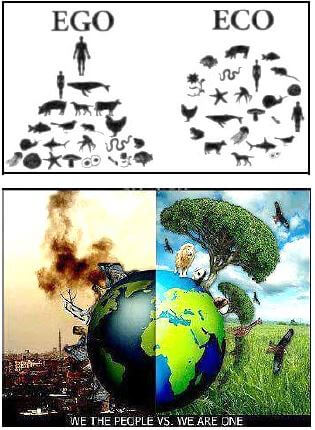
The illustrations above emphasise man in partnership with the planet rather than being in charge. Humankind should respect their place in this symbiotic, biodiverse ecosystem so that it remains habitable for future humanity.
Stephan Hawking, world-renowned theoretical physicist, believed the following:
Within the next thousand years or so, man will make the planet Earth uninhabitable and in a billion years from now the Earth will be a very hot, dry and uninhabitable planet. One way or another, our planet will likely become uninhabitable for mankind in the future. We need to start thinking seriously about how we will free ourselves from the constraints of this dying planet.
THE BRIEF/THEME:
Create an original environmental and/or social design solution based on PLANET EARTH that creates an awareness of the vulnerable beauty that surrounds us.
Use one or more of the design categories below for your design solution.
- VISUAL COMMUNICATION/INFORMATION DESIGN AND/OR DIGITAL DESIGN
Create awareness of our efforts to save/destroy the planet Earth. Use a billboard, poster, website design, brochure, sticker, book illustration, animation, packaging design, graffiti, etc. - SURFACE DESIGN AND TWO-DIMENSIONAL CRAFT DESIGN
Interpret the theme Planet Earth by focusing on inside and outside surfaces, such as upholstery, mosaic designs, wallpaper, carpets and wall finishes. Your design solutions should focus on creating an awareness of the vulnerable beauty that surrounds us. - PRODUCT DESIGN AND THREE-DIMENSIONAL CRAFT DESIGN
Products should be designed to inform people about sustainability and the use of environmentally friendly materials: lights, chairs, shelving, cushions, shoes, furniture, crockery, jewellery, clothing, etc. They can also be a celebration of the beauty of the Earth. - ENVIRONMENTAL DESIGN
To help the next generation of scientists and biologists restore the world, we need to reduce our carbon footprint and create designs that do not pollute or negatively affect the ecosystem or our health. For example, design an eco-friendly environmental model that deals with health: a hospital, a retreat; education: an eco-school; interactive museum and/or green architectural spaces: a green wall or turf-roof building, penthouse gardens, etc.
DO NOT copy the examples provided. 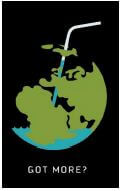
VISUAL COMMUNICATION/INFORMATION DESIGN AND/OR DIGITAL DESIGN 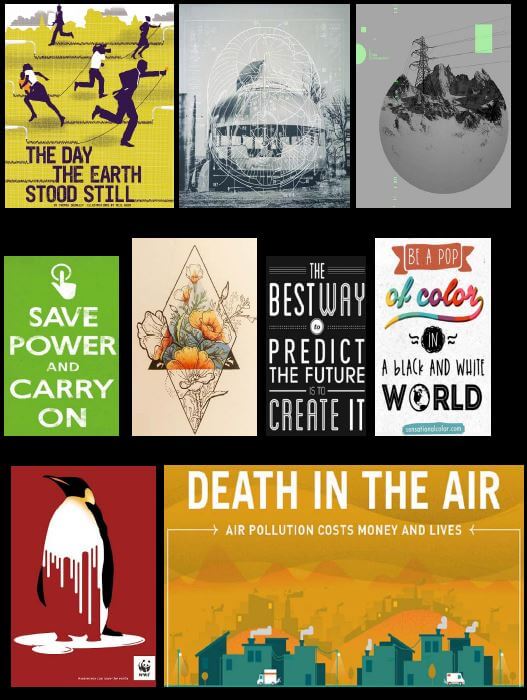
SURFACE DESIGN AND TWO-DIMENSIONAL CRAFT DESIGN 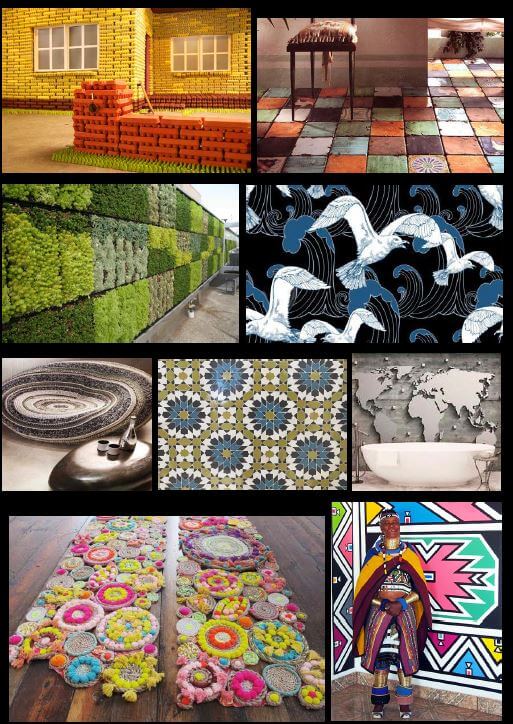
PRODUCT DESIGN AND THREE-DIMENSIONAL CRAFT DESIGN 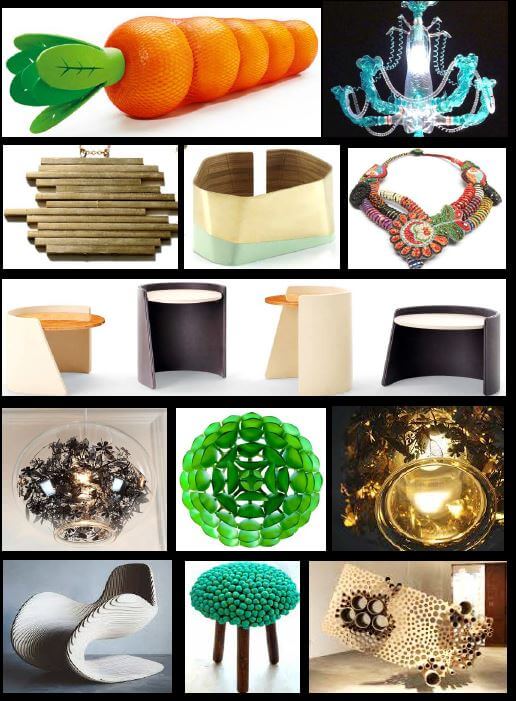
ENVIRONMENTAL DESIGN 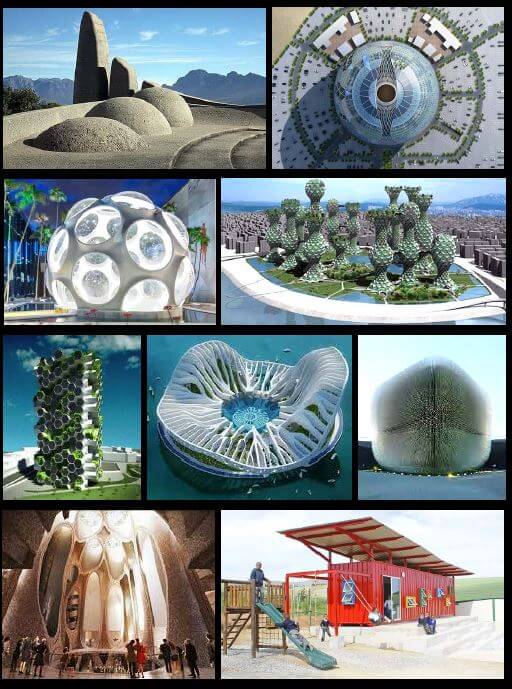
BRIEF/THEME 2: UNCONVENTIONAL DESIGN 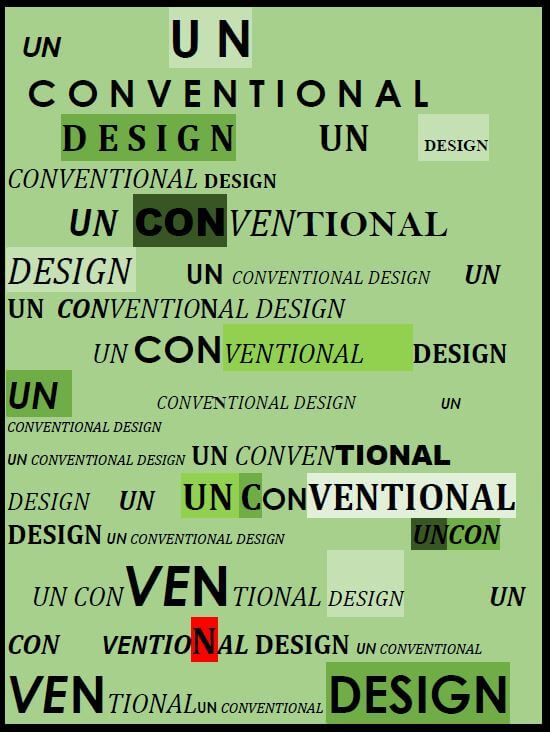
Restraints caused by the economic recession and environmental crisis have contributed to the rethinking of design, design products and processes. Perhaps now, at a time of deep economic anxiety and trouble, we should embrace UNCONVENTIONAL DESIGN trends as they bring life, creativity, entrepreneurship and beauty through the use of alternative, unconventional materials.
From a business perspective the use of unconventional, recyclable and upcycled materials and construction methods can produce possibilities to create and develop new, innovative, exciting design products and offer more entrepreneurial opportunities. 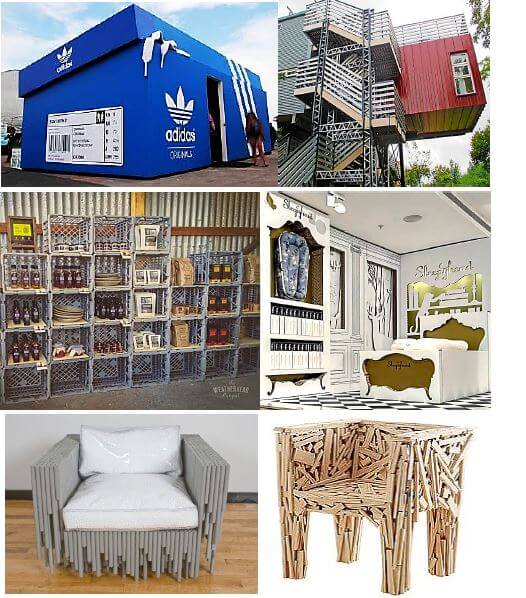
Unconventional design encourages recycling and upcycling, which are common creative solutions used in impoverished areas.
Note the innovative use of cardboard boxes, plastic crates, plastic and glass bottles, and wooden pallets in the images below. 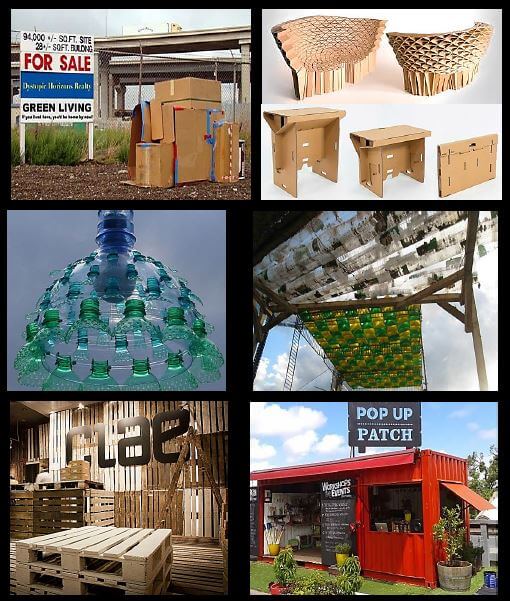
THE BRIEF/THEME:
Create a design in one or more of the design categories below that interpret the theme UNCONVENTIONAL DESIGN in an original and creative manner.
Use one or more of the design categories below for your design solution.
- VISUAL COMMUNICATION/INFORMATION DESIGN AND/OR DIGITAL DESIGN
The focus could be on the branding for an unconventional shop/business, e.g. a logo, letterhead, posters, website design, brochure and promotional items; unconventional or avant-garde ways of communicating a message through the use of original typography, innovative processes, materials and images in presenting creative design solutions. - SURFACE DESIGN AND TWO-DIMENSIONAL CRAFT DESIGN
You can choose to create wallpaper, textiles, mosaics, upholstery, curtaining and cladding of floors, ceilings and walls with unconventional materials or techniques. - PRODUCT DESIGN AND THREE-DIMENSIONAL CRAFT DESIGN
Design any unconventional product, e.g. unusual or eccentric cushions, lights, chairs, shelving, shoes, furniture, crockery, jewellery, lamps, clothing, handbags and accessories. Carefully consider your choice of materials. - ENVIRONMENTAL DESIGN
You may consider creating an actual pop-up shop or display space. Think about the use of natural and/or artificial light to highlight your exhibition space and products. Be innovative with the use of materials, consider the use of recycled and upcycled materials, such as cardboard, plastic, tin, wooden pallets and second hand shipping containers. Do not underestimate the creative possibilities of flat-packed cardboard boxes as building material. You can create a model for an unusual public space, e.g. a park, a piazza, an airport and waterfront.
DO NOT copy the examples provided.
VISUAL COMMUNICATION/INFORMATION DESIGN AND/OR DIGITAL DESIGN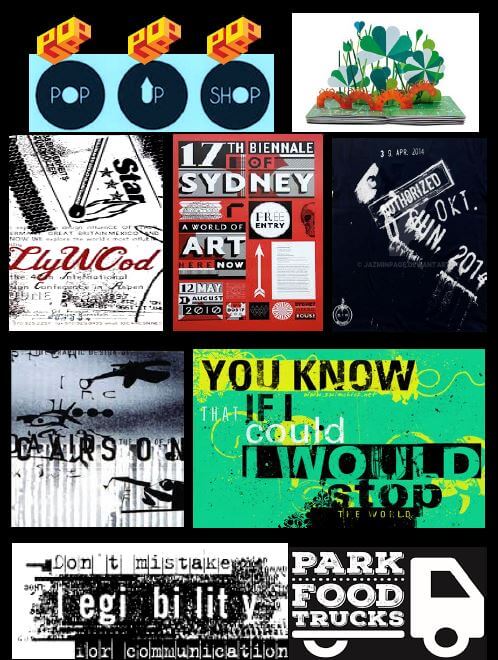
SURFACE DESIGN AND TWO-DIMENSIONAL CRAFT DESIGN 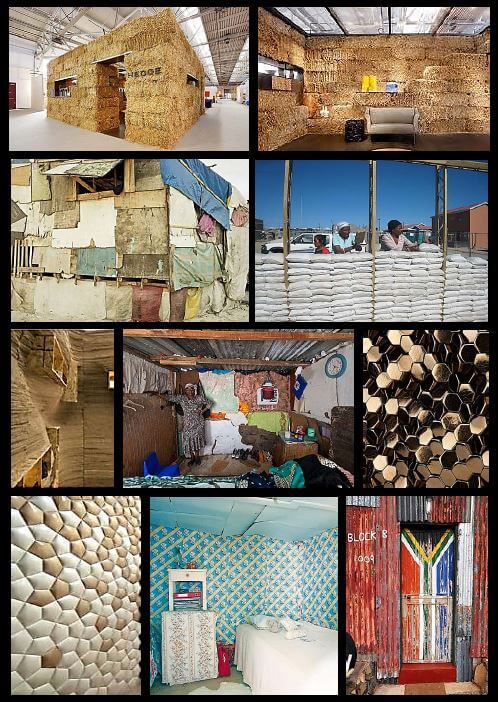
PRODUCT DESIGN AND THREE-DIMENSIONAL CRAFT DESIGN 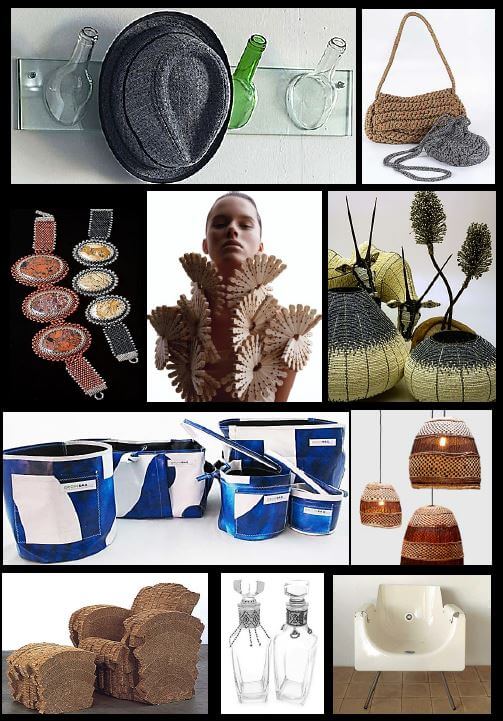
ENVIRONMENTAL DESIGN 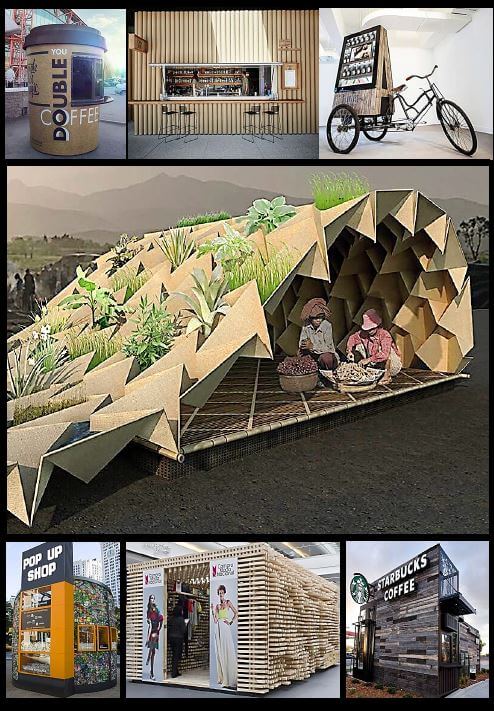
REQUIREMENTS
SECTION A
TOPIC 1: THE DESIGN PROCESS [50]
- All processIpreparatory work for your design must be shown in a sourcebook/workbook.
- This will involve the processes from conceptualisation to realisation.
- Thorough investigation of problems posed by the design brief should be shown.
- The sourcebook/workbook must be presented in the form of an album (that is in book form).
- It must open easily and have pages that turn easily.
- The sourcebook/workbook must be made of a light material to facilitate transport where work is moderated at a central venue.
- Ensure that the sourcebook/workbook is presented professionally.
NOTE:
- As TOPIC 1 (preparation) has the same mark allocation as TOPIC 2 (the final product), it should be given enough time to acknowledge its importance.
- Your teacher may be involved in this preliminary preparatory session only (TOPIC 1).
- ou may work at home.
CRITERIA FOR THE DESIGN PROCESS (TOPIC 1)
You should present the following (refer to the NSC Design Examination Guidelines):
- Expression of intention and rationale (10)
- Evidence of research, experimentation and reflection (10)
- Evidence of detailed planning and presentation related to the final concept (30) [50]
SECTION B
TOPIC 2: THE FINAL PRODUCT [50]
Although it is recommended that a two-dimensional design should NOT be larger than A2 in size, candidates' work is not restricted regarding size.
The size of a three-dimensional design will depend on the function of the object being made. Take into account that the final product might have to be transported to a central marking venue.
NOTE:
- Your teacher may NOT assist you in any way during the final production of the design.
- ALL work must be done under the teacher's and the appointed invigilator's supervision at your school.
- Any form of direct copying/plagiarism or work that is not your original work will be strictly penalised.
- A declaration of authenticity (ADDENDUM A) must be completed by yourself, the chief invigilator and the teacher.
- Work must be done on a continuous basis, e.g. on three consecutive days under controlled circumstances.
CRITERIA FOR THE DESIGN PRODUCT (TOPIC 2)
You should use the following criteria (refer to the NSC Design Examination Guidelines):
- Creativity/Originality/Interpretation in terms of the concept and solutions that are relevant to the brief (10)
- Evidence of design involvement: the appropriate use of design elements and principles (10)
- Technique/Craftsmanship/Method (10)
- The design solution with evidence of at least 12 hours', but not more than 24 hours' work under controlled circumstances (10)
- Professional presentation and functionality of the design solution (10) [50]
TOTAL: TOPIC 1 (50) + TOPIC 2 (50) : 100
INSTRUCTIONS TO THE TEACHER
PRACTICAL EXAMINATION TOPIC 1 (50 MARKS) AND TOPIC 2 (50 MARKS) – TASK 7
- This practical examination consists of ONE question paper. This question paper comprises TWO parts: TOPIC 1 (the examination sourcebookIworkbook and TOPIC 2 (the final practical examination product).
- This practical question paper should be given to the candidates on Friday 20 July 2018. The final submission date will be Friday 19 October 2018.
- TOPIC 1 (design process) has the same weighting as TOPIC 2 (the final product) and it should therefore be given enough time to acknowledge its importance.
- Consequently, candidates should have enough time to do their TOPIC 1 (design process). The teacher may only be involved in this preliminary preparatory session and NOT in TOPIC 2. Due to the preparatory nature of TOPIC 1, candidates are allowed to work at home.
- Candidates must use the TOPIC 1 sourcebookIworkbook as a point of reference during their TOPIC 2 examination. Both TOPIC 1 and TOPIC 2 examination work must be submitted to the teacher/invigilator immediately after the TOPIC 2 examination has been completed.
- The teacher may NOT assist the candidate in any way during the final production of the design product (TOPIC 2).
- Any form of direct copying/plagiarism or work that is not the candidate's original work will be strictly penalised.
- TOPIC 2 must be done on a continuous basis during contact time, e.g. on three consecutive days under controlled circumstances.
- TOPIC 2 must be done at the candidate's examination centre, under the supervision of the teacher/invigilator. TOPIC 2 work may NOT be done at home.
- TOPIC 2 work must NOT be removed from the examination centre under any circumstances.
- Each province will determine the marking process of TOPIC 1 (sourcebookI workbook) and TOPIC 2 (final product). Schools will be notified by the provinces regarding the date, time and venue for the submission of work to the examination centres, where applicable.
- The examination TOPIC 1 should be professionally presented in a sourcebookIworkbook in album format.
- The sourcebook/workbook and final product must be labelled neatly and clearly.
- ADDENDUM A must be completed in full and the school stamp should appear in the appropriate space. Attach ADDENDUM A securely to the final examination work (sourcebook/workbook and/or final product).
ASSESSMENT GUIDELINES
OUTCOMES | REQUIREMENTS | WEIGHTING % | MARKS | |
SOURCEBOOK/WORKBOOK | TOPIC 1 The candidate is able to understand the design process from conceptualisation to realisation. | Expression of intention and rationale | 10 | 50 |
Evidence of research, experimentation and reflection | 10 | |||
Evidence of detailed planning and presentation related to the final concept | 30 | |||
THE FINAL PRODUCT | TOPIC 2 The candidate is able to produce and present a body of work in the chosen discipline(s) which shows an understanding of design skills and production processes. | Creativity/Originality/Interpretation in terms of the concept and solutions that are relevant to the brief | 10 | 50 |
Evidence of design involvement: the appropriate use of design elements and principles | 10 | |||
Technique/Craftsmanship/Method | 10 | |||
The design solution with evidence of at least 12 hours', but not more than 24 hours' work under controlled circumstances | 10 | |||
Professional presentation and functionality of the design solution | 10 | |||
TOTAL | 100 |
NOTE: Teachers and markers must refer to the NSC Design Examination Guidelines and the PAT Guidelines for detailed assessment criteria.
ADDENDUM A
This addendum must be detached, copied, completed, signed and attached to the final examination work (workbook/sourcebook and/or final product).
NOVEMBER 2018 SOURCEBOOK/WORKBOOK
1. | Name of subject | DESIGN |
2. | Code of subject | DSGN |
DECLARATION OF AUTHENTICITY | ||||||||||||||||||
Centre number | ||||||||||||||||||
Examination number | ||||||||||||||||||
District/Circuit | ||||||||||||||||||
Signature and date | School stamp | |||||||||||||||||
Candidate | ||||||||||||||||||
Principal | ||||||||||||||||||
Chief Invigilator/Teacher | ||||||||||||||||||
NOVEMBER 2018 FINAL PRODUCT
1. | Name of subject | DESIGN |
2. | Code of subject | DSGN |
DECLARATION OF AUTHENTICITY | ||||||||||||||||||
Centre number | ||||||||||||||||||
Examination number | ||||||||||||||||||
District/Circuit | ||||||||||||||||||
Signature and date | School stamp | |||||||||||||||||
Candidate | ||||||||||||||||||
Principal | ||||||||||||||||||
Chief Invigilator/Teacher | ||||||||||||||||||
DESIGN PAPER 1 GRADE 12 QUESTIONS - NSC EXAMS PAST PAPERS AND MEMOS NOVEMBER 2018
DESIGN
PAPER 1
GRADE 12
NSC EXAMS
PAST PAPERS AND MEMOS NOVEMBER 2018
INSTRUCTIONS AND INFORMATION
- This question paper consists of SIX questions.
- There are three choice questions in this question paper. Read the options carefully.
- This question paper consists of THREE sections:
SECTION A: Design literacy (30 marks)
QUESTIONS 1 to 3
SECTION B: Design history (30 marks)
QUESTION 4
SECTION C: Design in a sociocultural/environmental and sustainable context (40 marks)
QUESTIONS 5 and 6 - Read the requirements of each question carefully.
- Answer in full sentences and avoid the listing of facts. Do NOT answer in tabular form.
- Use the mark allocation to determine the time to be spent on each question.
- Do NOT repeat the same facts and examples in different questions.
- Write neatly and legibly.
QUESTIONS
SECTION A: DESIGN LITERACY
QUESTION 1: 'UNSEEN' EXAMPLES
Answer EITHER QUESTION 1.1 OR QUESTION 1.2.
1.1 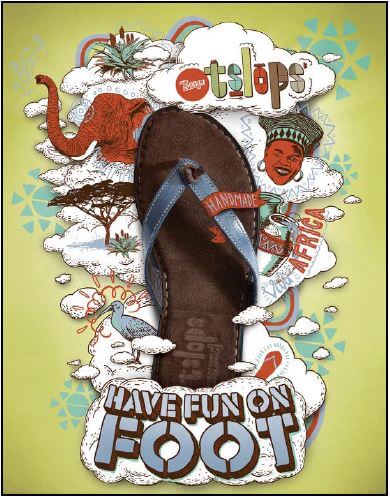
FIGURE A: Tslops Poster by Hylton Warburton (South Africa), 2011.
1.1.1 Analyse the use of the following elements and principles in FIGURE A above:
- Colour
- Contrast
- Focal point
- Unity (4 x 2) (8)
1.1.2 Discuss how unity in diversity is achieved in this poster. Refer to TWO symbols used in FIGURE A above to achieve this. (2) [10]
OR
1.2 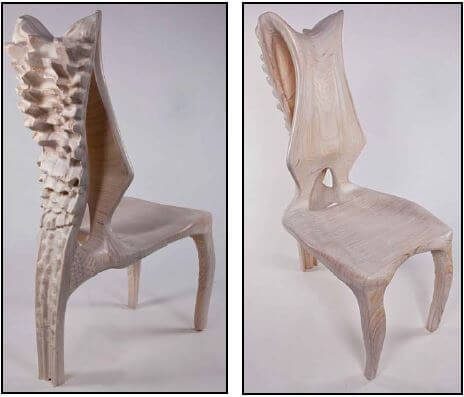
FIGURE B: Exocarp Chair by Guillermo Bernal (Italy), 2015.
Explain the use of the following design terms by referring to FIGURE B above:
- Biomimicry
- Ergonomics
- Form
- Texture
- Balance (5 x 2) [10]
QUESTION 2: COMMUNICATION THROUGH DESIGN 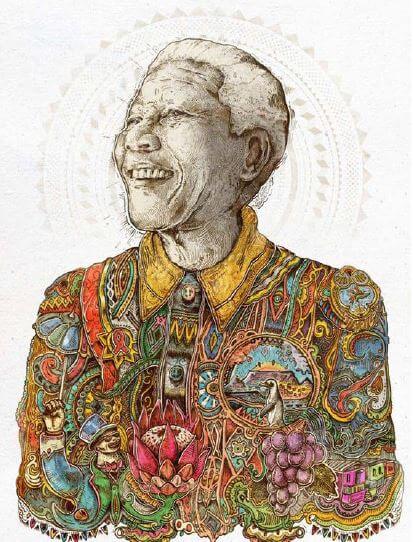
FIGURE C: Nelson Mandela Poster by The Mandela Poster Project, 2013.
2.1 Identify THREE images that have symbolic value AND explain their possible meanings with reference to the poster in FIGURE C above. (6)
2.2 Discuss how the use of colour contributes to communicating the meaning of the poster above. (2)
2.3 Discuss why the poster in FIGURE C may be considered to be biased. (2) [10]
QUESTION 3
Answer EITHER QUESTION 3.1 OR QUESTION 3.2.
3.1 Refer to FIGURE D and FIGURE E below and answer the question that follows. 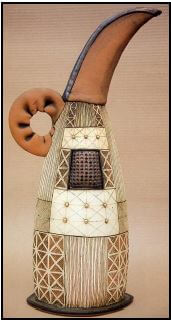
FIGURE D: Teapot by Hennie Meyer (South Africa), 2015. 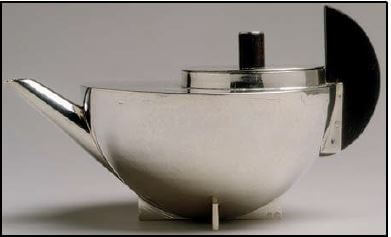
FIGURE E: Tea Infuser and Strainer by Marianne Brandt (Germany), 1924.
Write an essay of at least 200–250 words (ONE page) in which you compare FIGURE D with FIGURE E.
Refer to the following:
- Form
- Production method
- Medium
- Decoration
- Inspiration (5 x 2) [10]
OR
3.2 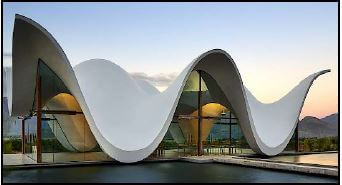
FIGURE F: Bosjes Chapel by Steyn's Studio (South Africa), 2016. 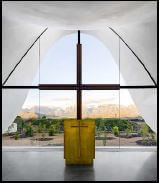
Interior of Bosjes Chapel by Steyn's Studio (South Africa), 2016. 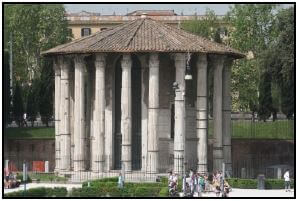
FIGURE G: Temple of Hercules (Italy), 2nd century BCE. 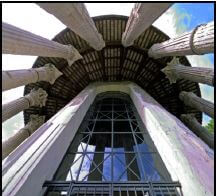
Detail of Temple of Hercules (Italy), 2nd century BCE.
3.2.1 Compare, in a paragraph, the structures and influences on the places of worship above.
3.2.2 Write an essay of at least 120–150 words (half a page) in which you compare the contemporary Steyn's Studio chapel in FIGURE F with the Ancient Roman temple of Hercules in FIGURE G.
Alternatively, you may compare any Classical building that you have studied with any contemporary building that has a similar function.
Refer to the following:
- Materials
- Technology
- Function (3 x 2) (4) (6) [10]
TOTAL SECTION A: 30
SECTION B: DESIGN HISTORY
QUESTION 4
4.1 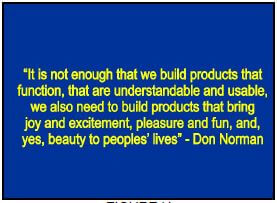
FIGURE H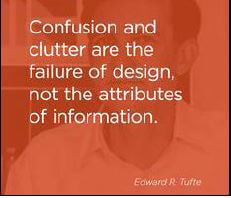
FIGURE I
Select TWO movements from the list below. Write an essay of 400–450 words (TWO pages) in which the one movement reflects the quote in FIGURE H while the other movement reflects the quote in FIGURE I.
Briefly discuss the aims, influences and characteristics of EACH movement, explaining how EACH movement reflects the selected quote. Refer to ONE example and designer of EACH movement in your discussion to motivate your statements.
- Gothic
- Renaissance
- Baroque
- Neoclassicism
- Arts and Crafts
- Art Deco
- De Stijl
- Bauhaus
- Scandinavian
- Pop
- Postmodernism
- Constructivism (20)
4.2
FIGURE J: Book Cover by HM Brock, Art Nouveau (England), 1895. 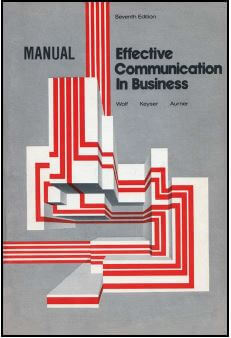
FIGURE K: Book Cover, designer unknown, Modernism (USA), 1950s.
In an essay of 200–250 words (ONE page) compare the two illustrated book covers above to explain why they represent the movements they belong to.
Refer to the following in your discussion:
- Influences
- Aims
- Colour
- Line
- Shape (5 x 2) (10)
TOTAL SECTION B: 30
SECTION C: DESIGN IN A SOCIOCULTURAL/ENVIRONMENTAL AND SUSTAINABLE CONTEXT
QUESTION 5
Answer EITHER QUESTION 5.1 OR QUESTION 5.2.
5.1 
FIGURE L: 'Words kill wars' Poster by Ogilvy & Mather (Japan), 2017.
5.1.1 Explain how the message is portrayed by the poster in FIGURE L above by referring to the following:
- Composition
- Symbolism
- Use of imagery (3 x 2) (6)
5.1.2 Write TWO separate essays of at least 200–250 words EACH (TWO pages in total) in which you name and discuss the works of ONE South African contemporary designer/design group AND ONE international contemporary designer/design group who highlights sociocultural concerns.
Support your discussion with the following:
- A brief analysis of ONE example by EACH designer/design group
- Why can the example above be considered ethical and human centred?
- How are these sociocultural concerns addressed? (Refer to work processes, materials and design ethic.)
You may NOT refer to any designer(s)/design group(s) that you have discussed previously or design examples used in this question paper. (14)
OR
5.2 
FIGURE M: Colour-weaved Collection, only available in South Africa by Converse Chuck Taylor (USA), 2014.
5.2.1 Discuss the role of indigenous crafts in modern society by referring to the design in FIGURE M above.
5.2.2. You are a member of your school's newsletter team. Your team has been asked to write an article discussing a specific indigenous craft practised in South Africa. Write an essay of at least 200–250 words (ONE page) supporting the continued practice of this craft.
Refer to the following in your essay:
- The historical context of this craft
- The social value of this craft
- Materials, methods and processes used
- A brief analysis of ONE work, as well as the name(s) of the cultural group/craftsperson that produced it (2) (8)
5.2.3
It is possible to fuse traditional and modern techniques from two separate cultures to design something that is relevant for the contemporary international market. |
Refer to the statement above and write an essay of approximately 200–250 words (ONE page), discussing ONE South African contemporary designer/design group that uses traditional craft techniques in a modern way.
Refer to the following in your discussion:
- Name of the designer/design group and his/her/their design product(s)
- A detailed description of how traditional techniques/methods and materials have been applied to contemporary design. Refer to specific examples to support your statements.
- A discussion of the sociocultural contribution of the design(s)
You may NOT refer to any designer/design group that you discussed previously or design examples used in this question paper. (10) [20]
QUESTION 6
6.1 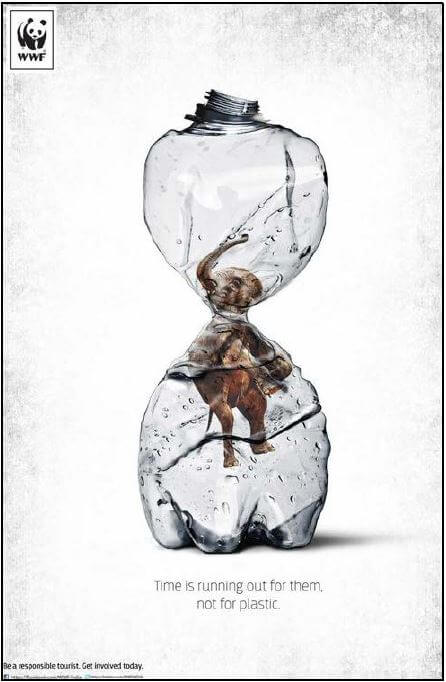
FIGURE N: Plastic Pollution Poster by the World Wide Fund for Nature (India), 2014.
6.1.1 Discuss the aims of the poster in FIGURE N above and explain how these aims are achieved. (4)
6.1.2 Define and compare the terms recycle and upcycle. (2)
6.2 Write TWO separate essays of at least 200–250 words EACH (TWO pages in total) in which you name and discuss the works of ONE South African contemporary designer/design group AND ONE international contemporary designer/design group whose work explores sustainability and transforms materials/sites into significant designs.
Refer to the following in your discussion:
- Name of the designer/design group and his/her/their design product(s)
- A discussion of the aims, design processes and materials of the above designer/design group
- A discussion of ONE example to explain its transformation and impact on the environment
You may NOT refer to any designer/design group that you discussed previously or design examples used in this question paper. (14) [20]
TOTAL SECTION C: 40
GRAND TOTAL: 100
DESIGN PAPER 1 GRADE 12 MEMORANDUM - NSC EXAMS PAST PAPERS AND MEMOS NOVEMBER 2018
DESIGN
PAPER 1
GRADE 12
NSC EXAMS
PAST PAPERS AND MEMOS NOVEMBER 2018
MEMORANDUM
SECTION A: DESIGN LITERACY
'UNSEEN' EXAMPLES
ANSWER EITHER QUESTION 1.1 OR QUESTION 1.2.
QUESTION 1 [10 Marks]
1.1
1.1.1 (Allocate 8 marks)
- Colour: The poster in FIGURE A uses a polychromatic scheme consisting of bold, warm rusts, olive-green, lime-green and a cool grey-blue creating a fun and joyful mood. ? These colours echo the poster's title which instructs the viewer to 'have fun on foot'. ? The colourful images are placed on white clouds which heightens their richness. ? The whiteness of the clouds speaks of purity and freshness. ? The white may also be symbolic of the lightness (weight-wise) of the sandal. ?
- Contrast: The figurative images on the white cloud background are detailed and outlined making them stand out. ? They contrast with the plain, flat, light olive-green background and light turquoise abstract, geometric patterns, images of rainbows and scribbly curvilinear patterns. ? This contrast activates the surface and conveys a sense of festivity. ? The designer's use of different mediums – the photographed suede and leather of the Tsonga Tslops contrast with the cartoon-like illustrations.? A further contrast is seen in the use of large, three-dimensional typography and smaller, flat or two dimensional words. ? The left hand side of the poster has natural images (elephant, tree, bird, aloe plant) which contrasts with the right hand side of the poster which has mostly man made items (traditional vessels, sandal and traditional hat worn by the woman). ? The large size of the sandal in the middle ground, contrasts with the medium size of the typography in the foreground and the small illustrations in the background. Therefore highlighting the sandal in the poster. ?
- Focal Point: The main focal point is the Tsonga Tslops sandal because it is the largest image ? and it is in the middle of the composition. ? The poster used a real photograph of the Tsonga Tslops sandal and the textural qualities of the suede and leather that draws your attention. ? The bold dark brown colour of the sandal is emphasized as it contrasts with the white clouds and the bright lime-green of the background. ?
- Unity: In FIGURE A, unity is created by the repeated use of rust, olive greens, sea green, chocolate brown, grey-blue and white colours. The repetition of geometric decorations ? and black outlines also unify the work. ? The white clouds on multiple levels hold and unify all the images. ? The Tsonga Tslops sandal also touches all the clouds and images thus creating unity of motifs. ? The overlapping of objects unites the illustration. ?
1.1.2 (Allocate 2 marks)
'Unity in diversity' is achieved in this poster because cultural symbols that come from the different cultural groups in South Africa have been used.? The cultural symbols include the aloe plant which is a sacred plant used in communication with the ancestors, ? the elephant which is a symbol of strength and wisdom to the South African, ? the traditional African vessels which are often used to store water, beer or fresh produce from the field or market and ? the Zulu woman dressed in the traditional hat (isicholo) worn by married women. ? The different symbols signifying the different cultural groups in the poster come together on the group of fluffy clouds, in therefore the clouds can be seen to represent the unity of the multitude of diverse cultural groups in South Africa. ?
Some learners may also argue that the poster only refers to a few mainstream cultures and therefore does not express 'unity in diversity'. ?
Credit must be given to any other valid statements.
Q.1.1 LEVEL | COGNITIVE SKILLS | WEIGHTING | QUESTIONS | MARKS (10) |
Lower Order | Remember, Recall, Recognise | 30% | 1.1.1 | 2 |
Understand, Explain, Describe | 1.1.1 | 1 | ||
Middle Order | Apply, Implement, Organise | 40% | 1.1.1 1.1.2 | 3 1 |
Higher Order | Analyse, Interpret | 30% | 1.1.1 | 2 |
Reflect, Judge | 1.1.2 | 1 | ||
Synthesis |
OR
1.2 [Allocate a maximum of 2 marks per design term for a total of 10 marks]
- BIOMIMICRY
The seat and legs of the chair are organic in form to ensure comfort. ? The bottom of the hind leg to the top of the back rest emulates the form and structure of a reptile from tail to head and helps to strengthen the structure. ? The cabriole legs mimic the short, stubby curved legs of reptiles. ? - ERGONOMICS
The chair reflects the form and proportions of the human body to ensure that it supports the human body in a comfortable and safe manner.? The height of the chair will allow the average person to sit with their feet firmly on the ground with their legs bent at the knee at a 45 degree angle. ? - FORM
In FIGURE B, the chair's form is considered amorphous because it is organic ? and lacks the conventional rectangular form normally associated with a chair, a seat with four legs.? Instead the chair has three legs and the sitting area has a more organic form.? The back rest is also amorphous in character that shows undulating form reminiscent of carved stone or replicating the form of reptile skin. ? - TEXTURE
The texture of FIGURE B is actual and tactile. ? The back of the chair is rough and knobbly and crafted to create a scale-like texture that resembles a crocodile reptile.? In contrast, the seating area is smooth and polished, reminiscent of bone, to assure comfort.? - BALANCE
The chair is asymmetrically balanced when viewed from the side profile. This enhances the aesthetic experience of the design. ? The chair appears to be unbalanced with the weight not being proportionally distributed. ? If the chair is viewed from the front, it appears to be symmetrically balanced with the left hand side being a mirror image of the right hand side. ? The chair is balanced because of the back leg which is thicker. ?
Credit must be given to any other valid statements
Q.1.2 LEVEL | COGNITIVE SKILLS | WEIGHTING | QUESTIONS | MARKS (10) |
Lower Order | Remember, Recall, Recognise | 30% | 1.2 | 1 |
Understand, Explain, Describe, Classify | 1.2 | 2 | ||
Middle Order | Apply, Implement, Organise | 40% | 1.2 | 4 |
Higher Order | Analyse, Interpret | 30% | 1.2 | 1 |
Reflect, Judge | 1.2 | 1 | ||
Synthesis, Justify | 1.2 | 1 |
COMMUNICATION THROUGH DESIGN
QUESTION 2 [10 marks]
2.1 (Allocate 6 marks)
Images with symbolic meaning include but not restricted to:
- The Protea ? can be seen to symbolise the natural beauty of South Africa as it is our national flower.?
- The 'Kaapse Klopse'? singer in the front is both a symbol of the Cape Malay cultural identity and of festivities and celebration of Cape Town. ?
- The image of Table Mountain ? with the sun setting behind is a symbol of the wonders of the world as it has been voted one of the Seven Wonders of the World. It also is a symbol of South Africa's natural beauty.?
- The bunch of grapes ? symbolises the wine industry in South Africa. ?
- The Aids ribbon? symbolises aids awareness and community consciousness.?
- The Madiba ? shirt symbolises pride in the African heritage.? The circle of pattern around Mandela's head? could be seen as a halo and gives him a saintly quality.?
- Mandela is a symbol of peace. ? He brought unity and peace to South Africa. ?
- The penguin ?, which symbolises endangered species. ?
2.2 Credit must be given to any other valid statements.
(Allocate 2 marks)
The colours of the shirt are rich, bright and varied communicating a rich spirit and also appear to be a celebration of life.? The contrast between the monochromatic head of Mandela and the shirt intensifies the brightness of the shirt which draws attention to Mandela’s unique dress sense. ? The sepia colours used to portray Mandela lend a seriousness and gravity to his person, ? juxtaposed against the colourful shirt that embraces fun and frivolity. ?
2.3 (Allocate 2 marks)
The poster in FIGURE C could be seen to be biased in favour of the Western Cape as only the cultures and natural beauty of that province is portrayed. ? None of the other cultural symbols and natural beauties from other provinces is portrayed. ? Mandela is perceived as an inclusive figure that promotes cultural diversity and should be visually represented as such.? The use of Mandela to represent our country is also biased as there are other heroes that can justly represent our country. ? The halo above Mandela’s head is biased as it portrays him as a saintly individual, although Mandela was a human being prone to human weaknesses. ? There is a gender and race imbalance; there are only males
(Mandela and the man with the umbrella) not including the whole rainbow nation. ?
Credit must be given to any other valid statements.
Q.2 LEVEL | COGNITIVE SKILLS | WEIGHTING | QUESTIONS | MARKS (10) |
Lower Order | Remember, Recall, Recognise, Name | 30% | 2.1 | 2 |
Understand, Explain, Describe, Classify | 2.1 | 1 | ||
Middle Order | Apply, Implement, Organise | 40% | 2.1 2.2 | 3 1 |
Higher Order | Analyse, Compare, Interpret | 30% | 2.2 | 1 |
Evaluate, Reflect, Judge | 2.3 | 2 |
QUESTION 3 [10 marks]
ANSWER EITHER QUESTION 3.1 OR QUESTION 3.2.
3.1 Allocate 10 marks in total
Both the teapot forms in FIGURE D and E are three-dimensional. Hennie Meyer's Teapot (FIG D) is, organic, curvilinear and sensual ? whereas the form of the teapot in FIGURE E is geometric, abstract and machine-like. ? Meyer's teapot is an embellished form that conceals its function whereas Brandt's teapot is minimalist revealing its function. ? Brandt's teapot is typical of Bauhaus products as the form is guided by the 'Form Follows Function' concept. ? As opposed to Meyer's that has a busy surface pattern and form.
Hennie Meyer's Postmodernist Teapot is produced by hand and each teapot he creates is unique and different. ? This production method and use of ceramic clay lends itself to the visibility of finger-marks and imperfections.? Marianne Brandt's teapot is mass-produced by a machine. ? There are no imperfections visible as the product is carefully investigated afterwards for any defects. Both teapots are a clear reflection of exquisite craftsmanship and unique production methods created with different techniques. ?
Hennie Meyer's teapot is made from clay, a medium that is pliable, relatively cheap and readily available. ? After the teapot is made and decorated it is fired in a kiln to make the clay impermeable. The medium is fragile and breakable. ? Marianne Brandt's teapot, on the other hand, is made from stainless steel and black ebony wood to create a strong, durable, shiny, smooth product, hence the title 'Silver and Ebony'. ? These materials are heat resistant and able to keep the tea warm for a longer period. ? The chrome silver colour will not fade over time and the teapot only needs to be cleaned with soap and water – no polishing is needed. The designer follows the 'Truth to Materials' philosophy. ?
Hennie Meyer's teapot is highly ornate. A variety of patterns and textures are used to decorate the bulk of the teapot's body giving it a complex and rich surface.? The patterns and textures are applied by hand creating an earthy character.? Marianne Brandt's machine-produced teapot is void of any decoration and is more impersonal, focusing on the quality of the materials. ?
Hennie Meyer's teapot is clearly inspired by nature. The teapot resembles a plant or a bird's beak. ? The decorations are inspired by African geometric patterns and naïve childlike drawings. ? The eclectic form and decorations of the teapot are Art Deco, Aztec zig-zag or Postmodernist inspired. ? The product is layered, pluralistic and complex. ? Marianne Brandt's teapot is clearly inspired by Bauhaus machine aesthetics. The teapot integrates many Bauhaus and De Stijl characteristics, for example the cold and impersonal Dutch philosophy of mathematical order (in combining geometric forms) is evident. ?
Credit must be given to any other valid statements.
NOTE: A maximum of ONLY 3 marks may be allocated for tabular comparison responses. Use the cognitive level grid as a guideline for your marking
Q.3.1 LEVEL | COGNITIVE SKILLS | WEIGHTING | QUESTIONS | MARKS (10) |
Lower Order | Remember, Recall, Recognise | 30% | 3.1 | 1 |
Understand, Explain, Describe | 3.1 | 2 | ||
Middle Order | Apply, Implement, Organise | 40% | 3.1 | 4 |
Higher Order | Analyse, Compare, Interpret | 30% | 3.1 | 1 |
Evaluate, Reflect | 3.1 | 1 | ||
Create, Synthesise | 3.1 | 1 |
OR
3.2 [10 marks]
(Allocate 4 marks)
3.2.1 The Temple of Hercules in FIGURE G has a geometrical circular structure with a cylindrical stone cella which is an inner chamber that is surrounded by a circular colonnade of Corinthian pillars that orbit around it. ? The structure of the Bosjes chapel in FIGURE F is based on a square glass chamber which is dominated by a floating, organic concrete shell roof structure that undulates above the glass walls. ?
The tall columns of FIGURE G give the structure a lofty appearance which is enhanced by the structure of the cylindrical pointed roof. ? The structure of the body of FIGURE F is in the form of a cube of transparent glass which is contrasted by a concrete roof that rises and falls in a sinuous undulating form giving the impression of freedom, reminding one of a bird in flight or a stingray swimming. ?
The Roman temple of Hercules in FIGURE G shows strong Greek influences as it is purported to have been designed by the Greek architect Hermodoras of Salamina during the latter part of the 2nd century BCE and it is a monopteros - a round temple of Greek 'peripteral' design completely encircled by a colonnade. ? The South African countryside influences the design of FIGURE F designed by Steyns' studio in 2016. Surrounded by majestic mountains the sinuous roof mimics a bird in flight and dramatically affords views of the surrounding mountains through the glazed/glass walls of the chapel. ? Inspired by the manner in which the Cape Dutch Manor houses set up a dialogue with their environment through their typical undulating gables and white washed walls, the bright white canopy of the Bosjes chapel creates a sculptural relationship with the mountains. ? In FIGURE G Roman design is influenced and is an evolution of previous styles and successfully combines new innovation and materials with existing design elements from civilizations they conquered. ?
NOTE: A maximum of ONLY 1 mark may be allocated to tabular comparison responses.
(Allocate 6 marks)
3.2.2 The material used in FIGURE F for the undulating roof is cast concrete which creates a free-flowing space. ? This advanced technology allows the concrete shell to appear simple, unifying and as structurally efficient as possible. ? The roof also becomes the walls/columns with the use of parabolic and hyperbolic arches. ? The Temple of Hercules, in FIGURE G,
makes use of a classical Greek building material, Pentelic marble which is mined near Athens in Greece. At the time of construction Pentelic marble was one of the more expensive building materials and was rarely used for large projects. ? The columns, entablature and cella walls were all constructed with Pentelic marble blocks whilst the inner cella walls were lined with tufa and stucco.? Tufa is a variety of limestone formed when carbonate minerals precipitate out of ambient temperature water and stucco is a form of plaster. ? The construction of the building makes use of typical 1st century Roman architectural technology. This is evident in the construction of the capitals that are made from two separate pieces. A single block is used to carve the base and plinth of the column and the base is integrated into the first step of the podium. ?
Inspired by the ancient Greek monopteroi or round temple which was a circular colonnade supporting a roof but without any walls, FIGURE G functioned as the Roman temple of Hercules. ? This obscured the view of the idol contained within the temple and functioned as a more protective private space.? In contrast to this confined space of the Bosjes Chapel, FIGURE F functions as a protective space that embraces the congregation through transparent glass walls allowing for an uncluttered view throughout the chapel.? FIGURE F would also appeal to a broader cross section of a modern society? in contrast to FIGURE G which was more exclusive in function by only including a smaller section of the population. ?
Credit must be given to any other valid statements or a comparison of a classical and contemporary building that the candidate has studied.
NOTE: A maximum of ONLY 3 marks may be allocated to tabular comparison responses. Use the cognitive level grid as a guideline for your marking.
Q.3.2 LEVEL | COGNITIVE SKILLS | WEIGHTING | QUESTIONS | MARKS (10) |
Lower Order | Remember, Recall, Recognise | 30% | 3.2.1 | 2 |
Understand, Explain, Describe, Classify | 3.2.2 | 1 | ||
Middle Order | Apply, Implement, Organise | 40% | 3.2.2 | 4 |
Higher Order | Analyse, Compare, Interpret | 30% | 3.2.1 | 2 |
Evaluate, Reflect | ||||
Create, Synthesise, Justify | 3.2.2 | 1 |
TOTAL SECTION A: 30
SECTION B: DESIGN HISTORY
QUESTION 4 [30 marks]
4.1 Allocate 20 marks in total)
(Allocate 10 marks for each movement. Please note that only one mark can be allocated for the name of a designer and product for each movement. Please use the cognitive level grid as a guideline for your marking.)
This marking guideline supplies an answer for the following two possibilities:
SCANDINAVIAN DESIGN AND BAUHAUS
Candidates may choose any two movements as long as their statements are justified and relate to the quote.
Candidates could, for example, choose Scandinavian Design that reflect the quote in FIGURE H.
Scandinavian designers aim to create functional products that are well crafted and well finished ? and at the same time they aim to create aesthetically pleasing, beautiful products that reflect elegance, fun and simplicity. ? Scandinavian Design can therefore be seen to fit with the quotation in FIGURE H.
The organic forms of their designs as well as the use of light wood as a material show the influence of nature. ? The use of simple, functional designs with clean lines and smooth surfaces reflects the influence of the machine aesthetic of the Bauhaus and Modernism. ? The influence of Surrealist artists like Miro can be seen in the flattening of organic forms into abstract, biomorphic shapes that add an element of fun to the design. ? This careful choice of influences to link with their aims is further proof that these designers are not just interested in the functionality of their products but also in their aesthetic appeal. ?
Forms are simple and organic with smooth surfaces and clean lines expressing modernity and lightness. ? Other characteristics include colours that are neutral and calm or bright, cheerful, bold and fresh. ? Textiles make use of bold, stylised flower motifs and patterns. ? New materials dominate such as fibreglass, rubber, plastic, vinyl, plywood, aluminium and chrome in their need to create low-cost solutions to modern needs. ?
Arne Jacobsen's 'Ant Chair' ? is an example of Scandinavian Design's use of modern materials. It is manufactured from a single piece of laminated wood and its legs are from chrome. ? Its curvilinear outline and biomorphic, ant- inspired shape reflects their interest in using nature as inspiration. ? The chair is carefully planned to be functional but at the same time stylish and elegant. ?
Candidates could choose Bauhaus design that reflects the quote in FIGURE I.
Bauhaus designers clearly reject 'confusion and clutter' in their aim to create simple and functional designs that reflect the machine age. ? Bauhaus design can therefore be seen to fit with the quotation in FIGURE I. The school aimed to train craftsman-designers to design functional, aesthetically pleasing products for mass production. ? They believed that form should follow function and that any unnecessary detail would detract from the expression of the function of a product. ? Their 'truth to materials' philosophy can be seen in their use of unpainted, exposed materials like steel, e.g. steel tubing on a chair. ?
Bauhaus design is influenced by the De Stijl belief in eliminating all non-essential characteristics or 'clutter' in order to find the most essential forms, lines and colours. ? Paul Cezanne's flattening of form to geometric facets ? and the Constructivists use of geometric abstraction and belief in maximum reduction are also influences on Bauhaus. ?
Like De Stijl, Bauhaus designers favoured basic, pure, geometric forms, straight lines and smooth surfaces to create impersonal, machine-like products. ? Colours are reduced to the primary colours (yellow, red and blue) and the neutral colours (black, grey and white) to support the general aim of simplicity. ?
Wilhelm Wagenfeldt's 'Bauhaus lamp' ? is a good example of an 'uncluttered' Bauhaus design as it is made up of only geometric forms and shapes (the main body of the lampshade is a perfect half sphere, the base is a perfect circular disc and the leg is a cylinder tube). ? The surface is smooth and unadorned exposing the function of the lamp clearly. ? The silver of the stainless steel, the white of the frosted shade and the clear glass are all neutral colours exuding calmness. ?The clear glass contrast with the frosted white and silver adding some drama. ?
Credit must be given to any other valid statements.
Q.4.1 LEVEL | COGNITIVE SKILLS | WEIGHTING | QUESTIONS | MARKS (20) |
Lower Order | Remember, Recall, Recognise, Name | 30% | 4.1 | 2 |
Understand, Explain, Describe, Classify | 4.1 | 4 | ||
Middle Order | Apply, Implement, Organise | 40% | 4.1 | 8 |
Higher Order | Analyse, Compare, Interpret | 30% | 4.1 | 2 |
Evaluate, Reflect | 4.1 | 1 | ||
Create, Synthesise, Justify | 4.1 | 3 |
4.2 [10 marks]
The Art Nouveau book cover in FIGURE J reflects the influences of the intricate, intertwining lines of Viking stone carving as well as Viking imagery? , whereas the Modernist book cover in FIGURE K reflects the influences of the Machine Age's use of straight lines, geometric shapes and smooth, undecorated surfaces. ?
Like the Arts and Crafts movement, Art Nouveau also aims to establish close links between the artist and craftsman and to transfer the quality of handmade products to their designs. ? The embossed, intricate details on the book cover in FIGURE J reflect a handmade quality. ? Modernist designers, on the other hand, aim to create aesthetically pleasing designs that are simple, abstract and 'geometricised' for mass-production by machine. ? This aim is evident in the Modernist book cover where forms are abstract, simple, machine-like and impersonal. ?
The rich and exotic use of colour in FIGURE J is typical of Art Nouveau. ? The background is a dusky dark blue with a rich gold decorative swirling pattern embossed on it. ? The Modernist book cover in FIGURE K uses a steel grey background and the red and white geometric linear image creates a strong contrast. ?
The lines on the Art Nouveau book cover are typical of Art Nouveau as they are curvilinear and organic creating a highly decorative, rhythmic surface pattern. ? In contrast, the lines on the Modernist book cover are straight, sharp, geometric and clean, which convey control and machine-like rigidity. ? The lines of the Art Nouveau book cover have a feminine feel with whiplash fluidity whereas the Modernist book design lines are more masculine, machine-like. ?
The shapes of the Art Nouveau book cover are organic and flattened, simplified and stylized, reflecting the influence of Japanese art. ? The shapes of the Modernist book cover are also simplified but they are abstract instead of representational like those on the Art Nouveau book cover. ? The Modernist book cover makes use of perspectival lines to create optical illusions of three dimensional form as opposed to the flat shapes of the Art Nouveau book cover. ?
Q.4.2 LEVEL | COGNITIVE SKILLS | WEIGHTING | QUESTIONS | MARKS (10) |
Lower Order | Remember, Recall, Recognise, Name | 30% | 4.2 | 1 |
Understand, Explain, Describe, Classify | 4.2 | 2 | ||
Middle Order | Apply, Implement, Organise | 40% | 4.2 | 4 |
Higher Order | Analyse, Compare, Interpret | 30% | 4.2 | 1 |
Evaluate, Reflect, Judge | 4.2 | 1 | ||
Create, Synthesise, Justify | 4.2 | 1 |
TOTAL SECTION B: 30
SECTION C: SOCIO-CULTURAL/ENVIRONMENTAL AND SUSTAINABLE CONTEXT
QUESTION 5 [20 marks]
ANSWER EITHER QUESTION 5.1 OR QUESTION 5.2.
5.1 [20 marks]
5.1.1 (Allocate 6 marks)
(Allocate 2 marks)
- COMPOSITION
The arrangement of the object is formal. It is large and centrally placed within a simple symmetrical grid of two blocks emphasising the meaning. ? The poster is vertically split to emphasise different realities: violence versus passiveness. ? The object becomes a focal point in drawing the viewer's attention on violence.? The composition is asymmetrical leading the eye from left to right, from the handle of the gun horizontally towards the loud speaker. ? The curve of the trigger, leads the eye towards the typography in the middle of the poster. ?
(Allocate 2 marks)
- SYMBOLISM
The revolver symbolises war and violence whilst the loudspeaker symbolises peace and nonviolence through the medium of speech. ? The colour scheme of the object of war (the revolver) is dark, dreary and depressing symbolising the devastation of war on society ? whereas the loudspeaker is light and bright symbolising hope and a voice.?
(Allocate 2 marks)
- USE OF IMAGERY
Juxtaposing images are used in the poster. ? The size of the images is exaggerated, particularly with the size of the revolver that is manipulated to fit and merge with the loudspeaker.? Both images are relevant in highlighting the message of the poster with the revolver representing war and violence and the loudspeaker representing a voice and peace. ?
Credit any other valid statements.
5.1.2 Allocate 14 marks in total
(Allocate 7 marks per case study)
Allocate 1 mark for the name of the designer and the name of the product.
ONE CONTEMPORARY SOUTH AFRICAN DESIGNER/DESIGN GROUP:
The Growbag, by Bonsela, (South Africa), 2015? is a unique outdoor planter that offers an easy and attractive way to grow your own vegetables, herbs, plants and succulents, regardless of the size of the garden, balcony, driveway or wall and roof space.? Growbag has partnered with Soil for Life to start the Grow to Life Programme to teach communities who live in harsh environments with limited space and resources various techniques of growing their own organic gardens using water wise and low cost methods. ? Through these gardens their families are ensured adequate nutrition combating the sociocultural problem of hunger.? Statistics indicate that 14 million people go to bed hungry in South Africa. The Growbag and Soil for Life initiative also encourages communities in their Grow to Life programme to generate an income from their gardens. ? In this way they address poverty and impart entrepreneurial skills to unemployed individuals. ? Each Growbag is individually handmade hence the manufacturing of the Growbag also empowers individuals by creating employment.? The Growbag is made out of reinforced, old billboard vinyl skins that are durable and hence long lasting.? Extra growing and storage space is also provided by the side pockets.? The Growbag is donated to underprivileged communities in Cape Town.? The Growbag project eradicates hunger caused by the inaccessibility of land for subsistence farming, in impoverished communities i.e. informal settlements and townships.? Growbag addresses the above mentioned sociocultural concerns by providing a flexible, lightweight gardening solution.?
ONE CONTEMPORARY INTERNATIONAL DESIGNER/DESIGN GROUP:
GravityLight by, Jim and Martin of SkunkWorks projects, designed in 2009, Kenya.? GravityLight is a low-cost solar light that uses energy from a falling weight to illuminate homes that are off-grid and living on less than R40 a day.? The light is a revolutionary new approach to storing energy and creating illumination. GravityLight was created as a sustainable alternative to paraffin lamps.? The light combines kinetic and potential energy, by connecting an elevated weight — filled with rocks or sand — to a pulley system that slowly powers a generator as the weight falls to the ground. It takes only 3 seconds to lift the weight which powers an LED bulb, creating 30 minutes of light on its descent.? Because the Gravitylight provides an alternative to the paraffin light, it eliminates the health dangers and environmental drawbacks caused by paraffin lamps. The use of paraffin causes 3% of the world's CO2 emissions and is a significant source of black carbon, which impacts on the environment.? The smoke from the use of paraffin lamps also causes respiratory problems, which is equivalent to smoking two packets of cigarettes a day. ? The fumes also cause eye infections and cataracts.? Accidental paraffin poisoning also has potentially fatal consequences, particularly for children. Using paraffin inside homes can lead to devastating fires and burns. Burning paraffin also comes with a financial burden that can consume 10 to 20% of a household's income.? The GravityLight Foundation boosts the local economy by creating a sustainable demand for clean, safe lighting solutions.? Through the field sales team and working with local partners in Kenya, GravityLight supports Kenyans to earn a living and learn new skills by selling GravityLights.? Because there are no running costs after the initial low cost purchase, GravityLight has the potential to lift people out of poverty, allowing them to use the money they have saved to buy more effective lighting systems in the future.? The project was initially self-funded by NLE and then by Lagos State, it later received research funds from Heinrich Boll Stiftung as well as funds for its construction from the UNDP/Federal Ministry of Environment Africa Adaptation Programme (AAP).
Credit any other valid statements.
Q.5.1 LEVEL | COGNITIVE SKILLS | WEIGHTING | QUESTIONS | MARKS (20) |
Lower Order | Remember, Recall, Recognise, Name | 30% | 5.1.1 | 2 |
Understand, Explain, Describe, Classify | 5.1.2 | 4 | ||
Middle Order | Apply, Implement, Organise | 40% | 5.1.1 5.1.2 | 4 4 |
Higher Order | Analyse, Compare, Interpret | 30% | 5.1.2 | 3 |
Evaluate, Reflect, Judge | 5.1.2 | 2 | ||
Create, Synthesise, Justify | 5.1.2 | 1 |
OR
5.2 [20 marks]
5.2.1 (Allocate 2 marks)
The role of indigenous craft in modern day society is to pay homage to indigenous cultures because many indigenous crafts are embedded in traditional cultural practices.? The use of indigenous crafts in modern day society also assists in the continuation of or passing down of knowledge and skills from one generation to another. ? The continued practice of traditional crafts in modern day society also helps people to connect and express their cultural identities.?
5.2.2 (Allocate 8 marks)
Learners can discuss any indigenous craft, e.g. Ndebele House Painting
The Ndebele people were formidable warriors who often subdued the smaller chiefdom's and assimilated them into Ndebele society. Intermarriages ensued and cultural exchanges happened. It is believed that early Ndebele house structure and house-painting strategies came into being as a result of the abovementioned intercultural marriages. ? The initial wall art designs and symbolic forms were derived from Ndebele beadwork forms and pattern motifs.? Consequently, after the Ndebele people were defeated by the Boer farmers in the Boer war in the twentieth century, the Ndebele also started using the expressive symbols in their wall paintings to secretly communicate with each other.? These messages were not interceded by the Boer because they were thought to be just a form of cultural art and hence decorative and harmless.? Ndebele house painting is done by women and the craft is passed down from one generation to the next.? Usually, the outside gates of the household, front walls, side walls and interior of the home is painted.? Traditionally, a well painted house serves as a form of communication conveying the role and social status of the female of that household.? In the context of the above discussion Ndebele house painting is significant as an expression of traditional continuity and cultural resistance against colonisation.? It is also a way of passing down heritage knowledge and traditional customs from one generation to the next.? Prior to the introduction of acrylic pigments in South Africa in the 1940s, only natural pigments were used in Ndebele house paintings.? These included monochrome ochres, browns, black and limestone whitewash.? The walls where then subsequently seasonally repainted, after the summer rainfalls had washed and eroded away the natural pigments.? The women applied the pigments to the wall using just their fingers.?
A description of ONE work, as well as the name(s) of the cultural group/craftsperson that produced it.
Allocate 1 mark to the name of the indigenous cultural group/craftsperson
Ndebele wall paintings ?
Ester Mahlangu's traditional wall paintings at the Mahlangu household in KwaNdebele, are characterised by symbolic geometric shapes with bold black cloissonistic outlines. ? The flat geometric shapes are in a variety of colours ranging from red, dark red browns, sky blue, deep blue, white, yellow gold, green and the occasional pink. ? The combination of the geometric shapes, primary and complementary colour schemes create a rhythmic pattern on the surface of the wall. ? These wall paintings were used to secretly communicate information and knowledge about various issues dealing with resistance, colonialism, tradition and heritage. ?
5.2.3 (Allocate 10 marks)
Allocate 1 mark only for the name of the designer and name of product.
Ashanti Design lampshades by Robert Walker. ?
Ashanti Designs in Cape Town by Robert Walker aims to celebrate and pay tribute to traditional crafts in a contemporary way.? Ashanti Designs' design ethic is heavily influenced African heritage, a sustainable design ethic and biomorphic forms.? The materials and technique used to construct the Ashanti Designs' lampshades are heavily influenced by Zulu basketry.? Particularly, two varieties of the Zulu baskets, the lidded variety that is mainly used for storage and the flat ones that are used for chaffing wheat.? Traditionally these baskets were decorated using elaborate arrangement of geometric motifs to create unique zigzag patterns.? Characteristically these lampshades are created using pliable materials such as, soft branches, grass, palm fronds, fibres, raffia, fibrous tree and plant roots. ? These materials are then hand manipulated using the plaiting, twining and chequer board weaving techniques to create the lampshade. ? Socio-culturally, Ashanti Designs empower craftsmen in rural areas by selling their products that teaches these craftsmen valuable entrepreneurial skills.? Ashanti Designs also seeks to promote and preserve African Heritage by using African traditional craft techniques to create products that have a function and hence a place in contemporary South Africa.?
Q.5.2 LEVEL | COGNITIVE SKILLS | WEIGHTING | QUESTIONS | MARKS (20) |
Lower Order | Remember, Recall, Recognise, Name | 30% | 5.2.2 5.2.3 | 2 4 |
Understand, Explain, Describe, Classify | ||||
Middle Order | Apply, Implement, Organise | 40% | 5.2.2 5.2.3 | 4 4 |
Higher Order | Analyse, Compare, Interpret | 30% | 5.2.1 | 2 |
Evaluate, Reflect | 5.2.2 | 2 | ||
Create, Synthesise, Justify | 5.2.3 | 2 |
QUESTION 6 6.1 [20 marks]
6.1.1 (Allocate 4 marks)
The poster aims to inform the public/tourist of the damaging effect that plastic waste has on our environment – in this case, specifically in relation to elephants.?
The elephant appears to be strangled by the twisted plastic bottle looking like a helpless victim.? The plastic bottle is depicted much larger than the elephant, overpowering it. This shows the destructive power of plastic – even though in reality it is a small lightweight bottle, its caustic properties are so destructive that it can destroy one of the biggest animals in Africa.? The text 'Time is running out for them, not for plastic' is in a simple, san serif type, bringing the direct, emotive message successfully across in a dreary grey colour.? The discarded plastic water bottle is squashed to resemble an hourglass and the elephant becomes a symbol of life slipping away because of pollution.? The large, empty grey monochromatic background makes reference to a damaged earth which is polluted, dirty, and barren leaving humanity with a bleak future.?
6.1.2 (Allocate 2 marks)
To recycle means to make new products from non-biodegradable materials that could potentially damage the environment and in so doing prevent them from being discarded on landfills or polluting the earth. ? By recycling these materials, the amount of new material production is cut down, resulting in less energy consumption and less carbon dioxide and other toxic fumes or gases being released into the atmosphere. ? To up cycle means to adapt and elevate existing materials and products that are no longer in use. Up-cycle implies that the material and product can function again in another context with a different and a higher purpose. ?
OR
Upcycling is energy efficient process, involving the reusing of waste without destroying it in order to form something new. ?Recycling takes waste products breaks them down then forms them into something new. ?
Credit any other valid statements.
6.2 Allocate 14 marks in total
(Allocate 7 marks per case study)
Allocate 1 mark for the name of the designer and the name of the product.
EXAMPLE OF A SOUTH AFRICAN DESIGNER:
Heath Nash, Don't complain, what you see is what you get, South Africa, 2011.? Don't complain, what you see is what you get is collaboration between Nash and local Zimbabwean artisans that resulted in a colourful and vibrant use of local resources combined with local craft traditions. The aim of the plastic bottle shades created by Nash is to create shaded areas under which people can congregate, sit, relax and talk to each other.? They can also be used for public kiosks from which vendors can sell flowers and refreshments.? The shades were designed to integrate well with the existing architectural elements of the urban Harare landscape.? Nash's design process involves an exploration of waste materials, plastic bottles of all shapes, colours and sizes.? Scrap metal and wood is also utilised.? A roof is constructed from a metal frame that is secured with wire to keep the plastic bottles together.? In some instances, the frame is constructed from wood and metal scraps and aluminium cans are cut and woven to create textural coverings.? The shades are an example of the type of products Nash designs using discarded material deemed to be rubbish.? This project uses bottles that are washed and cut, the unused excess pieces are sent back to the recyclers.? The project helps to clean the environment and to reduce the carbon footprint.?
EXAMPLE OF AN INTERNATIONAL DESIGNER:
Ocean sole turns flip-flop pollution into art and functional products, for example key holders in the shape of fish or life-size cows and lion heads. ? The material Ocean Sole uses is discarded flip flops which they have removed from the ocean and waterways in Kenya. This has provided a steady income to over 150 low-income Kenyans. They aim to promote conservation of our oceans. ? Their aim is to give back to society and change the lives of many through education, income and meals. ? Ten per cent of their revenue is donated to marine conservation programmes. Ocean Sole makes fun art so that people, companies and charities will remember that the Ocean needs to be clean from pollution.? Their pieces remind people of the trash found in the oceans and waterways that is killing human and marine life in its journey from the dumps to the beaches. ? The material source is readily available in that in emerging warm-climate markets, billions of cheap flip-flops are made for the feet of the poor every day. ? These flip-flops are worn for a year, at the most and then after many repairs are discarded into dumpsites that ultimately seep into our Earth's waterways and then into our oceans. ? The mass of discarded flip-flops pile up and block waterways of fresh water and then make their way to our oceans, killing everything in their way. ? Tons of flip-flop pollution is washing up onto the beaches everyday creating an environmental disaster for the marine eco-system and local communities. Using discarded flip flops is a sustainable practice for reducing pollution. ? Ocean Sole Founder Julie Church, was inspired by the toys children were making out of discarded flip-flops and encouraged mothers to collect, wash, and cut the discarded flip-flops. ? The process she designed was to heat various colours of flip-flops into a malleable state and then press them into moulds. This process creates colourful products such as key rings and fun art sculptures e.g. the head of a lion and even a life size cow. ? A company was established to promote 'trade not aid' to raise awareness of flip flop pollution.? This year Ocean Sole has transformed over 50 tons of discarded and lost flip-flops that were found in the ocean and on land and up-cycled them into artworks.
Q.6 LEVEL | COGNITIVE SKILLS | WEIGHTING | QUESTIONS | MARKS (20) |
Lower Order | Remember, Recall, Recognise, Name | 30% | 6.1.1 | 2 |
Understand, xExplain, Describe, Classify | 6.1.2 6.2 | 1 3 | ||
Middle Order | Apply, Implement, Organise | 40% | 6.1.1 6.1.2 6.2 | 2 1 5 |
Higher Order | Analyse, Compare, Interpret | 30% | ||
Evaluate, Reflect, Judge | 6.2 | 2 | ||
Create, Synthesise, Justify | 6.2 | 4 |
TOTAL SECTION C: 40
GRAND TOTAL: 100
